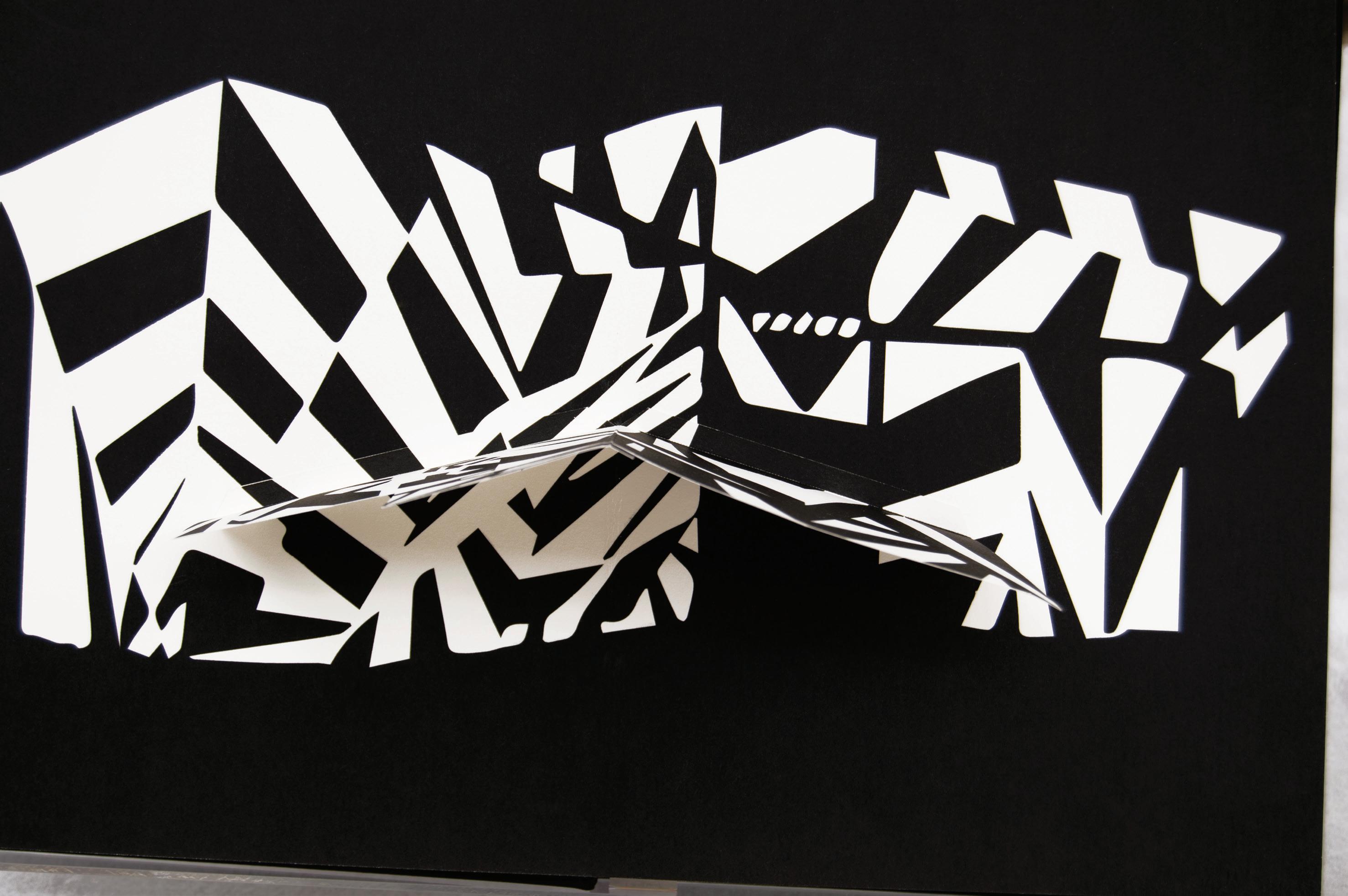




We

Over one hundred years ago a fundraising campaign was launched by the Witwatersrand University Committee to establish an institution of higher learning in the burgeoning mining town of Johannesburg. According to the late historian Professor Bruce Murray in his book Wits: The Early Years, the committee solicited donations in 1917 and 1919. A sum of 171 000 pounds (about R200m in today’s money) was raised from individual donors, local municipalities, mining houses, and two major banks.
A century later, Wits University is a flourishing, research-intensive institution with over 2 000 academic staff, currently providing under- and postgraduate study to about 38 000 students. Since its inception, the University has produced over 180 000 graduates who can be found making their mark throughout the world. Four Wits alumni have won the Nobel prize and Wits has been ranked 54th in the world and the top university in Africa for alumni success by the Times Higher Education (THE) Alma Mater Index in 2017.
Over the past decade, Wits has achieved exceptional success in global assessments of higher education institutions. It has regularly been ranked among the top 1% of the world’s universities, most recently in the THE World University Rankings announced in September 2019, where Wits is ranked at #194.
According to Wits: The Early Years, the 1917 fundraising committee
envisaged “a ‘democratic’ university offering a ladder upwards to the sons of the poor. A university in Johannesburg would offer a university education to many thousands of young men and women who would otherwise be unable to afford it.”
While these noble sentiments were expressed and implemented in the context of racial segregation, today this vision is being realised for new generations of students where almost 50% of our students are first-generation university students; 56% are black women; and 48% of undergraduates are from township or rural locations.
The University’s Vice-Chancellor, Professor Adam Habib, is confident that the enviable academic reputation Wits has established over the past century, together with its contribution to society and its commitment to address inequality, will inspire alumni and others to support the University’s centenary campaign.
At the turn of the century, the idea of Wits was nurtured through a fundraising campaign. That vision was realised. Today the beneficiaries of a Wits education can ensure that Wits retains its place as one of the world’s great universities and strengthens the impact it has on society for the next hundred years by supporting the centenary campaign. To find out how you can support the campaign, go to www.wits.ac.za/givingtowits/ wits-centenary
Peter Maher Director: Alumni Relations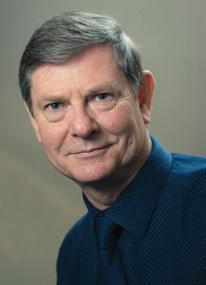
TODAY THE BENEFICIARIES OF A WITS EDUCATION CAN ENSURE THAT WITS RETAINS ITS PLACE AS ONE OF THE WORLD’S GREAT UNIVERSITIES
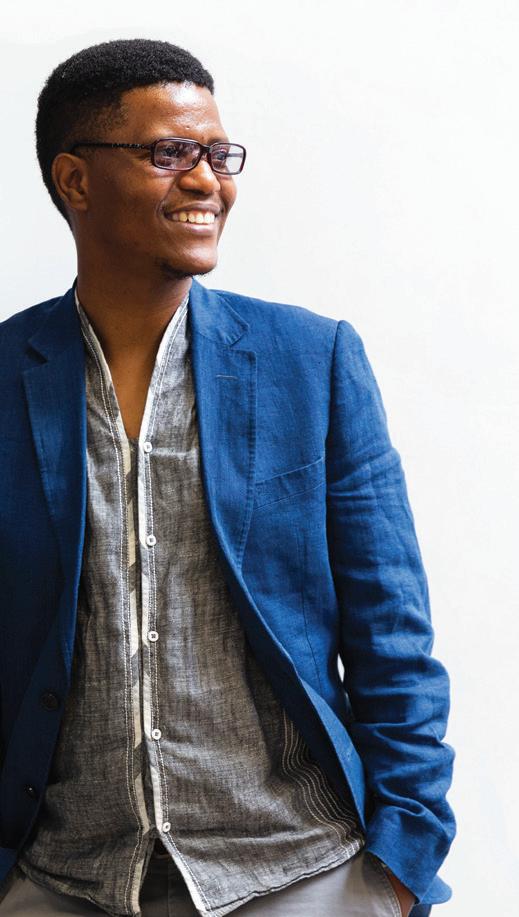

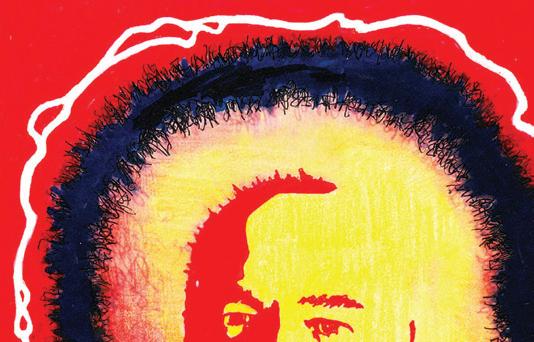
with Wits University have long been known for graffiti and street art.
38 Mpumi Madisa
Her appointment as Bidvest CEO makes her the first black woman to head a Johannesburg Stock Exchange Top 40 company.
42 Franco Frescura
The student satirist got right up the nostrils of the apartheid government in the 1970s.
52 Jack Ginsberg Centre for Book Arts
Part obsession, part magic – that about sums up the collection of artists’ books that has been nurtured by philanthropist Jack Ginsberg and now donated to Wits.
68 Graffiti
Braamfontein and other suburbs that touch sides
Page from The Be Careful Pop-up Book. If You Look Hard Enough You Can See Your Future, by Stephen Hobbs.
The artist Stephen Hobbs (BAFA Hons 1994) uses camouflage to comment on the planning of urban environments and the way people are separated and marginalised by spaces. He has said that “South Africa is still structured like a war zone”. The black and white “dazzle” pattern featured on our cover is a theme in his work and was a technique first used on gunships in World War I to confuse the enemy.
See feature on the Jack Ginsberg Centre for Book Arts, pages 52-57. Photo by Lyrr Thurston
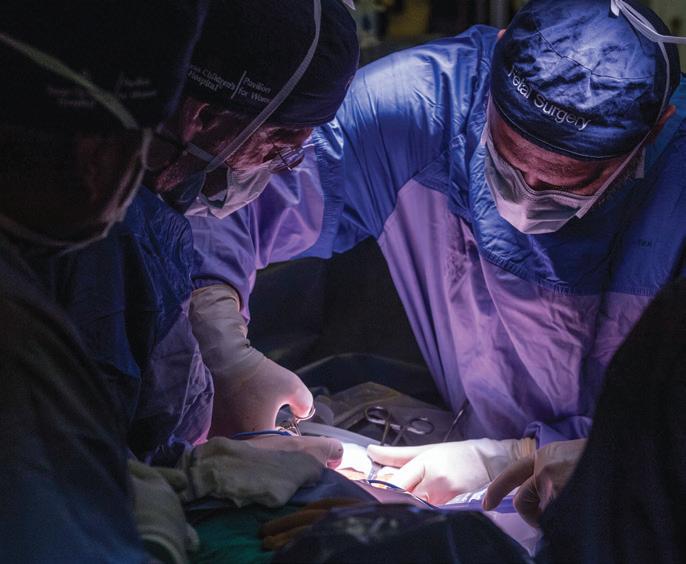
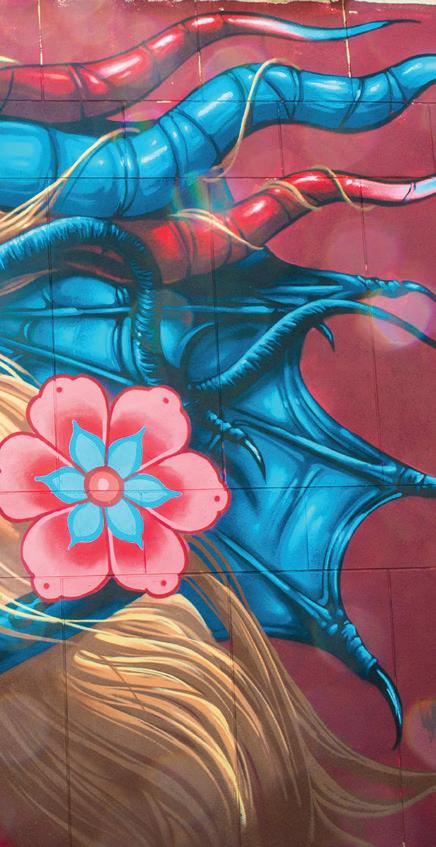

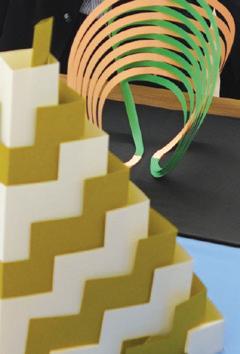
EDITOR
Peter Maher (peter.maher@wits.ac.za)
CONTRIBUTORS
Heather Dugmore (heather@icon.co.za)
Lyrr Thurston (lyrr.thurston@wits.ac.za)
Ufrieda Ho (ufrieda@gmail.com)
GRAPHIC DESIGN
Jignasa Diar (jignasa.diar@wits.ac.za)
PRINTING Remata
Published by the Office of Alumni Relations, University of the Witwatersrand, Johannesburg. Address: Private Bag 3, Wits, 2050, South Africa, T +27 (0)11 717 1090 E alumni@wits.ac.za, www.wits.ac.za/alumni
UPDATE CONTACT DETAILS: www.wits.ac.za/alumni/updateyourdetails
SUBSCRIPTIONS per copy: South Africa R25 (incl. VAT & postage) International R50 (incl. postage)
PAYMENT OPTIONS:
Online payment using a Visa, Mastercard, American Express or Diners Club credit card at: www.wits.ac.za/alumni/payment or by electronic transfer or bank deposit to: First National Bank, Account No. 62077141580, Branch Code 255-005, Ref.No. 29613 (+ your name) or by cash or credit card payment at the Alumni Office.
WITSReview is published twice a year. The views expressed in this publication are not necessarily those of the editor, the Office of Alumni Relations or of the University of the Witwatersrand. ©Copyright of all material in this publication is vested in the authors thereof. Requests to reproduce any of the material should be directed to the editor.

Stay in touch: Please share your news and remember to update your contact details. Help us to keep in touch with all our older alumni if they don’t have email addresses or social media accounts. Please email letters to peter.maher@wits.ac.za.
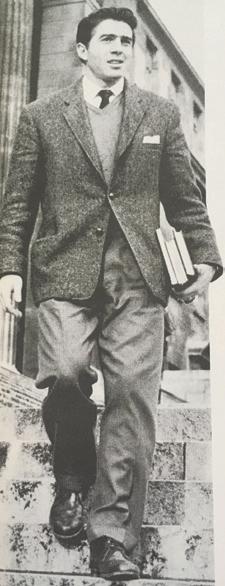
Your magazine has been for many years a source of great news, especially the obituaries section. At my age (80) this news becomes, sad to say, more relevant. What a great community has emerged from this famous institution.
Wilf Rosenberg ( Wits Review April 2019) was a good friend. He was four years ahead of me at Jeppe but I caught up with him in second year Medicine. Pericles Menoff, the Johannesburg Hospital physician, seemed to favour exsportsmen to do internships in his wards.
“Foxy” (Michael) Bernstein (MBBCh 1961) and I worked together as interns for Pericles. What a blast those six months were! Foxy was a likeable rogue who had been an Israeli paratrooper. He loved his rugby and played many a game for Transvaal. Front row “dirty tricks” were all in a day’s work, as was being the team “hit man” when playing for Wits against Police, Vereeniging and even the English Wanderers.
Lenny Seimon (WR April 2019) I assisted in Durban many times when he operated on our practice’s patients. I found him to be a lot like “Foxy”. He was still playing Durban league water polo, where he said all he did was float around just a yard or two from the opposition goalkeeper – imagine the fear generated by this. All his team had to do was pop
the ball up to him and he blasted it into the net with or without the goalie hanging onto it!
Simmy Friedman (MBBCh 1954), a previous Rag cheer leader, was one of my rogue friends. Walking along the main street in Hillbrow with Simmy was like living a Damon Runyon story. All these shady guys with their two-tone shoes would say “hi doc” as we walked past. The snooker saloon was next to Resdoc so we spent many hours there, where all Simmy’s pals hung out. Jockeys, race horse trainers and even the guy who shot Sea Cottage were regular clients.
John Read (MBBCh 1961), Port Elizabeth
The article about the swimming pool (WR April 2019) brought vivid recollections of “swot leave” spent at the pool, and Mira Fassler (BArch 1961) practising diving, looking amazing in a white swim suit. Anneliese (Konig) Stewart (BArch 1959)
The feature on the Wits swimming pool evoked special memories for us, particularly the “amphitheatre-like” description of the pool. I vividly recall sitting in that amphitheatre in 1974, after a lunch of “slap chips” and gravy in the canteen, and proposing to one of my
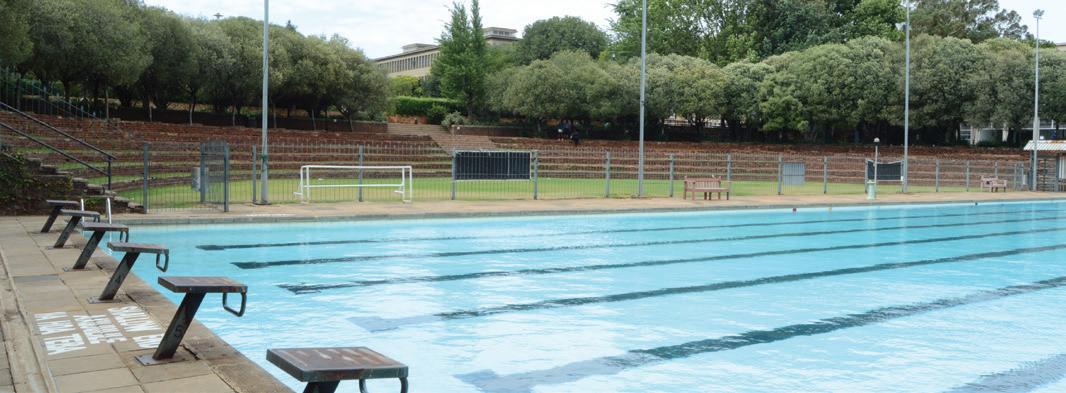

Economics classmates, Jean MacLennan (BCom 1975, CTA 1978). We were subsequently married in the Holy Trinity Catholic Church in Braamfontein in 1976, a “lifetime” of 43 years ago. John McCartney (BA 1976, LLB 1978), Castle Hill, Australia

I must congratulate you on the latest superb edition of the Wits Review (April 2019). Beautifully laid out, filled with articles of immense interest and covering a plethora of topics.
I have always been proud, as a Wits alumna, of the special status I am privileged to share with so many erudite Wits alumni; and I continue to be amazed at the strides so many of them have made both here and overseas. South Africans, and especially Witsies, are acknowledged to be among the most hard-working and successful emigrants to many countries abroad, setting excellent examples and gaining respect wherever they work.
I do admit, though, to being slightly apprehensive about the future of some of today’s young students. While radical behaviour and maverick opinions are characteristic of students around the world, the very violent and tempestuous actions that are taken on the campus don’t, in my mind, augur well either for their own paths to success or for the
reputation of Wits. I was taught that higher education is a privilege and not a right; but that does not seem to be the case today.
I graduated with a BA Hons in African Government and my son Greg Falkof received his Wits Building Science degree in 1996. He subsequently studied law and is a partner at Eversheds Sutherland in London. My daughter Nicky Falkof is Associate Professor in the Department of Media Studies at Wits. Bev (Saffer) Goldman (BA Hons 1970)

Members of the public are welcome to join the Wits Metro Wellness Gym, situated on the Wits Education Campus in St Andrews Road, Parktown. Health professionals are available there to help you get fit and healthy in a friendly, social and supportive environment, especially if you need chronic disease rehabilitation. Email: info@cardiac.wits.ac.za or phone 011 717-3376.
In August 2019, Stacey-Lee Bolon the new President of Wits Convocation for a four-year term. She had served on Convocation’s Executive Committee since 2011 and was elected unopposed to succeed Dr Maurice Goodman, who was Acting President.
Convocation is the statutory body that represents graduates and academic staff in the affairs of the University.
Dr Goodman (MBBCh 1983, MBA 1987) will continue to serve on the Executive Committee of Convocation. Bolon paid tribute to his leadership and loyal service, saying: “Maurice has been a long-standing and dedicated member of Exco. He led the team through an important time in the education sector where his guidance was always aimed at finding common ground and constructive solutions.”
Bolon is an industrial psychologist and has earned several degrees from Wits: BA in Human Movement Science (2007), BA Hons in General Psychology (2008), BA Hons in Industrial Psychology (2009), and MA in Industrial Psychology (2010).
She is the Innovations Manager for FNB’s Business Banking Division and the managing director
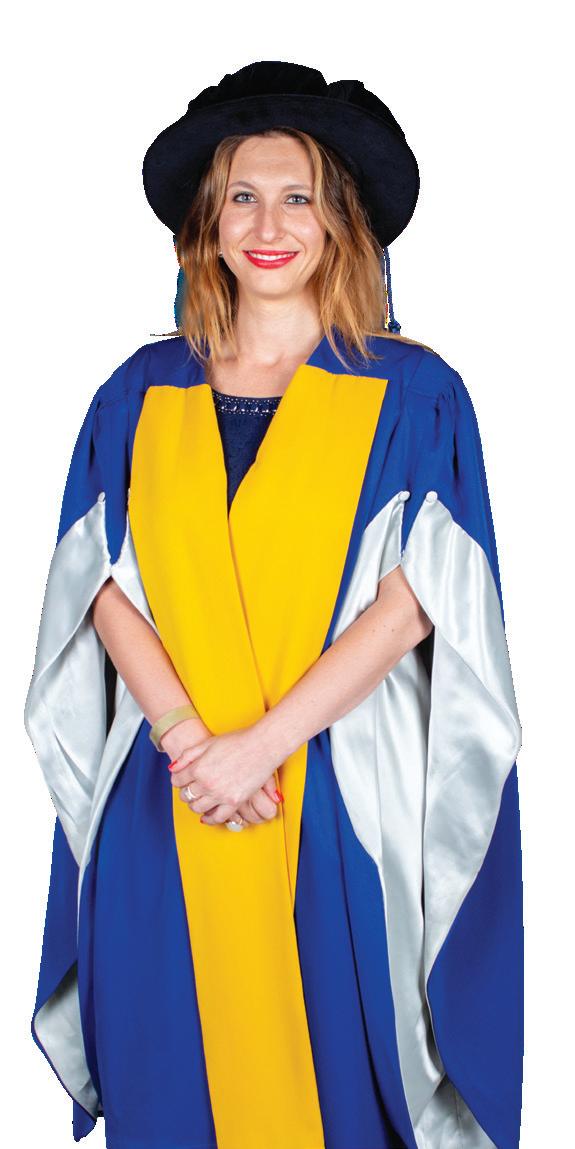
of an education technology start-up called Early is Best, which aims to improve access to early childhood education. She is also a director of Venture Network, a non-profit company which connects entrepreneurs and investors.
She is passionate about preparing people to participate in the digital economy.
“South Africa needs to become the generator of more disruptive thoughtleadership and innovation; and I believe this will be done through a shift in mindset by those who set the academic agenda.
“The University has an exceptional leadership and management team who are committed to the evolution of our education system. We are on the brink of something great!”


T he first solar district heating plant in sub-Saharan Africa was launched at Wits in May. It’s a system to heat an average of 94 000 litres of water daily for the needs of 1 103 students at 14 buildings at the Wits Junction residence cluster in Parktown. The solar layout is centralised on one roof and the water is heated in one plant room. The system combines solar, co-generation and gas heating technologies and is expected to save about R40-million over the next 20 years. The project was part of an internationally funded initiative to build capacity and demonstrate solar thermal systems in the Southern African Development Community region.


Wits sent three sportsmen to the 2019 Summer Universiade (aka World University Games ) in Napoli, Italy in July: footballers Saluleko Mathonsi and Kurt Pienaar and rugby player David Cary. The Rugby Sevens team took silver.
Witsie David Cary in the final against Japan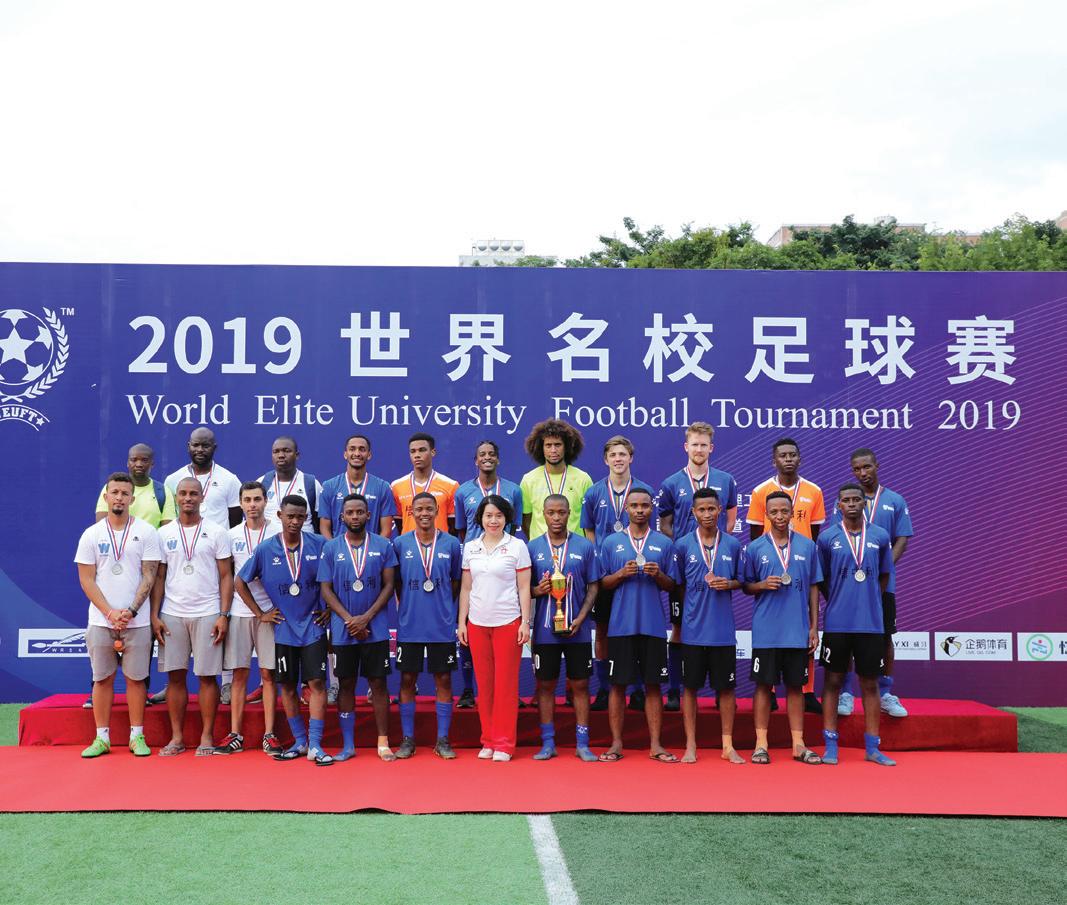

The Wits men’s hockey side won the A section of the University Sports South Africa tournament in July. The Wits women’s team won all their games and achieved promotion to the A section.
Wits vs Madibaz Image: Varsity Hockey Wits Football Club
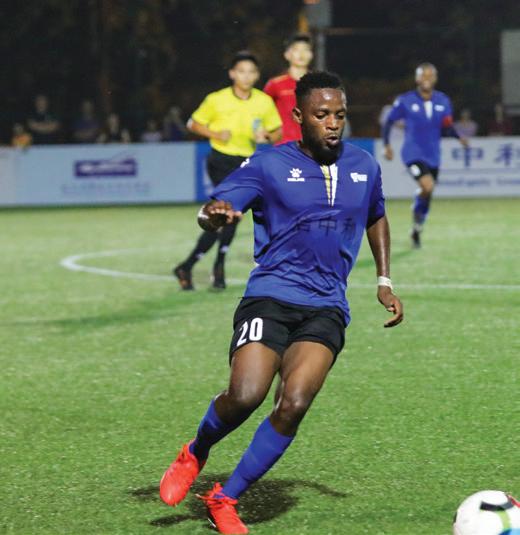

Wits won silver at the World Elite University Football Tournament in Guangzhou, China in July. The team was the first from Africa to enter this competition. Thato Gopane was named Most Exciting Player of the Tournament and Matthew Carelse Goalkeeper of the Tournament. Mahle Mtabane and Richard Moremi made the Team of the Tournament.
Thato Gopane Images: #WEUFT Above: Witsie Clinton Mphahlele (left) in the final against the University of Tübingen. Left: Keamogetswe Mokalake
Prof Ivor Sarakinsky, from the Wits School of Governance, and Lumkile Mondi (above) , from the School of Economic and Business Sciences, were guest speakers at an alumni networking event held at the Wits Club on 11 April 2019 to discuss South Africa’s elections and economy. The discussion was facilitated by Prof Anthoni Van Nieuwkerk, also of the School of Governance.
Pics: www.flickr.com/photos/witsalumni/albums
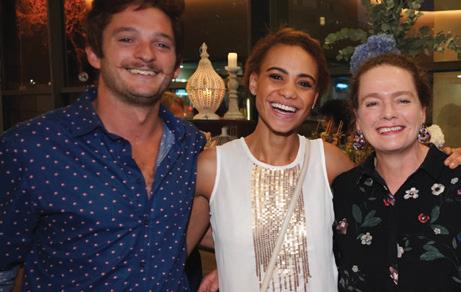
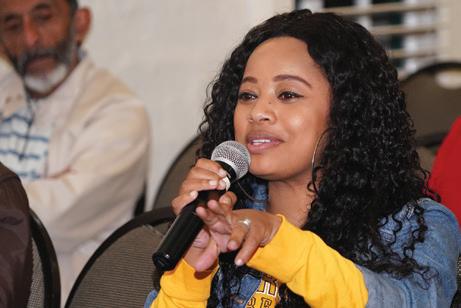
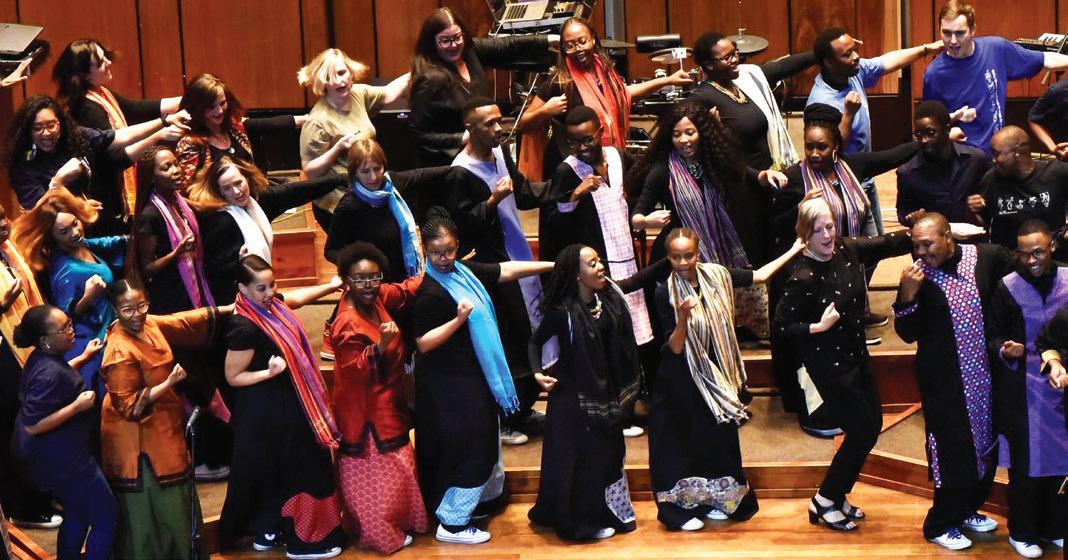 Dalene
Dalene
www.wits.ac.za/alumni/updateyourdetails/


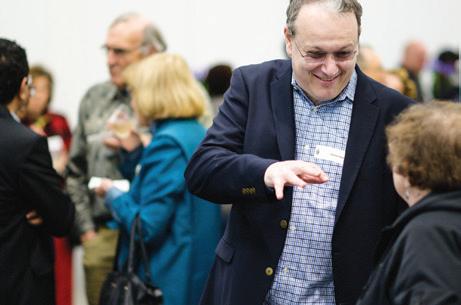

Phillipa Geard (above) was the guest speaker at a careers event for Wits students and alumni on 16 July 2019. The award-winning founder of RecruitMyMom and RecruitAGraduate spoke about her own journey as an entrepreneur and shared some advice on running a business. This included learning all the time from experiences and from other people; asking for help; being resilient; broadening your horizons; leading by example; and basing your enterprise on values.
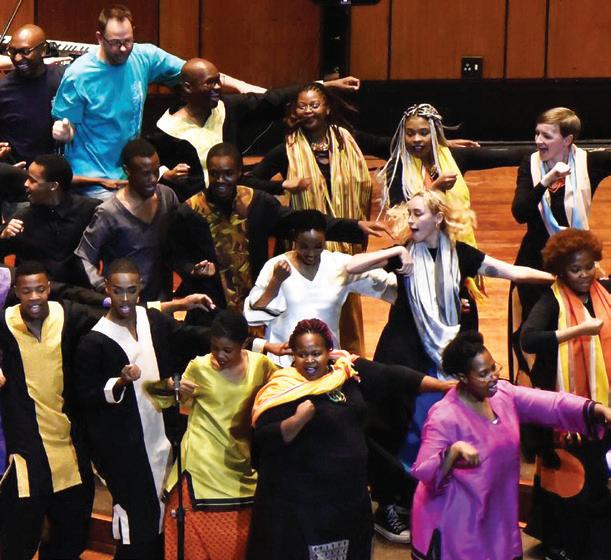
Be sure to update your details so you can get invited to our exciting and informative networking events
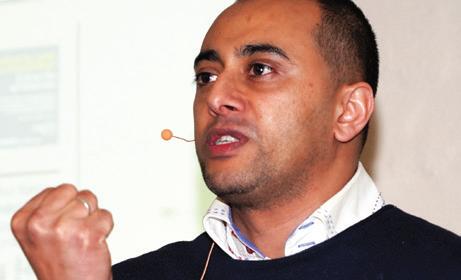
Corporate strategist and thought leader Abdullah Verachia (above) gave an inspiring presentation to alumni at a networking event held at the Wits Club complex on 25 June 2019. The Wits Master of Management graduate spoke about disruption and Africa’s future. Wits graduates have a responsibility to work hard to make the society they want to live in, he said.
This year the Wits Choir celebrated 25 years under the direction of Dalene Hoogenhout (BMus Ed 1985). Over the years, the choir has shared the music of Africa through many tours and outreach projects, and performed at numerous important official functions and Wits events. Wits Choir Alumni have their own Facebook group (see www.facebook. com/witschoir/ ) and Friends of the Wits Choir get the benefit of direct booking for performances: friends@witschoir.co.za.
Left: 25th celebration concert; Dalene (centre)

A large number of alumni attended a New York reunion held in Manhattan in May 2019. The Chairman of the Wits Fund, Stanley Bergman, and the President, John Teeger, spoke about the Fund’s work to enable Wits University to maintain its high standards. Alumnus Dr Ali Bacher described how Wits had prepared him for his service to the game of cricket. Vice-Chancellor Adam Habib spoke about Wits’ efforts to address inequality and plans for the University’s centenary in 2022. Pics: www.facebook.com/pg/witsinamerica/photos/
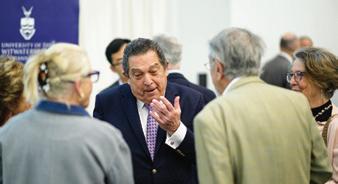
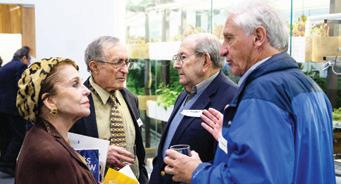
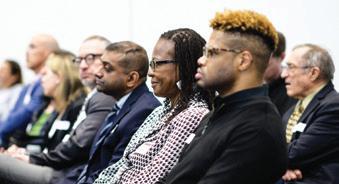
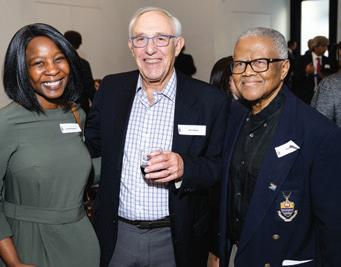
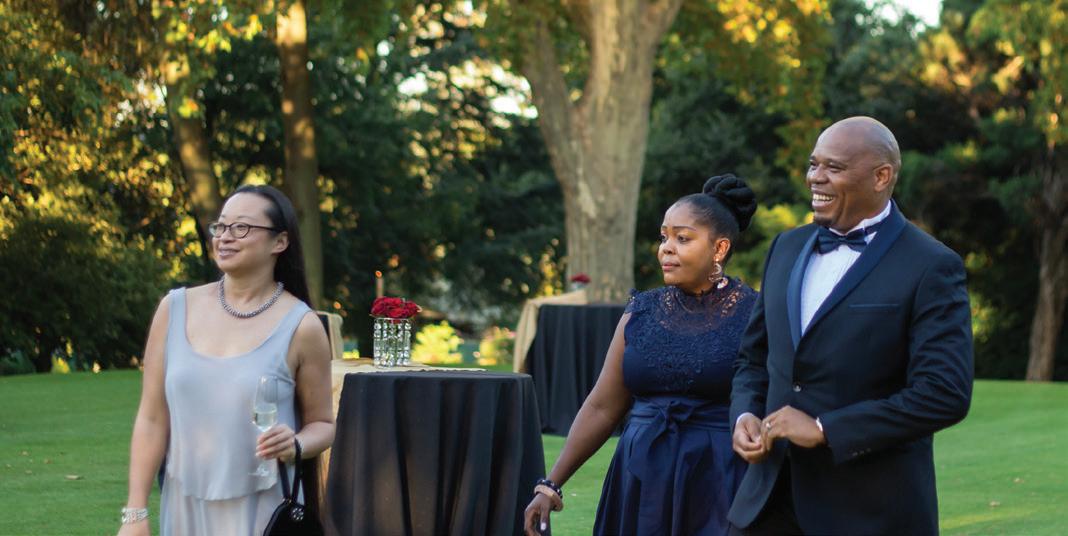
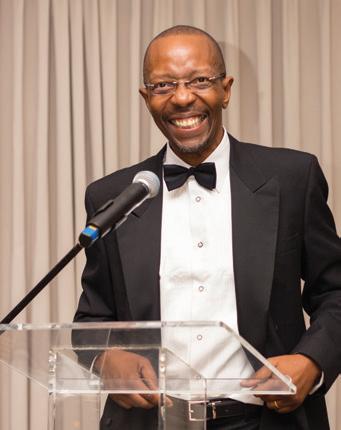
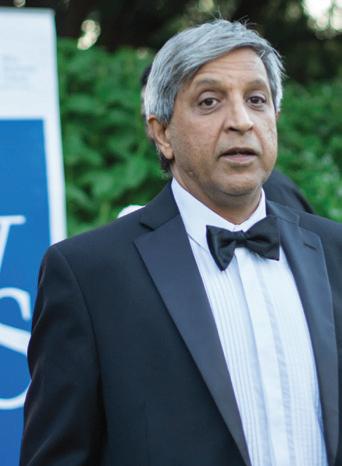
Wits Business School (www.wbs.ac.za) celebrated its 50th anniversary in 2018 with special publications and events, culminating in a gala dinner at the Johannesburg Country Club early in 2019. Alumni, faculty, friends of WBS and other special guests enjoyed drinks in the beautiful gardens of the club, followed by an elegant dinner and entertainment. The evening was hosted by Vice-Chancellor Professor Adam Habib and Head of WBS Dr Sibusiso Sibisi. Chancellor and WBS alumna Dr Judy Dlamini (MBA 1999) delivered the keynote address.
Clockwise from top: Melissa Lai, Mankwe Llale, Setumo Llale, Prof Imraan Valodia, Peter Bezuidenhoudt, Maurice Radebe, Nhlanhla Nene, Prof Adam Habib and Dr Sibusiso Sibisi
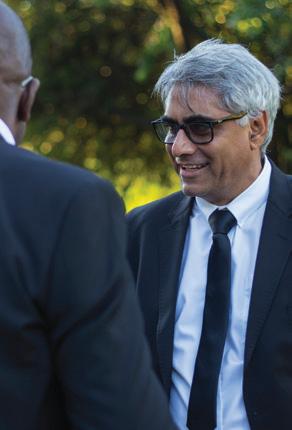
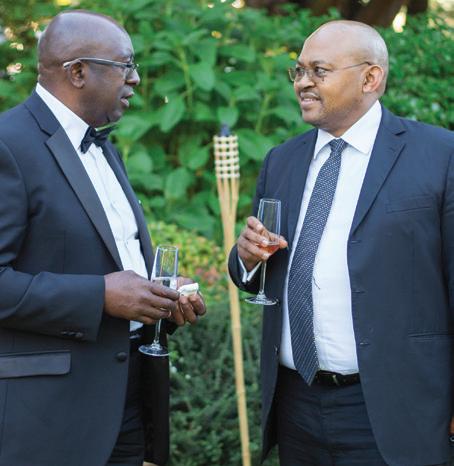
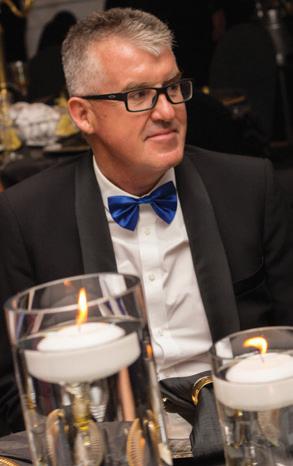
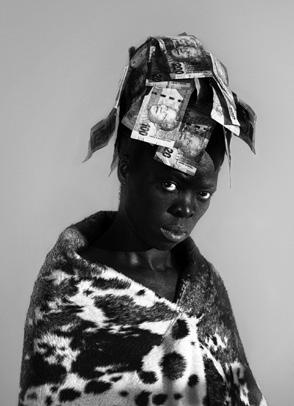

A group of Witsies in Seattle got together at the Seattle Art Museum on 22 August to see an exhibition of work by South African activist photographer Zanele Muholi. The artist is a fellow of the Wits Institute for Social and Economic Research. After a visit guided by curator Pam McClusky, the alumni enjoyed drinks at the nearby Four Seasons Hotel with Wits US representative Nooshin Erfani-Ghadimi.
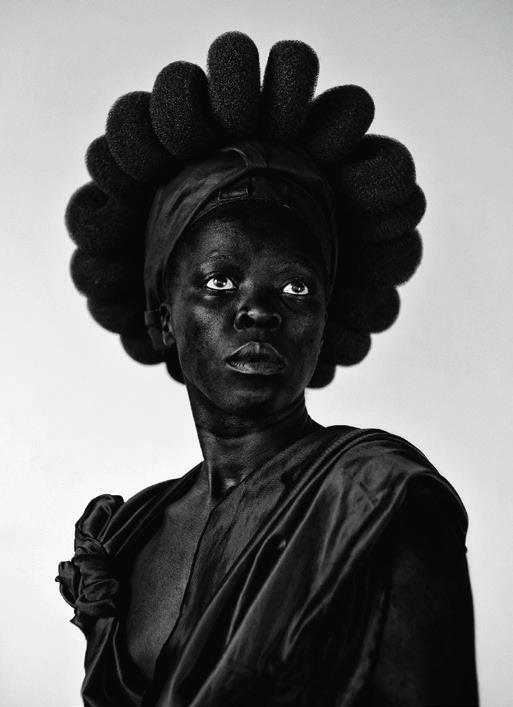
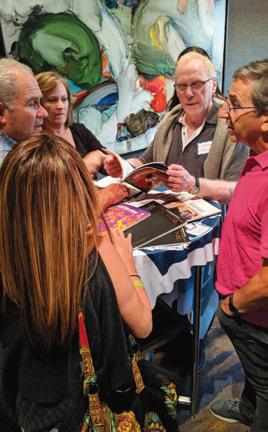


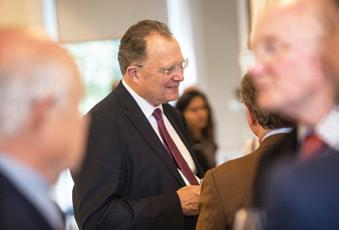
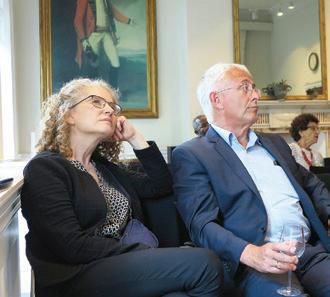

Marking 100 Years of Teaching Excellence, the Health Sciences Faculty held alumni reunions in Australia (March) and the UK (June). Images: Orde Eliason
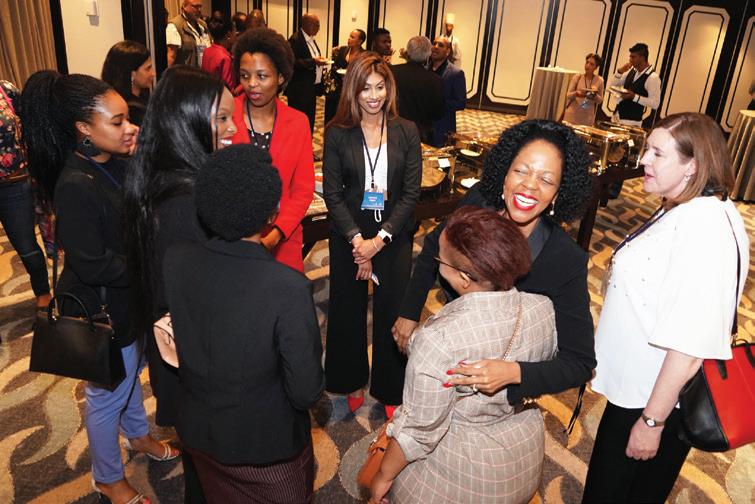
Alumni got together in Durban in April 2019 and Cape Town in September to meet Chancellor Judy Dlamini and Vice-Chancellor Adam Habib, catch up on Wits news, renew friendships and share memories. Pics: www.flickr.com/photos/witsalumni/albums
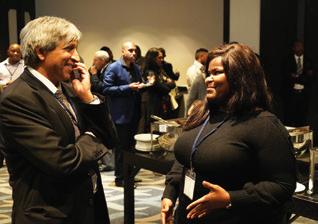
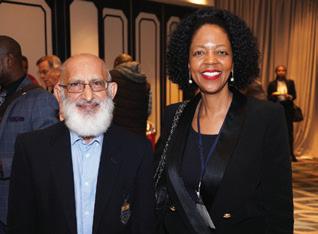

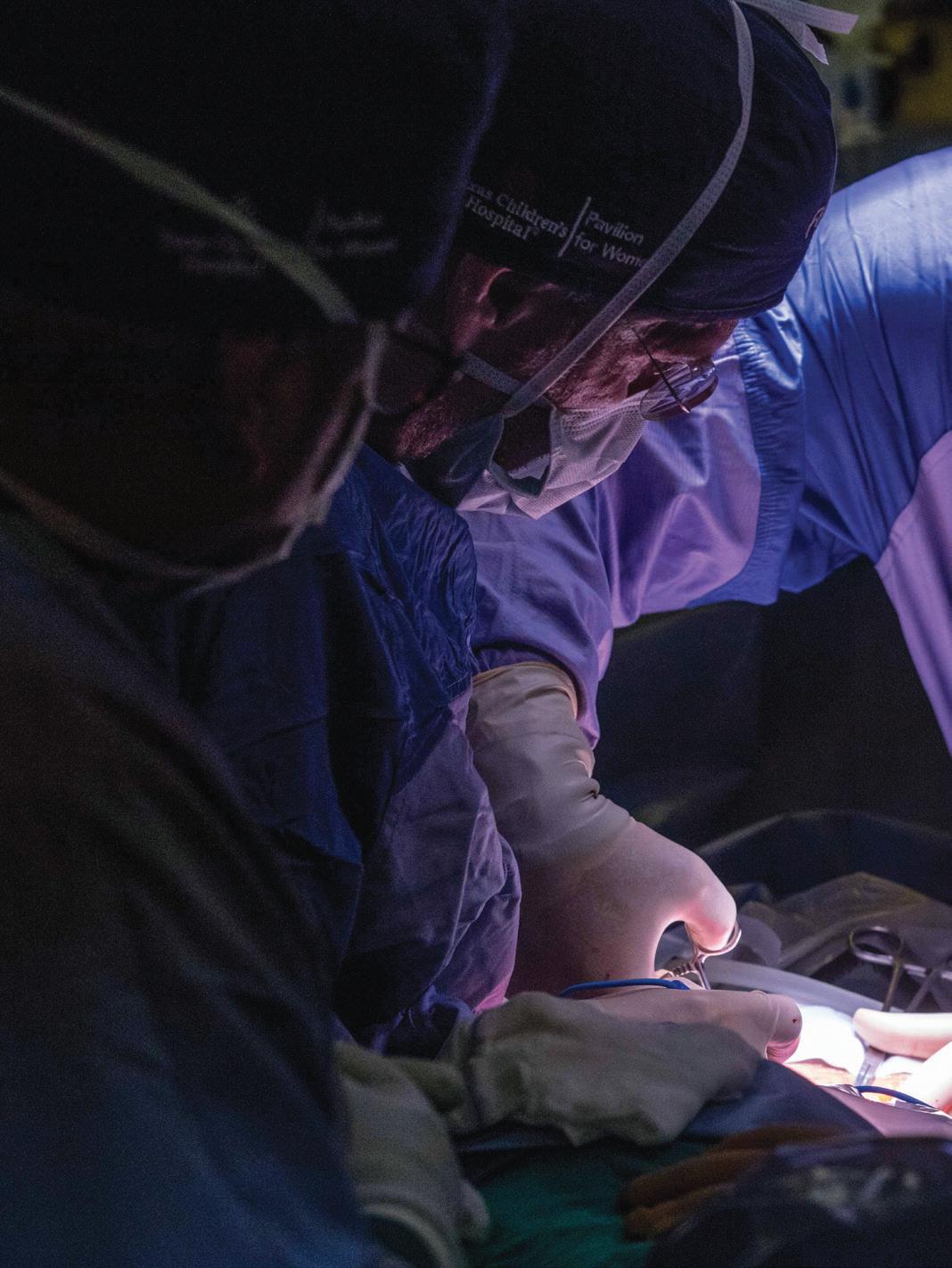

AFRICAN SURGICAL HISTORY WAS MADE THIS YEAR WHEN A 24-WEEKOLD FOETUS UNDERWENT SURGERY FOR SPINA BIFIDA IN JOHANNESBURG
›
Images: MediclinicMike Belfort (MBBCh 1981), Baylor College of Medicine Professor and Obstetrician and Gynaecologist-in-Chief of Texas Children's Hospital, brought a team of foetal surgery experts to work with Professor Ermos Nicolaou, Academic Head: Wits Maternal and Foetal Medicine Centre and Mediclinic Morningside. Together they carried out this particular operation for the first time on the continent. Prof Belfort is a pioneer in foetal spina bifida surgery in the US and has participated in the Carnegie-Wits Alumni Diaspora Programme, which brings internationally renowned Health Sciences alumni back to Wits to build research collaborations and networks.
The operation involved inserting tiny ports into the mother’s uterus and covering the exposed area of the foetus’s spine with a membrane, then closing the skin to prevent damage to the nerves from contact with the amniotic fluid. Thirteen weeks later the baby was safely delivered and the hospital reported that the “surgery appears to have been a huge success”.
There are about 1000 cases of neural tube defects every year in SA. The surgical team also hopes to be able to perform in utero surgery for other kinds of abnormalities that might otherwise result in death or severe handicap.
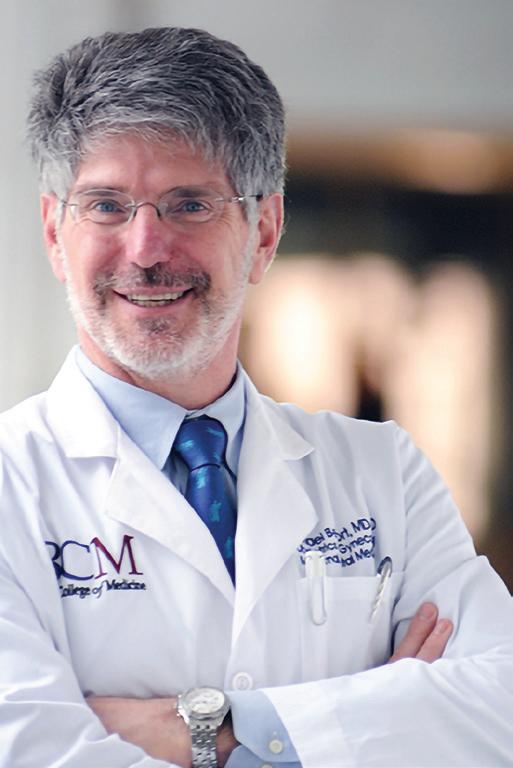
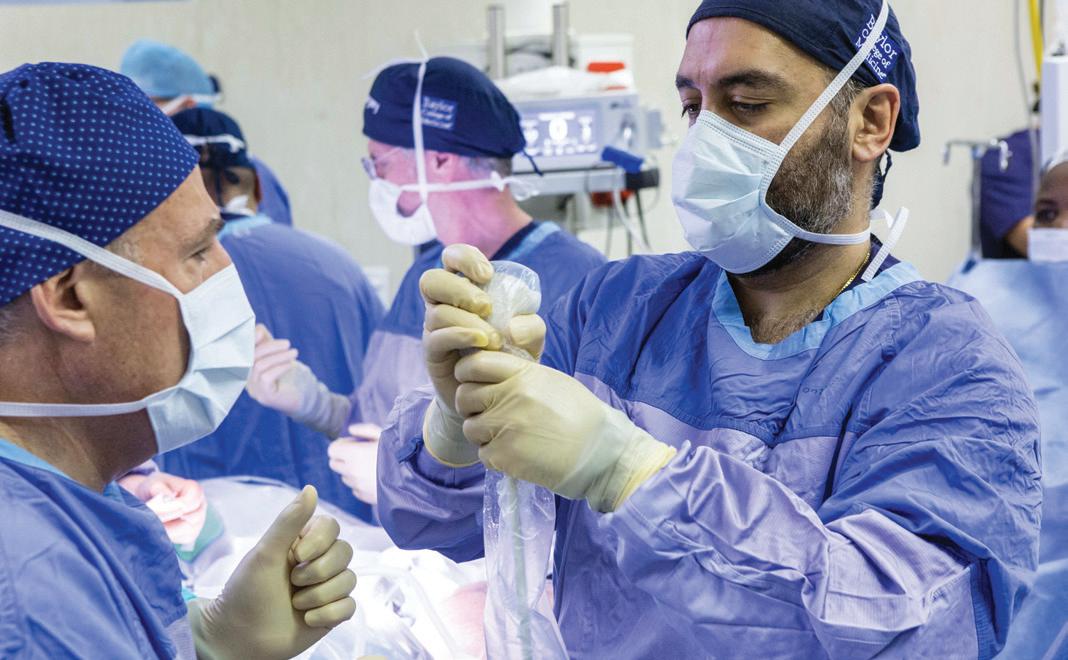
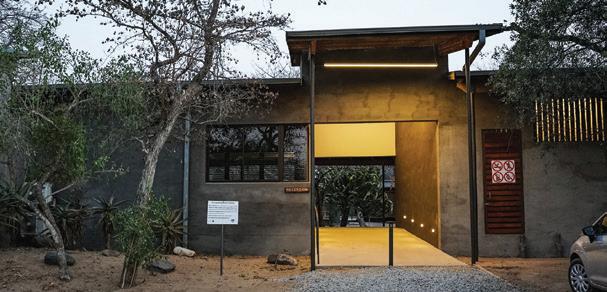
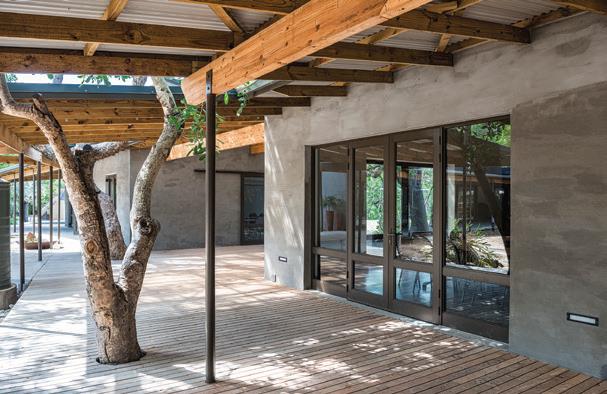
Architect Kate Otten (BArch 1987) led the 2016 upgrade of the Wits Rural Facility, which won first prize in the tourist facilities category of the 2019 International Baku Architecture Awards. These awards give special attention to places of heritage and historical significance, and in this case the natural environment is the heritage resource.
Wits’ Lowveld campus provides a space for teaching and research, as well as affordable conference accommodation near tourist attractions such as the Kruger Park. Otten said the judges were impressed by the facility’s respect for the natural environment. “Choice of materials, use of available skills, passive climate control, rainwater collection and sewage purification are all employed with a view to economic, social and environmental sustainability.”
The Wits Rural Facility celebrated its 30th anniversary in September and launched the Wits Rural Knowledge Hub.
Alumni can take advantage of the facility for conferences and personal travel. Enquiries: info.witsrural@wits.ac.za.
Images: Graham De Lacey / Lauren Mulligan
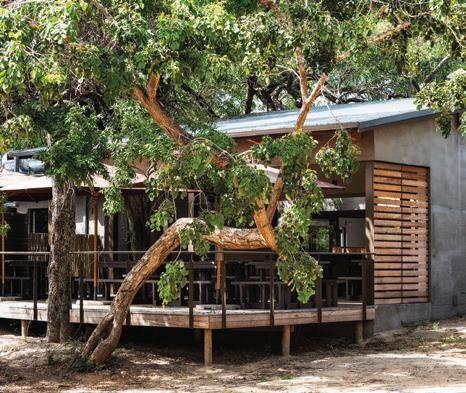


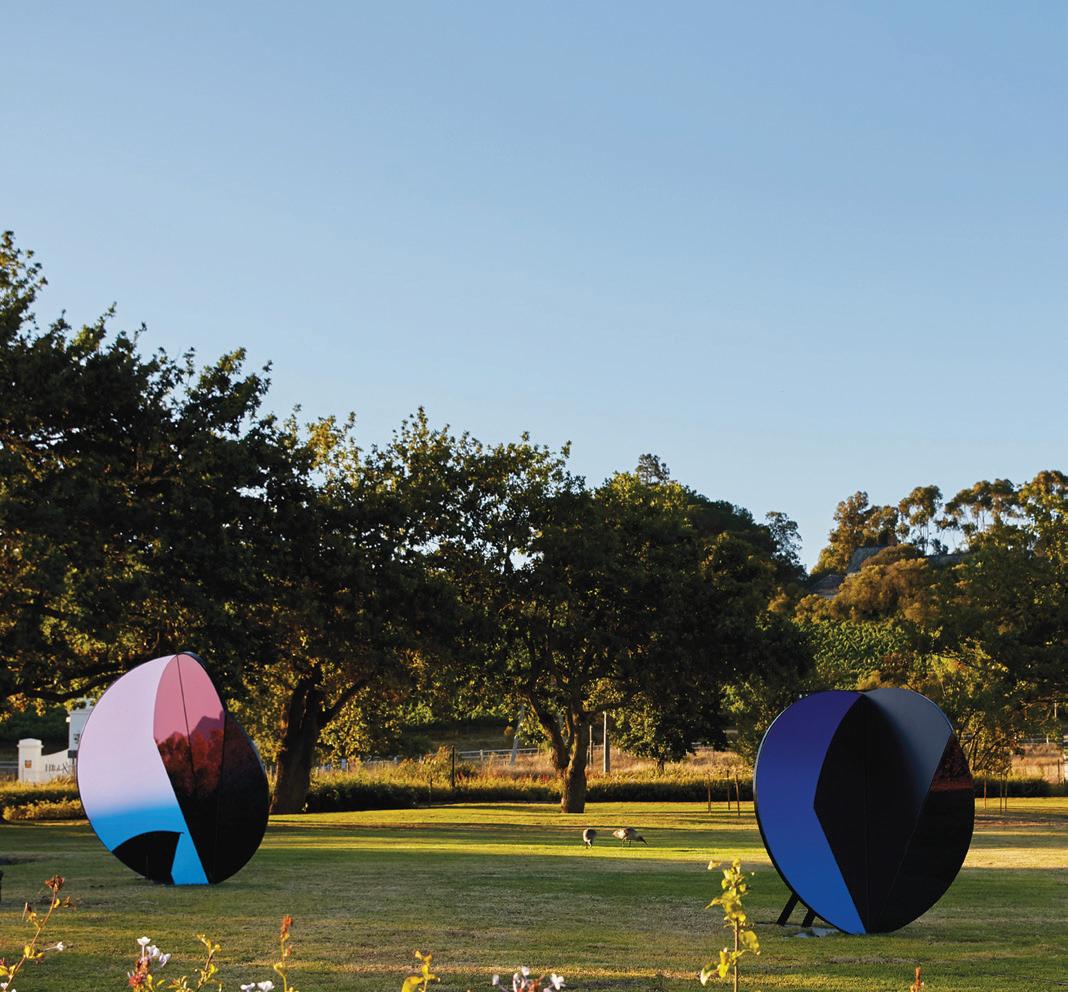
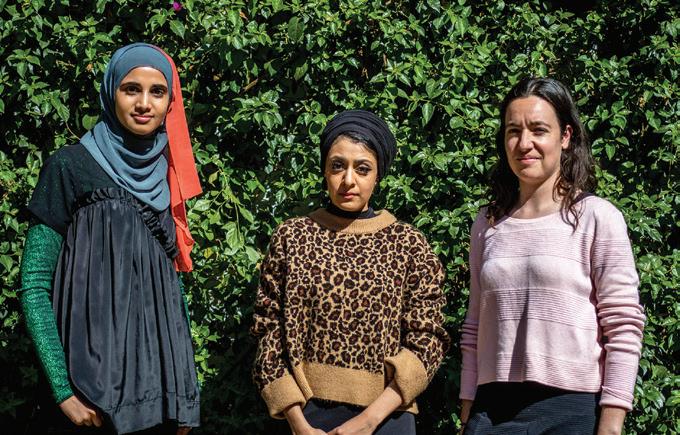
 Play Africa Maker
Play Africa Maker
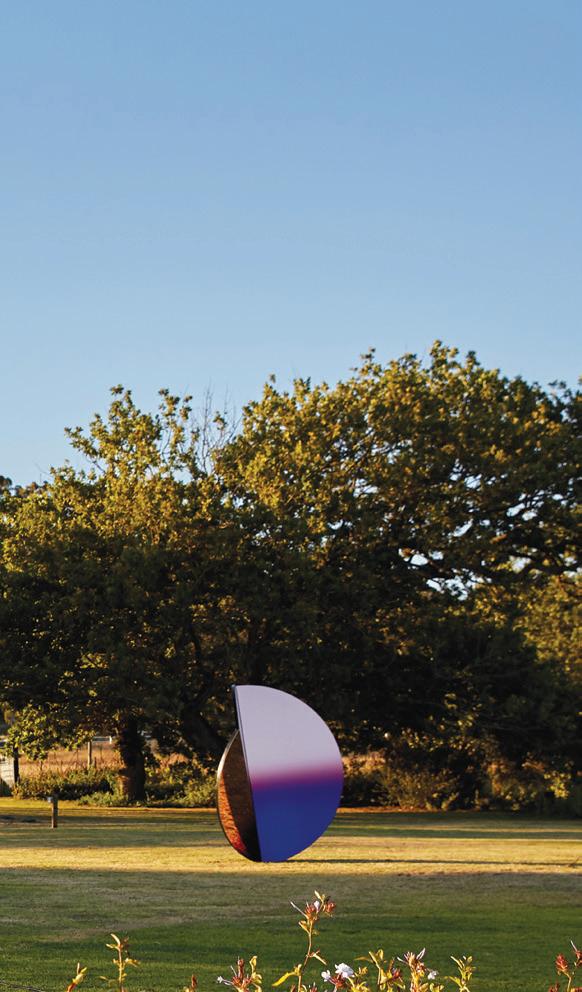

Counterspace, an architectural studio run by three Witsies, was one of only two African firms in Domus magazine’s 2019 list of the world’s most innovative architecture practices. Amina Kaskar (BAS 2012, BAS Hons 2014, MArch Prof 2015), Sumayya Vally (BAS Hons 2014, MArch Prof 2015) and Sarah de Villiers (BAS 2012, BAS Hons 2014, MArch Prof 2015) aim to develop “a uniquely Johannesburg and African design language”. Their recent work includes a sculpture installation called Folded Skies, inspired by Johannesburg’s polluted sunsets; and Play Africa Maker, a portable and modular set of materials which children can use to build creatures and settings.

Distinguished architect Herbert Prins (BArch 1952, PDipTP 1973, MArch 1990) received Wits’ Gold Medal in March in recognition of his contribution to heritage preservation and architecture, his professional and academic distinction, and his exceptional contribution and service to society. He practised as an architect, served in the Wits Department of Architecture for 26 years, worked as a heritage consultant and played a key role in the construction of the Constitutional Court. At the age of 91, he continues to energetically contribute to public interest projects.

WINNING THE AFRICA PRIZE IS A MASSIVE ACHIEVEMENT FOR US
Neo Hutiri (MEng 2015) is the first South African to have won the prestigious Africa Prize for Engineering Innovation, founded by the Royal Academy of Engineering in the UK. Hutiri and his team at Technovera, a social impact enterprise, developed Pelebox, a smart locker system designed to dispense medicine to patients with chronic conditions. Healthcare workers place prescription refills into the lockers and the Pelebox technology sends patients a one-time PIN to open the locker. This quick solution (an average of 22 seconds for collection) reduces queues at public healthcare facilities. It also helps track patient compliance.
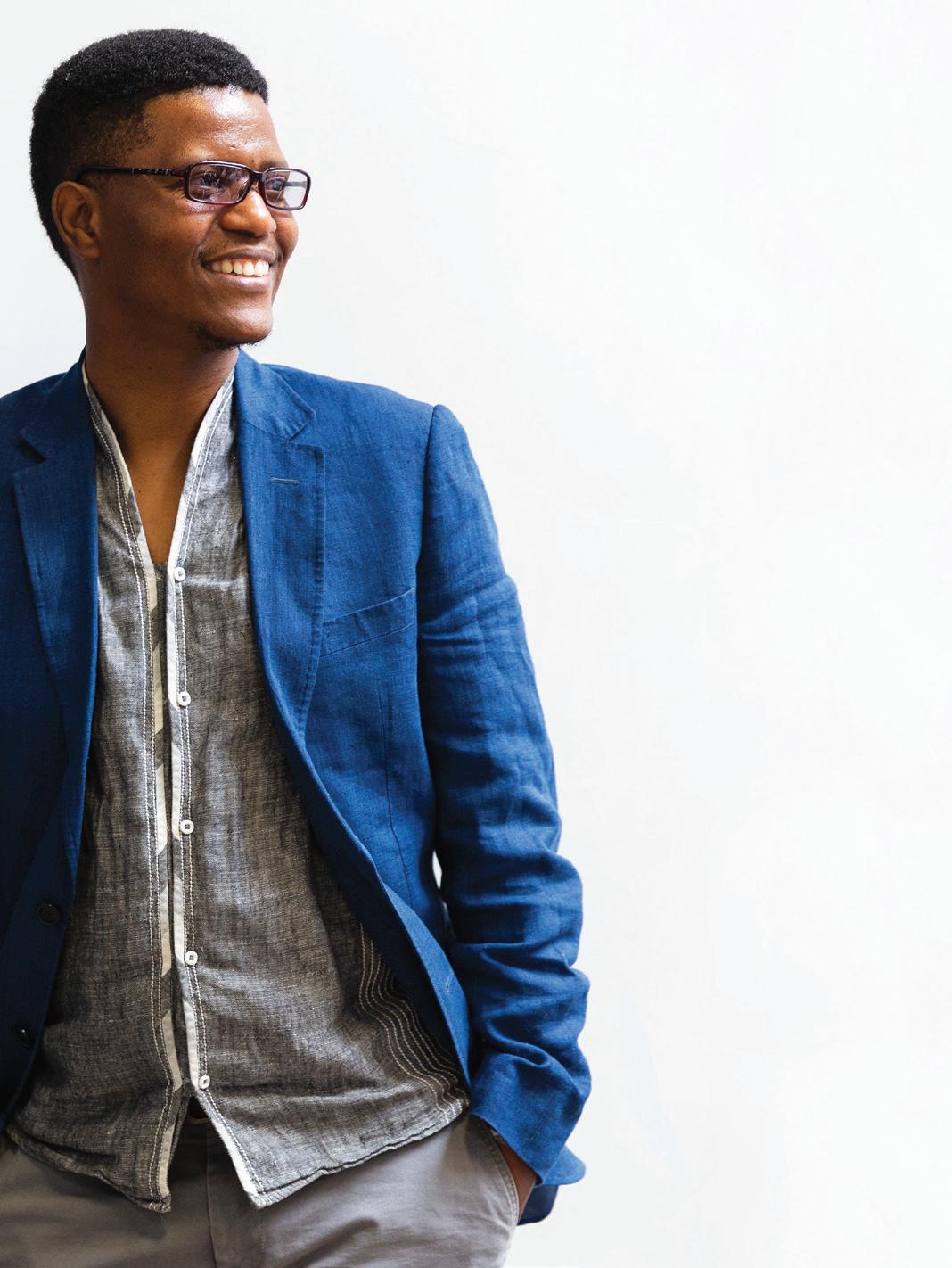

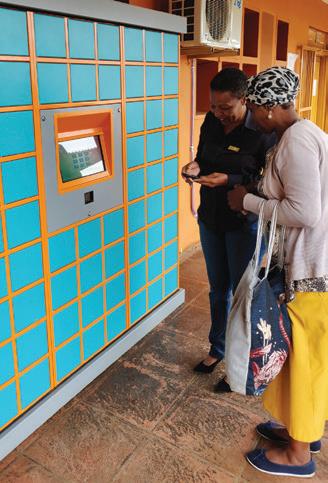
“Winning the Africa Prize is a massive achievement for us,” said Hutiri. “We can now ramp up our manufacturing efforts using the prize money [£25 000]. The networks we are part of will also be instrumental for the growth of our business.”
Hutiri first started thinking about solving the queueing problem when he experienced the long wait at a public clinic for his own TB medication. Pelebox also won the 2016 #HackJozi Challenge and is a member of Wits’ Tshimologong technology precinct.
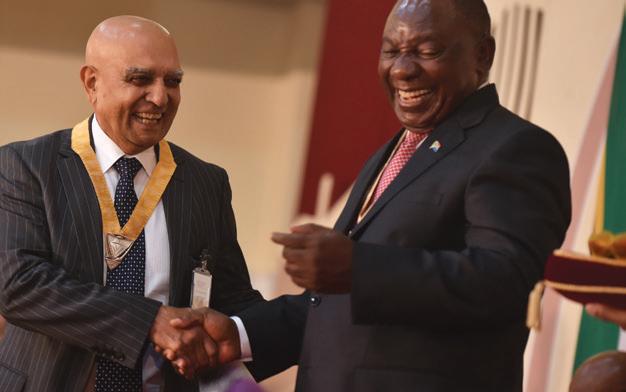

Several Wits alumni received national orders from the Presidency in 2019: veteran journalists Benjamin Pogrund (BA Hons 1971) and Mathatha Tsedu (BA Hons 2008); political activist and government communicator Tony Trew (BA 1963); Emeritus Professor in the Department of Internal Medicine Yosuf (Joe) Veriava (MBBCh 1968); and sociology scholar and dramatist Ari Sitas (BA 1978, BA Hons 1979, PhD 1984). The School of Chemical and Metallurgical Engineering’s Professor Thokozani Majozi also received the Order of Mapungubwe in Bronze for his outstanding contribution to science.
Lyn Wadley (PhD 1987), Honorary Professor in Wits’ Evolutionary Studies Institute, has been made a Fellow of The British Academy for her outstanding contribution to archaeology. She is a pioneering scholar of the African Middle Stone Age and the cognitive abilities of early modern humans. The Royal Society of Chemistry has admitted Professor Roger Sheldon as an honorary fellow for his contributions to biocatalysis, green chemistry and catalytic oxidation. He is an A-rated researcher in Wits’ School of Chemistry.
Patrick Deane (BA 1978, BA Hons 1979) is the new Principal and Vice-Chancellor of Queen’s University in Canada. He was Vice-Principal for five years but most recently served for nine years as President and ViceChancellor of McMaster University, also in Ontario. He majored in English at Wits and completed his PhD at the University of Western Ontario.
Dr Farrell Spiro (MBBCh 1962) received Netcare’s Christiaan Barnard Memorial Award for his contribution and service to medicine.
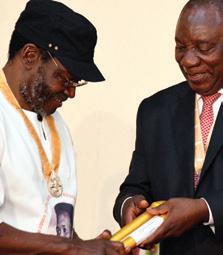

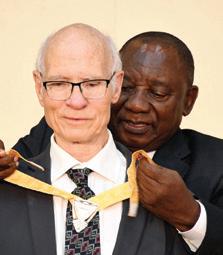
Dr Manyangane Raymond Billa (MSc Med 2010) has been appointed CEO of the Health Professions Council of South Africa, a statutory body which regulates registration, education, training, professional conduct and ethical behaviour in the health professions. Dr Billa’s Wits degree was in bioethics and health law. He was previously CEO of Helen Joseph Hospital in Johannesburg.
Education Professor Emerita Hilary Janks (BA 1970, BA Hons 1971, PDipEd 1972, BA Hons 1987, MA 1989) was the first recipient of the Literacy Association of South Africa’s Significant Contribution to Literacy Award.
Professor Edward Webster (BA Hons 1964, PhD 1983, DLitt honoris causa 2017) is the first recipient of the South African Sociological Association lifetime achievement award.
Professor Michèle Ramsay (PhD 1987), Director of the Sydney Brenner Institute for Molecular Bioscience at Wits, won the Department of Science and Innovation’s Women in Science Award in the category Distinguished Researchers: Natural and Engineering Sciences.
University of Melbourne Emeritus Professor Harold Luntz (BA 1956, LLB 1959), who was a Senior
Lecturer in the Wits Law School from 1962 to 1965, has been made an Officer of the Order of Australia for his “distinguished service to legal education, as an academic and editor, to professional development, and to the community”.
Dr Manny Pohl (BSc Eng 1975, MBA 1977) was appointed as a Member of the Order of Australia (General Division) for service to the finance sector and to the community.
Prof Jean-Marie Kileshye Onema (PhD 2011) has been elected Vice-President of the International Commission of Water Resources Systems of the International Association of Hydrological Sciences. He is the first African to serve in the commission.
The University awarded the degree of DLitt honoris causa to former Independent Electoral Commission chairperson Brigalia Bam, writer Mandla Langa and posthumously to the writer Chris van Wyk in March 2019.
Dr Precious Moloi-Motsepe (MBBCh 1987) has been elected as the new Chancellor of the University of Cape Town, a position that she will take up from 1 January 2020. Dr Moloi-Motsepe is a businesswoman and philanthropist who started her career in medicine.
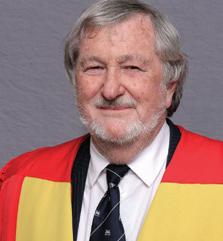



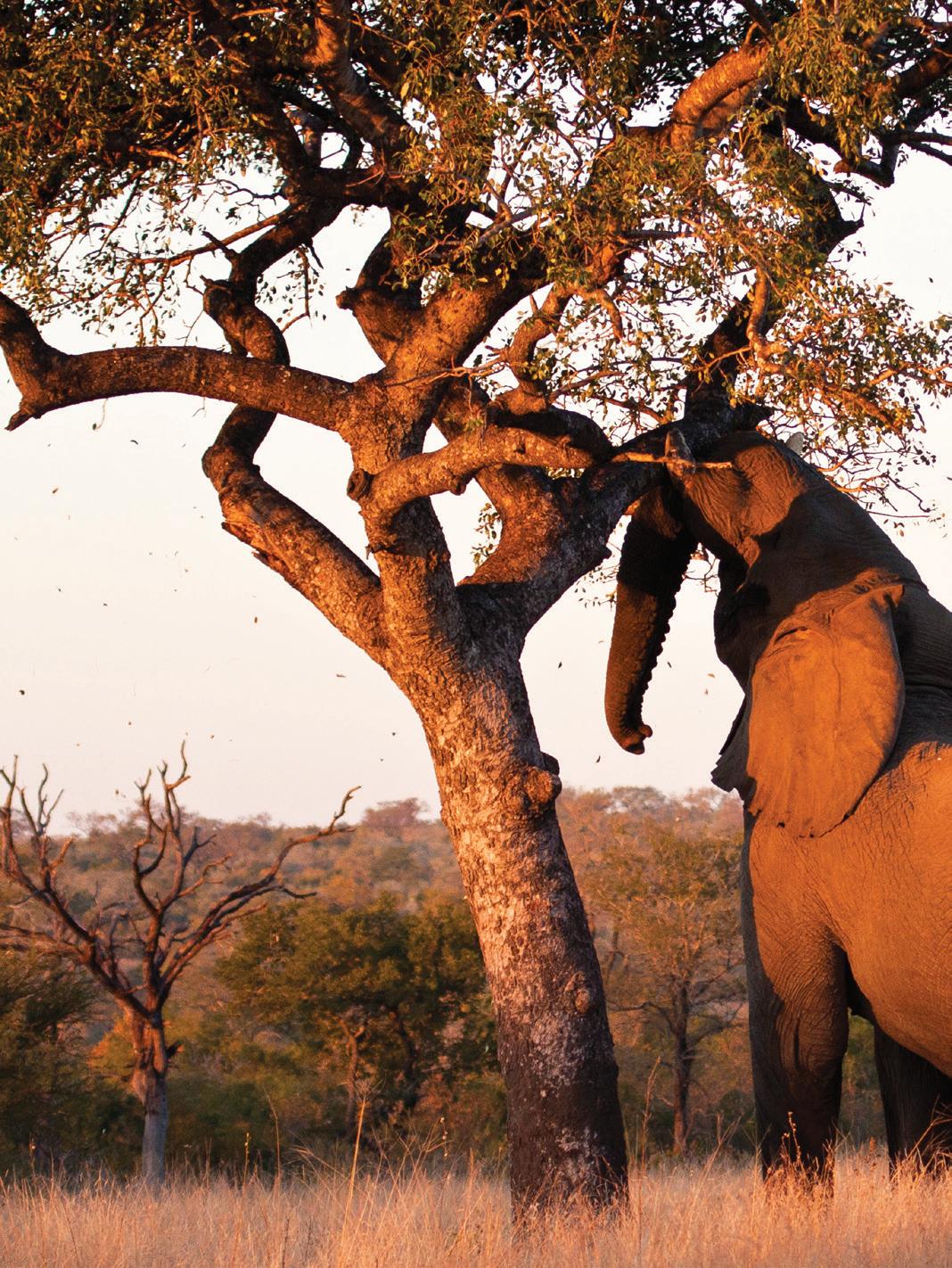
When animal populations are restricted to protected areas, their impact on the ecosystem may become too high. The impact that elephants have on marula trees, for example, can also bring them into conflict with humans because the trees are valuable for cultural and economic reasons.
In 2015, research began in the Jejane Private Nature Reserve of the Greater Kruger National Park to test whether bees might protect marula trees from elephants. Elephants like to eat marula leaves, bark and fruit, and often push trees over to get what they want – but they don’t like being stung by bees.
Hanging beehives in trees seems to work as a deterrent: after three years, only 8% of trees with beehives in them were damaged by elephants, compared with 80% of the “bee-less” trees included in the study.
What’s more, the honey harvested from the hives is generating funds to sustain the project, and people living near the reserve have the opportunity to benefit from keeping bees.
Robin Cook (BSc 2014, BSc Hons 2015, MSc 2017) conducted the research as part of his Master’s degree at Wits and now manages the Big Tree projects at Elephants Alive. The organisation was co-founded by a fellow Witsie: director and principal researcher Dr Michelle Henley (Greyling) (PhD 2004), who has been studying elephants in the area since 1996.
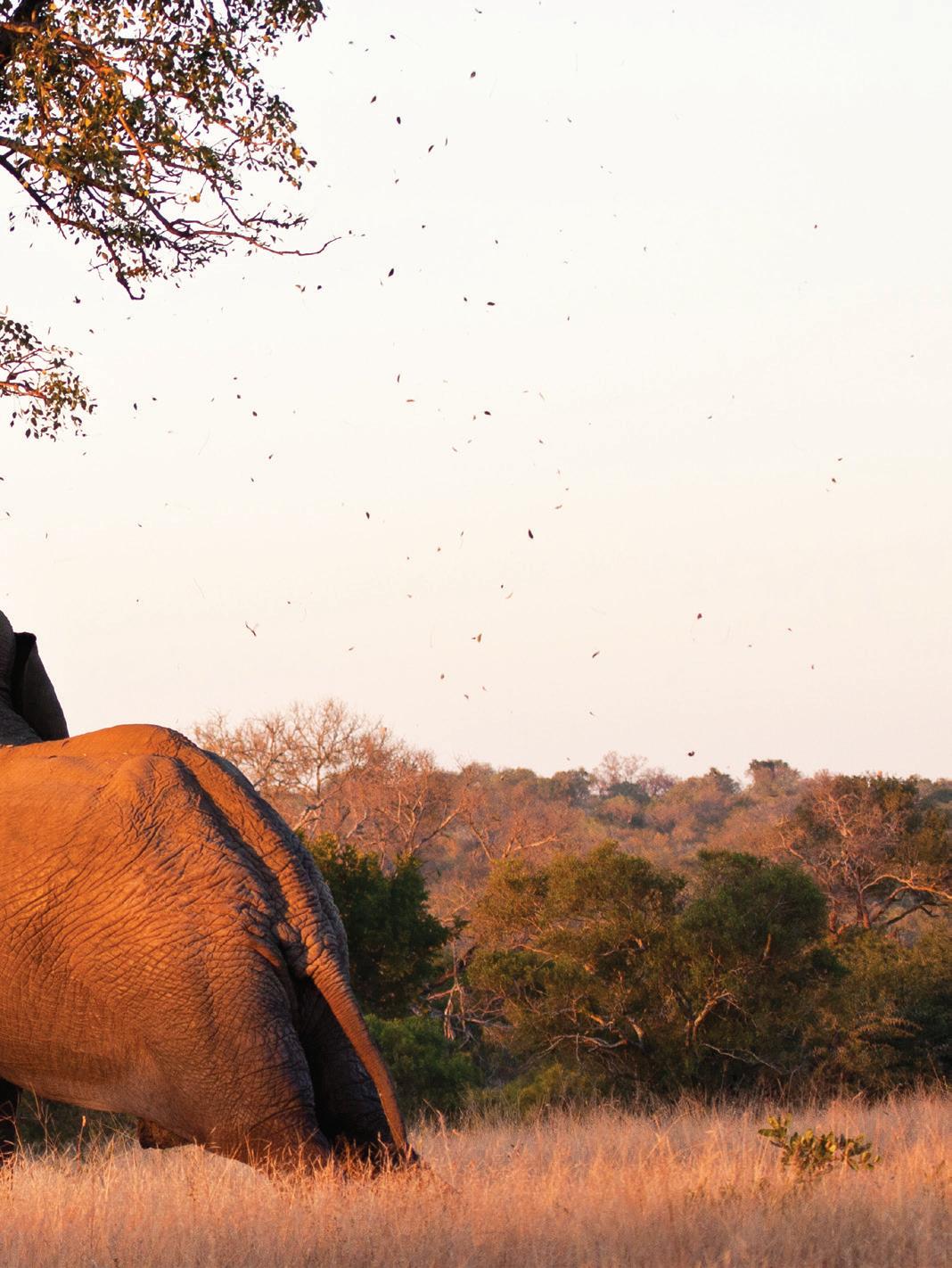
MALARIA KILLS MORE THAN 400 000 PEOPLE A YEAR IN AFRICA

Malaria kills more than 400 000 people a year in Africa. Biochemist Dr Shüné Oliver (BSc 2001, BSc Hons 2002, MSc 2009, PhD 2015) and her colleagues at Wits and the National Institute for Communicable Diseases (NICD) have been researching three aspects of this risk. They are: the
effect of human activity (including pollution) on mosquito biology; the impact of climate changes on the efficacy of insecticides; and the effect of higher temperatures on Anopheles arabiensis. This malaria-transmitting mosquito species is extremely difficult to control. The researchers have found that polluted
Above: Rosita Moises Zacarias (L), 15, holding the hand of her sister Joaninha Manuel, 9, walks in flooded waters from their house destroyed by the cyclone Idai, to go to sleep in a shelter in Buzi, Mozambique, on March 22, 2019
water sources are becoming a breeding ground for mosquitoes that are tolerant to a range of toxins. Not only do they have more places to breed in, they also develop insecticide resistance. Those that develop resistance are more tolerant of high temperatures than those that aren’t resistant.
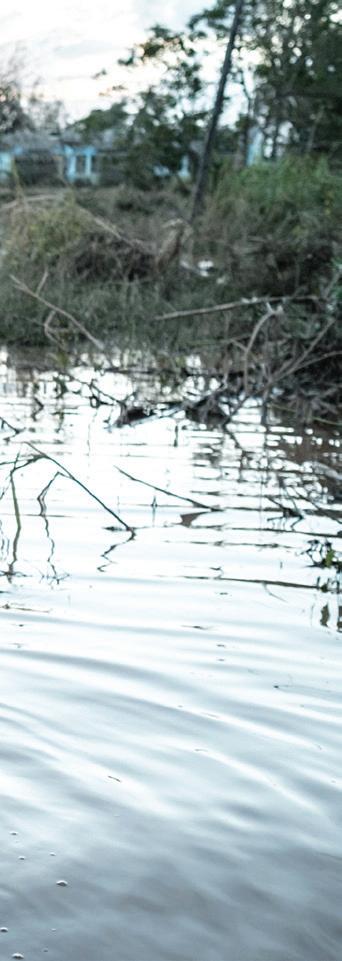
LDAs temperatures rise, so do the survival odds of insecticide-resistant mosquitoes. Many health risks follow natural disasters such as Cyclone Idai and Cyclone Kenneth, which drenched Mozambique in April. Malaria is one of them.
The NICD’s Professor Lucille Blumberg (MBBCh 1974, MMed
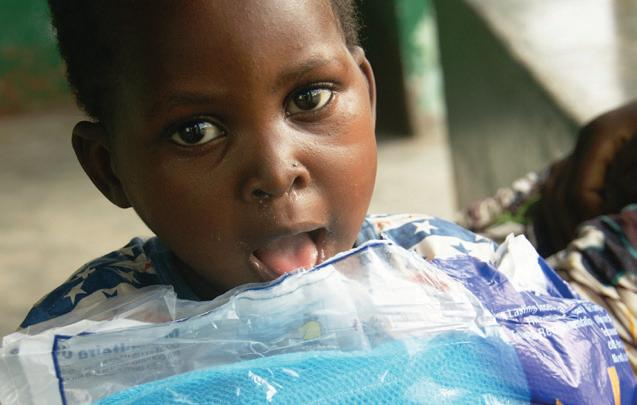
2003, DTM&H 1987, DOH 1991) and Dr Kerrigan McCarthy (MBBCh 1995, DTM&H 1998) have warned that mosquito populations explode in receding floodwaters, homes can’t be sprayed with insecticide because they have been damaged or destroyed, and health services are interrupted.
Cyclone Idai “provides a grim prospect of the future of tropical cyclones in a region under continued threat from climate change,” says Wits senior lecturer in physical geography Dr Jennifer Fitchett (BSc Hons 2012, MSc 2013, PhD 2015).
In 2017, Wits’ Research Institute for Malaria found that another species of mosquito, Anopheles vaneedeni , also carries malaria in the wild. This finding added to the challenge of controlling the disease.
Professor John Frean (MBBCh 1980, MMed 1990, DTM&H 1983) says there is a dangerous myth that preventive medication
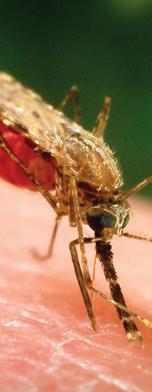
Above: A child holds a longlasting insecticidal net during distribution at Dondo, Sofala, Mozambique
Below: Anopheles gambiae complex mosquito
( Image: James Gathany, Centers for Disease Control)
“masks” symptoms of malaria and makes it more difficult to diagnose.
“Prophylactic medications are highly effective if taken properly. But the infection may take longer to show if compliance is poor and doses are missed or prematurely stopped.”
Professor Miles Markus (BA Hons 1999) has long been considering why malaria can recur in people who have been treated for infection by Plasmodium vivax, one of the species of malaria-causing organisms that mosquitoes carry. Conventional thinking has been that P. vivax multiplies only in the liver and bloodstream. Markus’ proposal that more organs and tissues are involved has now become more widely accepted. The organism’s progeny can also be found in bone marrow – where it may not respond to drugs in the same way, or may find its way into the bloodstream.
Source: The Conversation

More than a quarter of South African households consist of only one person. The proportion is growing but policies, welfare systems and institutions are not keeping pace.
Researchers in Wits’ Schools of Public Health and Social Sciences carried out a study of this trend and found that solitary living in South Africa is associated with older age (60 years and above), rural residence, internal migration, having a primary level of education, not owning a house and being black, among other factors. The key drivers of this phenomenon are compositional change in household ownership, migration and employment.
The rise in one-person households is consistent with the pattern of rapid household growth compared to population growth in South Africa. The proportion of people owning homes has declined and that of people who do not own their homes has increased.
Most of those who live alone live in rented dwellings, peri-urban areas, informal settlements and temporary settlements.
Solitary living among internal migrants is linked to economic inequalities between provinces which separate families through labour migration.
The seventh issue of Wits’ research magazine, Curios. ty , explored ideas about the South African cities and homes of the future. Professor Barry Dwolatzky of the Johannesburg Centre for Software Engineering suggested that city services such as energy provision and waste removal might shift from the state to micro-providers in communities. This decentralisation could also have an effect on politics. Dr Gerald Chungu, in the School of Architecture and Planning, noted a trend towards smaller houses, and Acting Dean Professor Anne

Fitchett added that housing policy was shifting towards upgrading settlements to improve access to jobs, schools and hospitals.
SOLITARY LIVING IN SOUTH AFRICA IS ASSOCIATED WITH OLDER AGE, RURAL RESIDENCE, INTERNAL MIGRATION, HAVING A PRIMARY LEVEL OF EDUCATION, NOT OWNING A HOUSE AND BEING BLACK...
While in wealthier countries, living alone is more likely to be by choice, in South Africa this is not necessarily the case; it can be forced by economic or age constraints. The trend has far-reaching implications for social welfare, housing and urban planning. Older people living alone will need institutional care and community care centres. And as the number of oneperson households grows,
Many of those who live alone live in informal settlements and rural areas
so does consumption of resources such as water, transport and welfare. The research was carried out by Nyasha ChadokaMutanda (BA Hons 2010, MA 2012) and Prof Clifford Odimegwu in the Schools of Social Sciences and Public Health at Wits, and published in the Journal of Population Research. It was funded by the DST-NRF Centre of Excellence in Human Development.
IT IS A REALLY EXCITING TIME, AND WHEN I SEE THE CALIBRE OF YOUNG SCIENTISTS AND TECHNOLOGISTS, I AM VERY OPTIMISTIC ABOUT OUR FUTURE

Some problems are just too big and complex for any classical computer to work on. But quantum computers are exponentially faster and more powerful. These are what’s needed to advance technologies such as artificial intelligence and machine learning – which
in turn can help solve problems in chemistry, physics, medicine, finance and cosmology.
To remain competitive, researchers and countries are scrambling to develop quantum computing and its associated industries.
Now Wits researchers and scholars from 15 other institutions in the African
Above: Dr Solomon Assefa (IBM Research) and Professor Zeblon Vilakazi (Deputy Vice-Chancellor) with a 3D printed model of the quantum computer
Research Universities alliance have access via the cloud to IBM’s quantum computer, IBM Q. Wits is the company’s first African partner on the IBM Q Network, a community of Fortune 500 companies, academic institutions, start-ups and national research laboratories.
Using this resource, researchers at Wits will be focusing initially on HIV drug discovery and on work in the Structured Light Laboratory.

Artificial Intelligence is driven by machine learning, which is about computers improving their own performance over time by being exposed to an increasing amount of data. This technology has many potential benefits, explains Dr Benjamin Rosman (BSc 2007, BSc Hons 2008 and 2009) (above), senior lecturer in the School of Computer Science and Applied Mathematics at Wits. “Among the most important is the democratisation of critical services such as healthcare and education, with the ultimate aim of providing personalised interventions to every individual. This includes tools to treat or even eradicate a far greater number of diseases than ever before, at affordable rates. The same innovations are poised to offer greater transparency of governance, improve corporate and political decision-making, and enable more efficient logistics.
“It is a really exciting time, and when I see the calibre of young scientists and technologists, I am very optimistic about our future.”

Research from the Wits School of Geoscience has answered the question of how platinum deposits formed in the Bushveld Complex of South Africa. The complex is the site of most of the world’s platinum.
One idea was that gravity caused crystals to settle on the floor of a chamber of molten rock. The other was that the crystals grew directly on the floor.
By examining the Merensky Reef of the Bushveld Complex, Dr Sofia Chistyakova and her collaborators have established that the crystals grow in situ,
along the cooling margins of the magma chamber.
The Merensky Reef happens to have a potholed chamber floor, and where platinum mining has exposed this the researchers can see that all these irregular surfaces are covered with the crystal “rind”. Crystals could not have settled by gravity and penetrated the solid rocks overhanging the potholes.
These observations “offer a remarkably simple solution to the challenge of platinum-reef formation”.
The research was published in Scientific Reports
Sibanye-Stillwater has donated its 2D/3D reflection seismic data worth R50m to the Wits Seismic Research Centre of the School of Geosciences. The data will be used by Wits geophysicists and postgraduate students for training and research purposes. The seismic data was acquired between the 1980s and 2000s for gold exploration at the company's mining operations in the Witwatersrand basin.

Along-standing question about the relationship between hormonal contraceptive use and the risk of HIV infection has finally been answered by a study called ECHO, which included Wits researchers.
The study compared the risks and benefits of several contraceptive options. It randomly assigned three different methods of contraception to 7 829 African women in Eswatini, Kenya,
South Africa and Zambia. It found that all three methods were safe and effective for contraception and that the risk of contracting HIV did not differ substantially between the options: a progestin-only intramuscular injection, a non-hormonal intrauterine device and a progestin implant.
Wits Reproductive Health and HIV Institute Executive Director Professor Helen Rees said: “The results of this


INDIVIDUAL LEVEL

In total, 397 of the 7 829 women acquired HIV during the ECHO study
The deadline to end AIDS by 2030 looms large. The target is “90-90-90”: 90% of people living with HIV knowing their status; 90% of all those with HIV on antiretroviral therapy (ART); and 90% of those on ART with no HIV in their bloodstream.
According to UNAIDS, South Africa achieved the first of the three 90s in 2017. But by 2018, only two thirds of the 7.1-million people living with HIV were on ART.
For many reasons, people who do start treatment often stop taking their medication.
study are reassuring, but our findings are also sobering, because they confirm unacceptably high HIV incidence among young African women irrespective of which contraceptive method they were assigned to.” HIV incidence in the trial was 3.81% per year even though participants received individual counselling, condoms and other prevention services.
The research was published in The Lancet The authors noted “the need for integration of HIV prevention within contraceptive services”.
Dr Michelle Moorhouse (MBBCh 1995) and Prof Willem Venter (MBBCH 1993, HDipTMH 2001, MMed 2008) of the Wits Reproductive Health and HIV Institute suggest that South Africa needs a package of interventions at a social, systemic and individual level. The 9th SA AIDS conference, held in Durban this year, focused on scientific, social and digital innovations and technologies, including injectable and implantable antiretrovirals.
Source: The Conversation
I
WANT TO EMBRACE DIVERSITY, NOT JUST IN TERMS OF RACE, GENDER AND AGE BUT ALSO CULTURE, GEOGRAPHY AND DISCIPLINES
For the briefest of moments Mpumi Madisa could have become a shipping industry exec and had an office with a sea view – but she would have had to become a Capetonian.
Table Mountain’s loss is Joburg’s gain and now also Bidvest’s trump card. Madisa remained a Gautenger and is now CEO-designate of the transnational trading and distribution group, which has 120 000 employees and a market capitalisation of R65-billion.
Madisa jokes about the shipping job as “the one that got away”. She remembers how, as a young Wits graduate, she was introduced to the potential employer while standing on a ship, looking out at the vast ocean with its watery horizons
HER APPOINTMENT MAKES HER THE FIRST BLACK WOMAN TO BE CEO OF A JOHANNESBURG STOCK EXCHANGE TOP 40 COMPANY, AND ONE OF THE YOUNGEST IN SOUTH AFRICA.
full of possibility. Maybe she should say yes to the position on offer, she thought for a moment.
But Sebokeng-born Madisa (39) chose instead to be close to her family in Johannesburg and took up a job in insurance. That led her to the Bidvest group of companies in 2003 and she’s been there ever since, apart from three years in government.
“Bidvest has become my second family,” she says. It’s quite a Witsie family too, founded in 1989 by Brian Joffe (CTA 1972, DCom honoris causa 2016) and led at present by Lindsay Ralphs (BCom 1978, PDipCom 1981).
The family, though, should ready itself for a bit of a shake-up when Madisa takes up the reins in the 2021 financial year.
“I want to embrace diversity, not just in terms
of race, gender and age but also culture, geography and disciplines.”
Madisa believes broad diversity allows companies to adapt to rapidly changing mega trends, technological disruptions and evolving customer demands. It’s part of the reason she spent some time as chief director of transformation in the Gauteng provincial government.
“I loved my time in government. It was challenging but it was really good,” she says. She saw the challenge as one of aligning multiple systems to function well collectively.
Making government work still occupies much of her thinking. She believes corporate leadership demands it, especially when social inequality is widening and
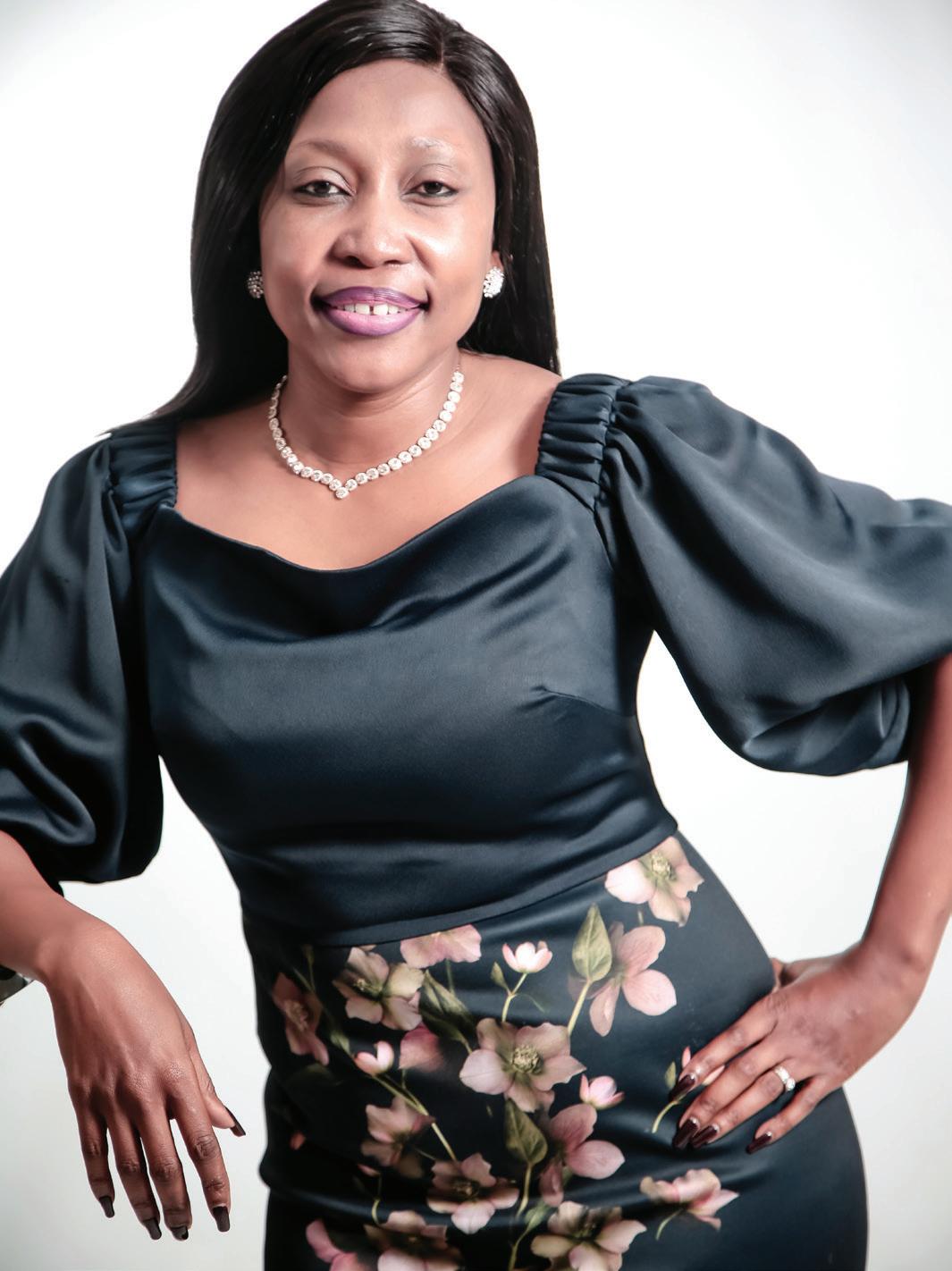
youth unemployment is over 55%. Business can never be an island and corporates need to be part of the solution to social problems. Shareholder value and social value must intersect.
“How about we just ask people what they need so we can understand their problems better and start addressing the root problem?” she asks.
This is why Madisa still finds time to speak at schools and to young people about to start their careers. They keep her in touch and help her reflect on the responsibility of being a role model. One week after the announcement that she was in line for the top job at Bidvest, she addressed Grade 8 to Grade 12 learners of Masibambane College in Orange Farm, a township in Gauteng faced with significant social challenges.
“I reminded them that I was the reality, not the dream, and that I didn’t grow up far from where they were growing up.
“I tell pupils that we are not how we start or where we start and therefore they should never be afraid to dream. I tell their teachers to imagine that every child before them is destined to do amazing things,” says Madisa.
Her appointment makes her the first
black woman to be CEO of a Johannesburg Stock Exchange Top 40 company, and one of the youngest in South Africa.
Madisa was one of three children raised by a single mother who was a teacher – Audrey Mazibuko. She went to a convent school in Sebokeng and remembers that during the worst of apartheid violence she had to be smuggled in to school. The hostels were on fire and the township streets were tense and dangerous.
She also remembers being her mother’s marks checker for test papers and assignments. It made numbers and maths almost second nature to her. She holds a Master’s in Management (Finance and Investment, 2015), a BCom Honours in Economics (2004) and a BSc in Economics and Mathematics (2002).
“I was great at spotting any errors and we worked through discrepancies together. Near the end of the year my mom would bring home a register that she would unfold on the table. It had all the pupils’ marks for various tests and assignments for the year. Years later when I saw a spreadsheet for the first time I thought, ‘wait, I’ve seen this before’,” she says, laughing.
Another legacy from her mother is her strength,
I TELL PUPILS THAT WE ARE NOT HOW WE START OR WHERE WE START AND THEREFORE THEY SHOULD NEVER BE AFRAID TO DREAM. I TELL THEIR TEACHERS TO IMAGINE THAT EVERY CHILD BEFORE THEM IS DESTINED TO DO AMAZING THINGS
Madisa says. Women of Audrey Mazibuko’s generation missed the 1956 march to the Union Buildings in protest against pass laws, but soldiered on to survive, to raise children and give them a shot at a better life.
“For my mom there was always not enough, always uncertainty, but still she would lead with virtually nothing.”
Madisa has made her mother proud. At a family lunch to celebrate Madisa’s appointment her mother put it simply: “It’s as if the Lord knocked on my door, walked in and sat down at my table.”
Mpumi and her husband David Madisa try to instil the same values of hard work and “just doing your best” in their son, 8-yearold Khumo. “Khumo is what I’m most proud of in life. And when I retire I’m going to be managing his band because he’s going to be a drummer,” she says, all smiles.
She’s guided by keeping things simple, working with purpose, keeping entitlement in check – and having fun when you can. The former Sunnyside resident’s Wits days weren’t just about books and lectures. “I loved dancing and even now, if there’s a dance floor that’s where you’ll find me!”
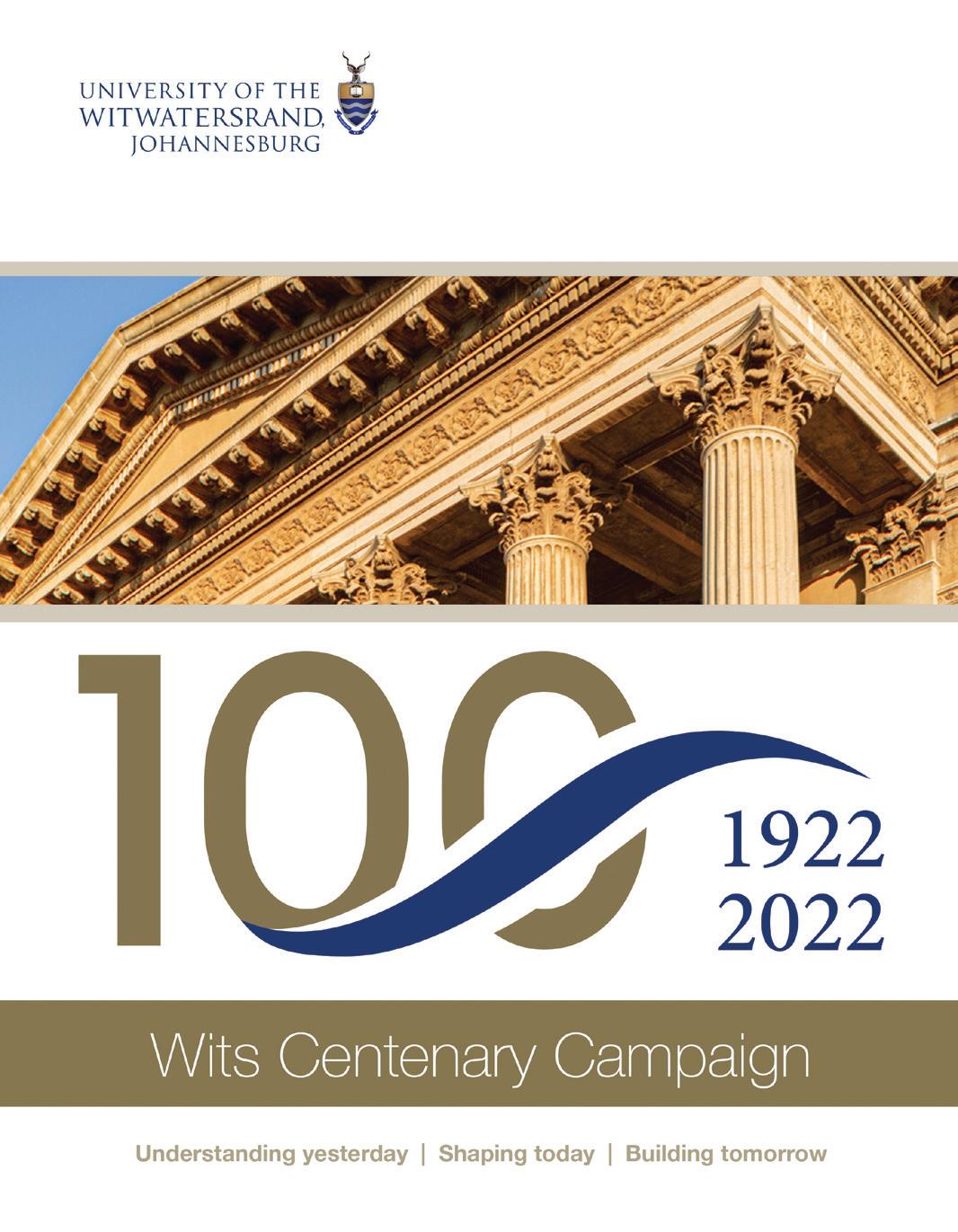
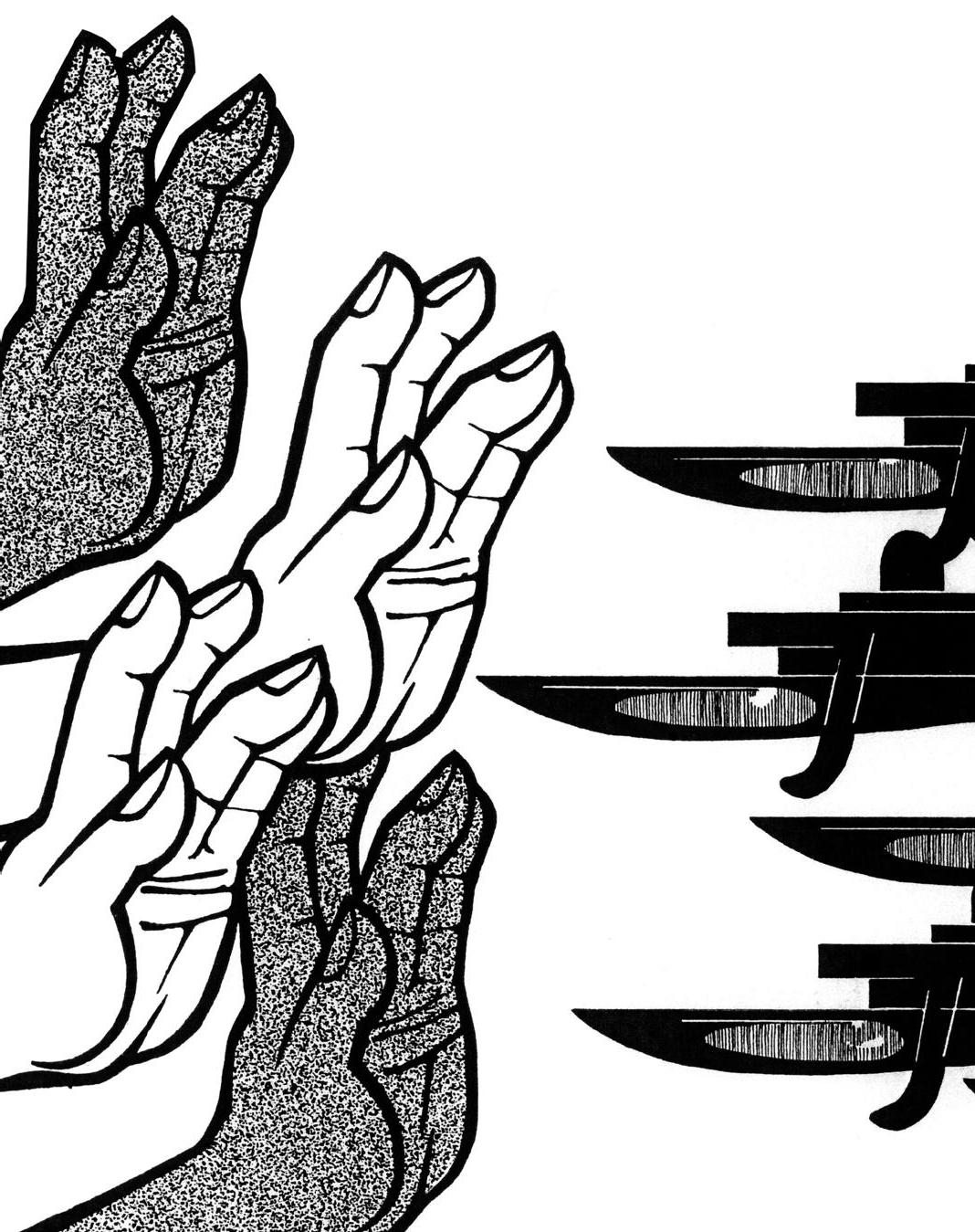

USING PEN-AND-INK ON ALBANENE DRAFTING PAPER, THE ARCHITECTURE STUDENT FRANCO FRESCURA SPOKE THROUGH POLITICAL CARTOONS AND GRAPHICS THAT POKED THE CHEST OF APARTHEID AND STRIPPED BARE BIGOTRY AND RACISM. HE WAS A FORERUNNER OF FEARLESS, NO-HOLDS-BARRED POLITICAL CARTOONISTS LIKE ZAPIRO AND COMEDIANS LIKE LOYISO GOLA...


The platform for Frescura in 1972 and 1973 was Wits Student , the weekly newspaper published by the Wits SRC, whose tone was unapologetically antiracist, anti-apartheid and anti the South African government of the day.
Frescura recounts how the paper featured debates on national political issues, hard-hitting satire and a column called The John Burger Saga , “written and produced by a witty and devilish handsome architectural student of Italian extraction”.
Almost fifty years later, in October last year, his cartoons, drawings and posters from the 1970s and beyond were featured in a book and an exhibition titled Franco’s Greatest Hits! held at Durban’s Phansi Ubuntu Art Museum.

He spoke to Wits Review from his office at the museum about Wits Student and The John Burger Saga , which was printed on the back page of Wits Student between 5 May 1972 and 27 April 1973:
“In its brief life only 16 pages [of the Saga] were ever produced, five of which were immediately banned by the government’s Publication Control Board. An omnibus reprint of the collected works of John Burger, published in May 1973, sold 3000 copies within three hours. By 18:00 that evening a special broadcast on the SABC, the state-run radio service (there was no TV then), had warned the nation that reading, possession and distribution of the publication had been banned. Listeners were advised to destroy their
copies forthwith, or face a hefty fine and the possibility of a prison sentence.”
What was it that got the authorities so worked up?
Well, in one issue, for example, Frescura posed the question: “What should the honourable Prime Minister do with its NUSAS commission of inquiry report?” The Schlebusch Commission had been ordered to investigate “subversive organisations” such as the National Union of South African Students (NUSAS) and the South African Student Organisation, which led to 16 of their leaders being banned.
As an answer the cartoon showed the report protruding from “the capacious derriere” of Prime Minister Balthazar Johannes Vorster, better known to readers of Wits Student as “Prime Monster
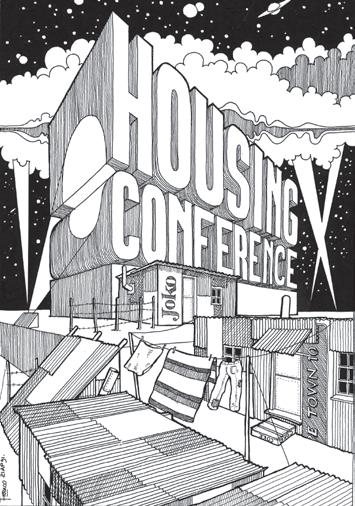
and sometime god, Butcher Fogstar”. Another graphic, borrowed from the Anti-Apartheid Movement, showed the South African police brutally beating protesting women in Cato Manor, with the headline “If you could see their national sport, you might be less keen to see their cricket”.
The private sector was also subject to the barbs of Wits Student , and in one issue a group of Ku KIux Klansmen are shown to be drinking “Master Beer, the Brew for the Master Race”. This was a response to the launch by SA Breweries of a new Master Brew label. This jibe was repeated in the national press, and the beer was taken off the market soon thereafter.
Frescura also annoyed Lever Brothers with a cartoon that exhorted housewives to use “a

SERF” to do their washing.
“Many people will, in retrospect, ask what the fuss was all about,” says Frescura. “After all, student humour the world over is commonly expected, at best, to be smutty and lavatorial in nature.”
To understand the reaction of the apartheid leadership, Frescura, in full mischievous flight, points to its overly literal interpretation of his work.
Thus, when he warned that “Beware, the tools of Communism are coming”, this was interpreted by a court to mean “the penises of Communism are ejaculating”. Ludicrous, but true. Similarly, when in a cartoon BJ Vorster’s dinner companion proclaimed that she simply loved his Nationalist balls, the court came to the conclusion that this had five different
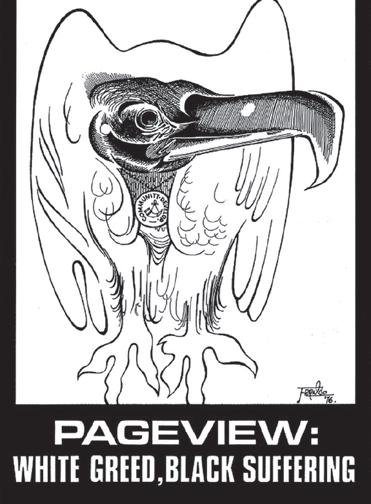
PEOPLE OF THIS COUNTRY
interpretations, each “too disgusting for words”. Then, as now, the line separating satire, fact and “fake news” was extremely fine.
Frescura points out that, in the 1970s, Afrikaans society was overwhelmingly patriarchal. “To insult the father figure was unthinkable … thus satire, personal ridicule and anything which diminished the dignity of the patriarch was considered to be subversive and revolutionary.”
In 1973 Wits Student editor Derek Louw and Frescura were both rusticated for the remainder of that year for “bringing the university into disrepute”. Frescura believes that a wealthy potential donor had put pressure on the university to take punitive action against the student press. The two men were

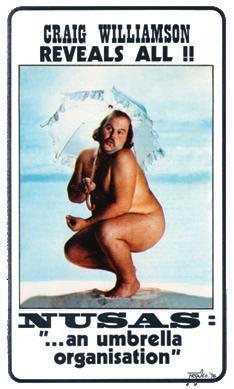

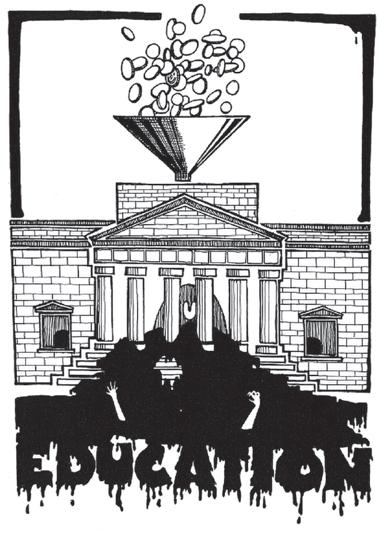

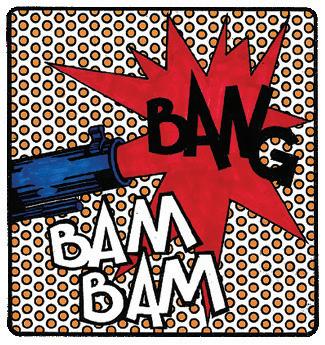
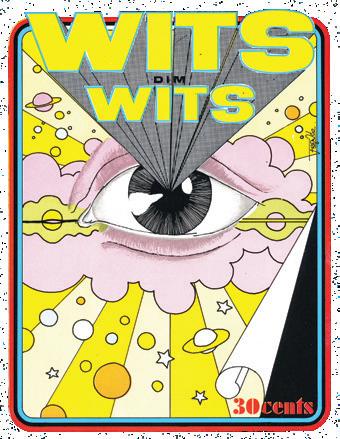


Franco Frescura notes that “between about 1968 and 1972, the Wits campus underwent a period where posters of all colours and sizes proliferated.” He attributes this to the fact that strong SRCs had plenty of activities to advertise and space to do it on the prefab timber huts on campus. These were demolished in 1973. “By the mid-1970s student government at Wits had crumbled and withered, crippled by internal dissension, police intervention and a series of financial scandals ... Thereafter advertising had to be done by means of pamphlets, more suited in size to the departmental notice boards available to student societies.”
“We had gone in with our eyes wide open and we knew there would be repercussions, but what I wasn’t prepared for was that it was my own people doing this when the fight was not with Wits, it was with the apartheid state. I loved Wits; it made available to me a whole lot of ideas that were not available to me before; it taught me to play around with ideas.”
Frescura was allowed to return to Wits in 1974, with the proviso that he would never publish anything else on campus again. He abided by this order, but off campus that same year he again aimed for the Prime Minister. “I knew that he hated the youth subculture of the time, its music, its art and all it stood for, and so I drew a poster featuring his
TO INSULT THE FATHER FIGURE WAS UNTHINKABLE … THUS SATIRE, PERSONAL RIDICULE AND ANYTHING WHICH DIMINISHED THE DIGNITY OF THE PATRIARCH WAS CONSIDERED TO BE SUBVERSIVE AND REVOLUTIONARY
face in a psychedelic aura, an echo of a record cover for the rock musical Hair , whose theme song was banned by the SABC.”
The poster was titled John Balthazar Superstar, a play on Jesus Christ Superstar , another hippy rock musical of the era whose music was also banned by the apartheid government. “I called him John Balthazar Superstar partly because he behaved as if he was a reincarnation of the Saviour, but mostly because I knew that having his face on that kind of artwork would irritate the shit out of him, and it did.”
The poster was confiscated by the security police before the printers could run the plates, and soon thereafter Frescura was stripped of his South African citizenship, “which subsequently arrested by the South African Police and charged with contraventions under the Publications and Entertainment Act. They were each sentenced to nine months in jail, suspended for three years, and a total fine of R1850, equivalent to approximately R75 000 today. The University paid their legal fees. One of the charges against them related to the publication of a statement that the South African Parliament consisted of a “corrupt pack of neo-Nazis elected by less than onefifth of the people of this country”. “In retrospect,” says Frescura, “I am still surprised by the moderate tone of our prose.” He adds that he was upset and humiliated when he was rusticated.
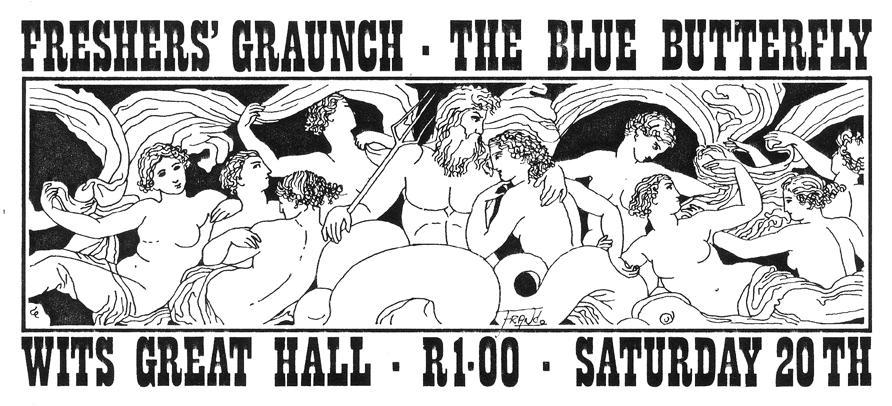
rendered me stateless for the next 10 years”, during which time he was not permitted to travel outside the country. In 1984 his citizenship papers were reinstated at the instance of Minister of the Interior Lourens Muller, a move which also opened the way for the return of travel documents to other antiapartheid activists.
In 1977 Frescura graduated as an architect and soon after was invited by Professor Pancho Guedes, Head of the School of Architecture at Wits, to join the staff. That same year he and his wife Lesley-Anne (Morton) had their daughter Gabriella Lindiwe. They had married in 1970 while Franco was a student (and have been together for 49 years).
Also in 1977, Frescura stumbled across the fact that Wits student and apartheid spy Craig Williamson's family owned
a property in Braamfontein which was being used by the Security Police as an interrogation centre. Given the fact that the apartheid state was highly unlikely to be doing business with an entity whose son, a former policeman, had openly joined its opposition, this was a clear indication that Craig Williamson had not changed his alliances, as he had loudly proclaimed. Unfortunately warnings to the NUSAS leadership that one of their nearest and dearest was a police informer went unheeded, and Craigie, as he was affectionately known to them, was not exposed as an apartheid spy and assassin until 1980.
In 1981 Frescura’s Master’s in Architecture was awarded cum laude by Wits, followed by his PhD in 1986. His thesis mapped out the history and development of southern African indigenous
THEN, AS NOW, THE LINE SEPARATING SATIRE, FACT AND “FAKE NEWS” WAS EXTREMELY FINE
architecture, a research interest he has maintained to the present day.
“As a student I started looking at how people build their own homes, which allowed me to understand architecture as a process and not a product, as a space and not a building. I became interested in the philosophy and anthropology of design,” he explains.
Frescura has travelled to most parts of Southern Africa, documenting the building and traditions associated with indigenous South African homesteads.
“I am probably the last architect to visit these settlements in that form, as after 1994 things changed rapidly and most of these buildings have disappeared,” he says. The only records left, in the main, are the masterful drawings he made on site during his research visits.
His first book, Rural
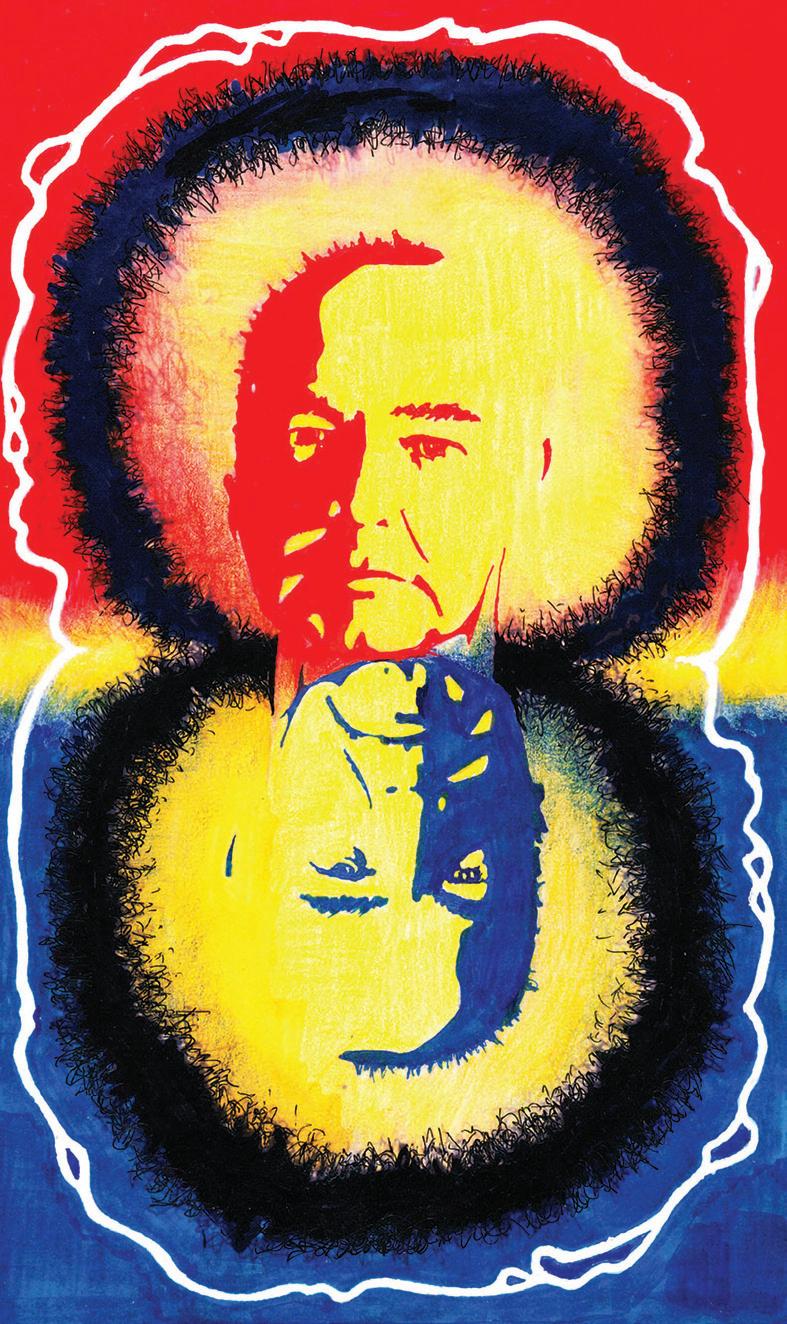
I CALLED HIM JOHN BALTHAZAR SUPERSTAR PARTLY BECAUSE HE BEHAVED AS IF HE WAS A REINCARNATION OF THE SAVIOUR, BUT MOSTLY BECAUSE I KNEW THAT HAVING HIS FACE ON THAT KIND OF ARTWORK WOULD IRRITATE THE SHIT OUT OF HIM, AND IT DID
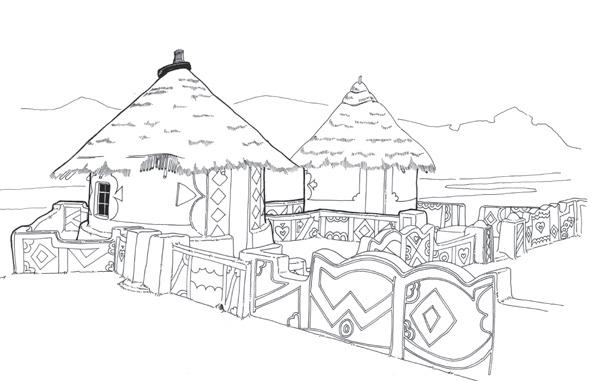
MANY PEOPLE WILL, IN RETROSPECT, ASK WHAT THE FUSS WAS ALL ABOUT. AFTER ALL, STUDENT HUMOUR THE WORLD OVER IS COMMONLY EXPECTED, AT BEST, TO BE SMUTTY AND LAVATORIAL IN NATURE
Shelter in Southern Africa , was published by Ravan Press in 1981 and is now a sought-after collector’s item. More recently, in 2016, he co-authored with Joyce Myeza, Director of Libraries and Special Collections at the University of KwaZuluNatal, a bilingual EnglishisiZulu Illustrated Glossary of Southern African Architectural Terms . He has also initiated, through the Phansi Museum, a programme of producing inexpensive publications aimed at teaching undergraduate university courses in architecture. Now 73, he continues to lecture on indigenous architecture. Although many would like him to revive The John Burger
Saga in a contemporary South African context, given that “the inheritors of fascist and totalitarian values live amongst us still”, he has, thus far, resisted the temptation. Yet traces of John Burger still linger. His LinkedIn profile tells us: “I have a congenital dislike of mediocrity, and find all forms of discrimination to be abhorrent. Master racists, religious fundamentalists, people that believe that Adam and Eve walked among dinosaurs, and those lacking in a sense of humour may find it difficult to work with me.” So who knows, perhaps that pen-and-ink on Albanene drafting paper will emerge again.


www.wits.ac.za/wam. University Corner, Corner Jorissen & Bertha Streets, Braamfontein.
T + 27 (0) 11 717 1365/58
E info.wam@wits.ac.za. Hours: Tuesdays to Saturdays 10:00 – 16:00. WAM has a café and hosts regular events and exhibitions. Admission free. Donations encouraged.
THE ORIGINS CENTRE www.wits.ac.za/origins. West Campus, Wits University, Corner Yale Road & Enoch Sontonga Avenue, Braamfontein. T +27 (0) 11 717 4700 E bookings.origins@wits.ac.za.
Hours: Monday to Friday 10:00 – 17:00. Closed on Sundays. Saturdays and public holidays 10:00 – 16:00 (please call ahead to check times). Refer to website for rates. Please book online (www. webtickets.co.za).
WITS THEATRE COMPLEX
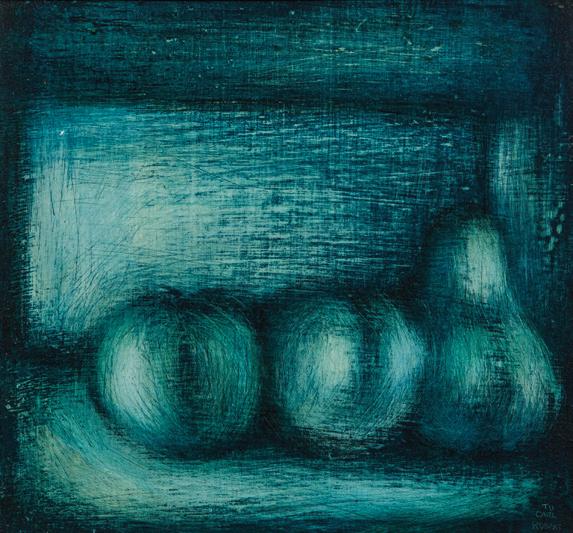
www.wits.ac.za/witstheatre. East Campus, Wits University, Performing Arts Administration, 24 Station Street, Braamfontein. T +27 (0) 11 717 1376 E bridget.vanoerle@wits.ac.za
Reception hours: Monday to Friday 08:00 – 16:00. Theatre costs vary according to programme. Tickets: www.webtickets.co.za
WITS RURAL FACILITY
T +27 (0) 15 793 7508 E info.witsrural@wits.ac.za
Refer to website for public rates.
THE WITS CLUB www.olivesandplates.co.za
Wits Club Complex, West Campus, Wits University. T +27 (0) 11 717 9365 E info@olivesandplates.co.za
Hours: Monday to Friday 07:00 – 16:00. Saturday 08:0015:00 for breakfast and lunch. Booking is essential.
PLANETARIUM
www.planetarium.co.za
East Campus, Wits University, Yale Road off Empire Road, Entrance 10, Milner Park, Braamfontein.
T +27 (0) 11 717 1390 E planet@planetarium.co.za
Hours: Kiddies’ show (5 – 8 years), Saturdays 10:30.
Wits Medical School, 7 York Road, Parktown.
T +27 (0) 11 717 2081 E adler.museum@wits.ac.za
Hours: Monday to Friday 09:00 – 16:00.
Cost free but venue hire tariffs on request.
THE CRADLE OF HUMANKIND & THE STERKFONTEIN CAVES
www.maropeng.co.za.
Directions: Off R563 Hekpoort Road, Sterkfontein, Gauteng. T +27 (0) 14 577 9000
E website@maropeng.co.za. Hours: 09:00 – 17:00 daily. Refer to website for rates.
Details accurate at time of publishing. Please contact facilities directly.
Still Life with fruit by Robert Hodgins, on exhibition at WAM By Ufrieda HoPART OBSESSION, PART MAGIC – THAT ABOUT SUMS UP THE COLLECTION OF ARTISTS’ BOOKS THAT HAS BEEN NURTURED, LOVED AND ADDED TO FOR OVER 40 YEARS BY PASSIONATE ART COLLECTOR AND PHILANTHROPIST JACK GINSBERG.
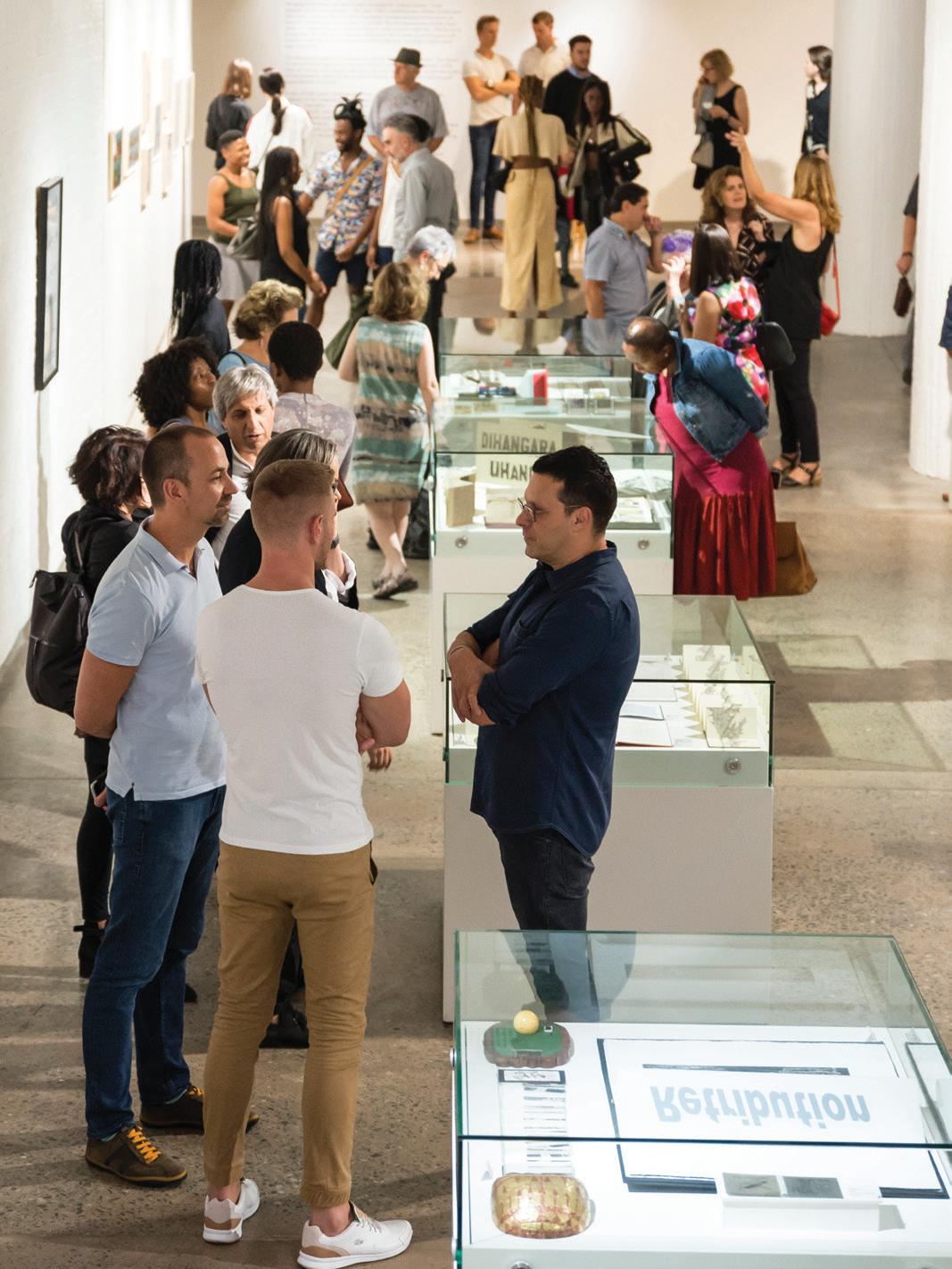
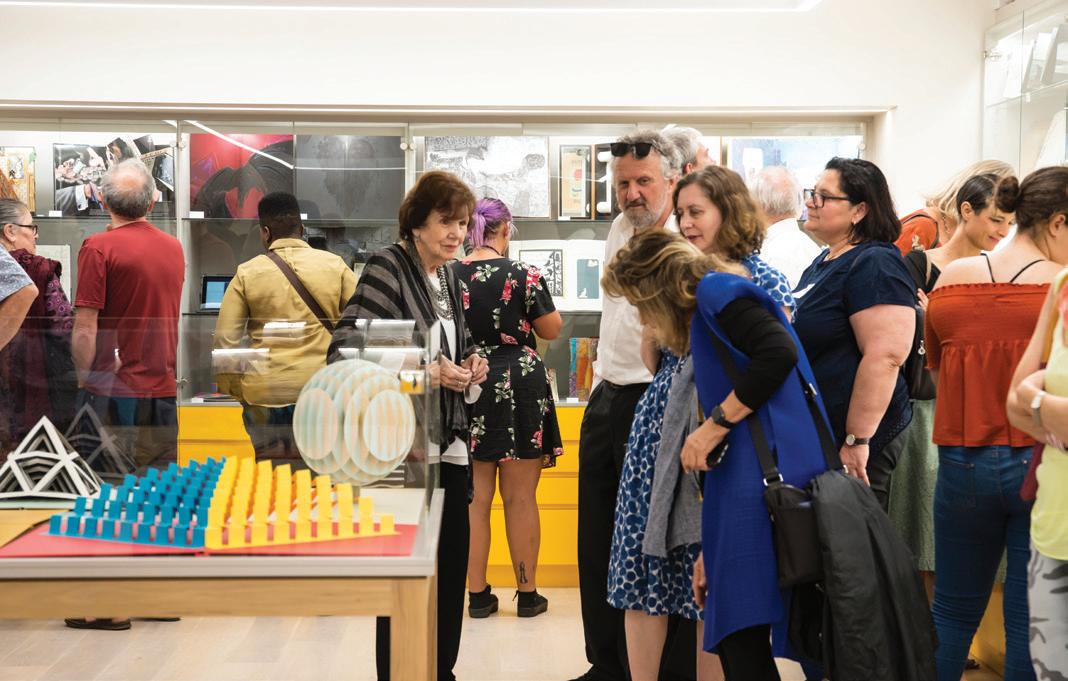
Artists’ books are artworks in the form of books, rather than books about art.
In March this year Jack Ginsberg donated this internationally renowned collection to Wits Art Museum (WAM) and helped establish the Jack Ginsberg Centre for Book Arts (JGCBA). This bright and welcoming space is located on the second floor of the museum and is dedicated to housing and displaying the collection. It includes over 3000 artists’ books, of which 400 are by South African artists, and an archive of over 3000
items on the history and development of the book art genre.
Ginsberg conducted a walkabout of the opening exhibition in May and introduced it to a select group of alumni at another special event.
It was a glimpse into his meticulous and mindful approach to collecting and descriptive cataloguing, and his joy in sharing the art objects he previously kept in his Johannesburg home.
The selection on display included books made from wood and glass and even hanging on coat hangers. One work by Pippa Skotnes is a horse’s skeleton,
inscribed with text. There are pop-up books with surprises in every flip of the page, zines and an almost complete set of William Kentridge books. There are books of all shapes and sizes, some containing elaborate folds of paper or cut-outs. The JGCBA now also boasts the world’s longest contiguous vitrine, at 11 metres, to display leporellos, the books that open like concertinas.
“Artists’ books are about a haptic experience of art – you have to touch them. Your fingertips know instinctively if you’ve picked up one page or two pages, and with an artist’s
ARTISTS’ BOOKS ARE ABOUT A HAPTIC EXPERIENCE OF ART –YOU HAVE TO TOUCH THEM
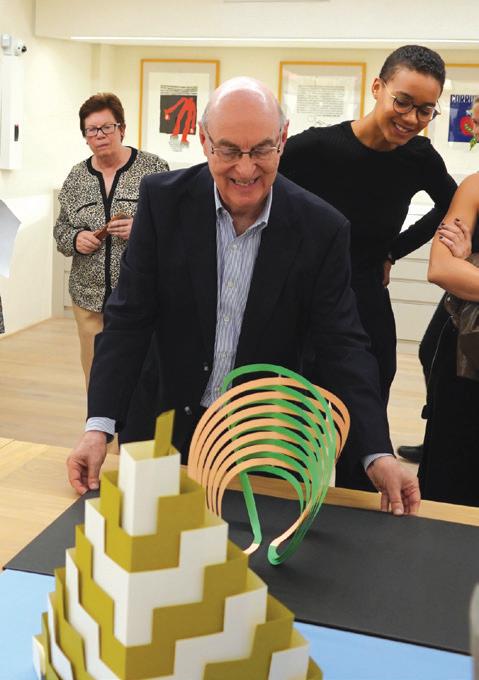
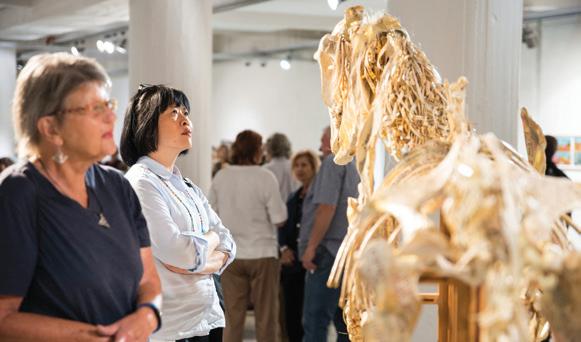

book you are forced into a sequential experience that the artist intended,” says Ginsberg.
He’s been a collector and a cataloguer most of his life. Art and books are at the centre of his makeup. Ginsberg remembers that he read about 300 books the year he was 10 –“mostly Biggles and Hardy Boys,” he says, laughing. In the collection is his own creation, Penelope Punctuated , which plays with fonts and language in a reference to an episode in James Joyce’s Ulysses . “I came from a very bookish family, so I was surrounded by books all my life and I started
collecting artists’ books and art by my late teens. I think my first book was a pop-up book of Alice in Wonderland ,” says Ginsberg.
Before the collection came to WAM, he allowed researchers and students to view it in his home by appointment.
“I only ever had one book go missing that I’m aware of. For many researchers from overseas it made more sense to fly to South Africa to spend a day or two going through my collection than to see only a few books at a time in a library collection.
“I didn’t mind the visitors, but it often took
me an entire weekend to rearrange everything in its proper place after one of those visits,” he says.
A chartered accountant by profession and a Wits graduate (CTA 1972, BAcc 1979), he admits he has “a terribly organised mind”.
Ginsberg decided the collection would have a better home at WAM, where it could be open to the public and accessed under supervision –including supervised hand-washing for visitors.
He also donated his stunning Walter Battiss collection to the Wits Art Museum three years ago.
“I had a great experience with the team with the
Jack Ginsberg (pictured above left) conducted a walkabout of the opening exhibition in May and introduced it to a select group of alumni at another special event.
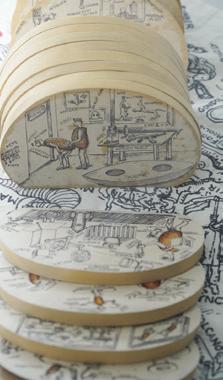
Battiss donation and exhibition – I call them the wonderful women of WAM. So we signed an agreement that I would make the donation of artists’ books and assist with the furniture and furnishings for the centre and Wits and WAM would provide space, climate-controlled storage, security and a librarian.”
Ginsberg also paid for the new lift car that was needed to reach the centre. “Now researchers and students can add 3000 more entries to the bibliography of a thesis,” Ginsberg jokes. And the number will grow thanks to the endowment fund he has helped create for new acquisitions.
“You just don’t know what will come into the market. But when I see artists’ books from the late 1960s and 1970s and the price is right I buy them, because this period really is the genesis of artists’ books,” he says.
The Oppenheimer Memorial Trust has committed R650 000 a year for three years for research, staffing and development in the JGCBA.
There will be four exhibitions a year to display more of the collection.
Ginsberg has also been instrumental in establishing an online database of South African artists’ books, which can
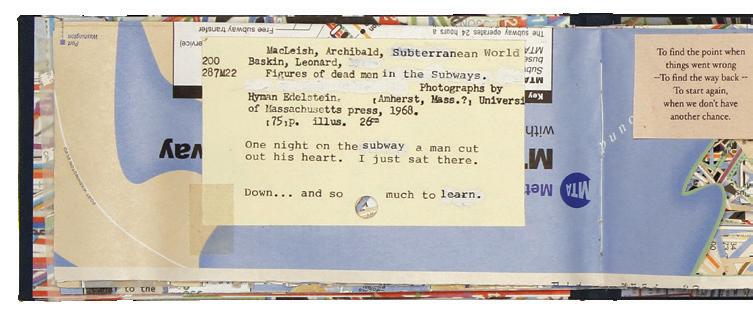

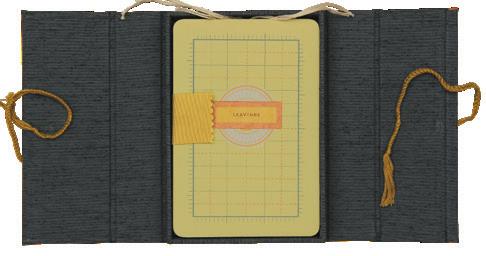

be accessed at www. theartistsbook.org.za.
For WAM curators
Julia Charlton and Lesley Cohen, an exciting aspect of the Jack Ginsberg Centre for Book Arts is that it contains a wealth of material for interdisciplinary learning.
“We are a connector for students and academics from different disciplines. WAM is a resource for Wits and other universities and for the city, so we constantly want to expose more people to what we have in the collection and
give them ideas about how they can use what we have,” says Cohen.
“The collections can be used to develop skills like visual literacy, creativity, innovation and critical thinking, which are essential in so many fields in the 21st Century, and it can help academics think about innovation and creativity,” she says.
The addition of a collection that is a “hands-on” experience is an opportunity to shake up lectures and use art in disciplines and fields
Image 1: Subterranean Geography, Robbin Ami Silverberg (2011), 102mm
Image 2: Leavings, Julie Chen (1997), 178mm
Image 3: The Great Wall, Shirley Sharoff (1991), 257mm
Image 4: The Be Careful Pop-up Book. If You Look Hard Enough You Can See Your Future, Stephen Hobbs (book artist) Ingrid Schindall (conceptualised by) David Krut Projects; (2013)



that are not traditionally associated with the arts, says Charlton.
“Sometimes it’s hard to imagine a lecture without chairs and desks and PowerPoint presentations, but there is a shift towards using art and art museums for teaching critical thinking, empathy, visual literacy and even practical challenges like climate control in a museum space, urban spatial planning and economics.”
Charlton says the impact of this kind of teaching through art can
be profound when it’s used to tackle hard subjects like slavery and patriarchy.
“The museum is a nonjudgemental environment, where there are no right or wrong answers, just different points of view, different life experiences, and so people get different perspectives,” she says.
With thousands more artworks now added to WAM’s treasures through Ginsberg’s generosity, there’s a new world to explore on campus.
Enquiries: Rosalind. Cleaver@wits.ac.za
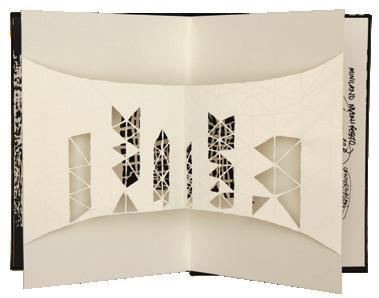
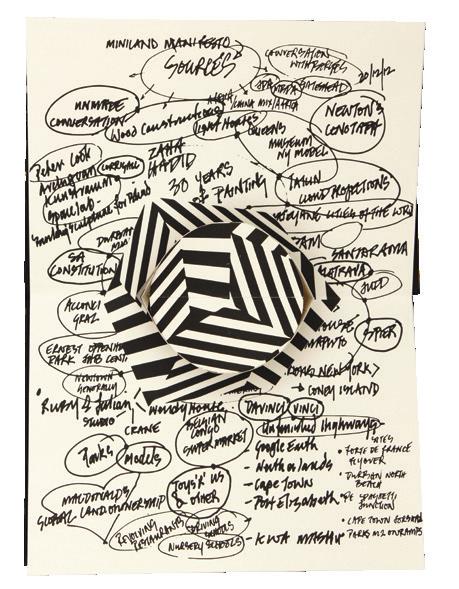
HEATHER
DUGMORE FOLLOWS THREE ALUMNI ON THEIR DIVERSE CAREER JOURNEYS. ..


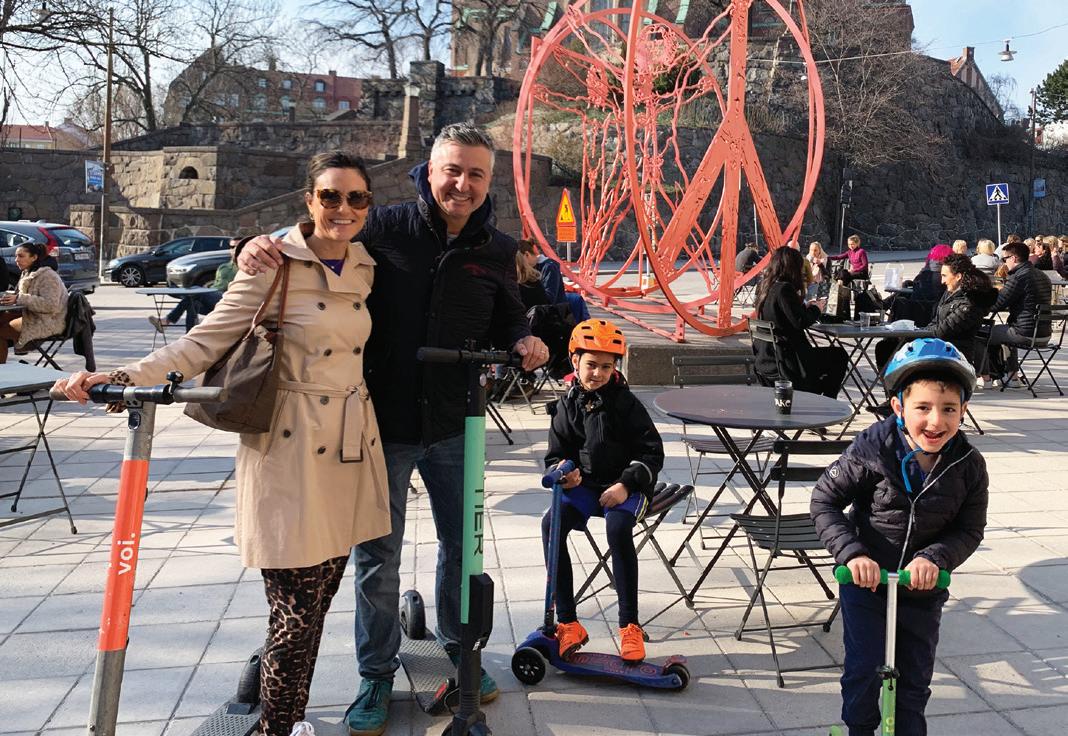
“We left our home, friends and family in Cape Town on 2 January this year in the height of the summer spirit and sunshine, and landed in Stockholm in the depths of winter,” says Charl Bassil, whose family made the move to Sweden on his appointment as vice-president of global marketing for the Absolut
vodka brand.
“I already had relationships with people at the headquarters in Stockholm, which was nice as there were friendly, welcoming faces. But it was tougher for my wife Dominique (an audiologist and jewellery designer) and our boys Jordan (7) and Luke (4) as there was nothing familiar for them.”
Absolut organised an apartment for them in the affluent suburb of
Opposite page: Stockholm in winter
Above: Charl and his wife Dominique and sons Jordan and Luke
Ostermalm, close to the international school the boys attend, and a 30-minute commute to Charl’s office in Liljeholmen, overlooking a beautiful lake where people go skating in winter and boating in summer.
From the outset, Charl had to travel internationally as part of his mandate to boost the brand’s biggest market, the United States, and grow the emerging markets, one of the fastest-growing being China. “I give my wife so much credit as she was handling the home front in a new country, not knowing anyone and without any
family support.”
Fortunately English is the second language in Sweden and there are a lot of expats working there, but the first few months were particularly difficult, as Charl explains. “Jordan came back in tears from school one day and said ‘Dad, this is too much, I don’t think I can do it, can we please go back to Cape Town’. I immediately said that if that’s what my family wants, we’ll return.
“He was being bullied at school and we spoke about this. I asked Jordan how he responded and he said ‘Dad, if someone is being unkind to you it doesn’t mean you need to be unkind to them’. What is amazing for me is how deeply philosophical young kids can be. As a family we decided to stay a bit longer to see if things improved and see what we could discover here.
“Six months into the year things started to turn around; the boys now have friends, the bullying has stopped, Dominique has made friends and we have experienced an incredible summer. People’s personalities change with the weather – and we have started to embrace living here. So now we’re falling in love with Sweden!”
Their Swedish is coming along well. Charl says: “From what we’ve experienced, the Swedes,
in general, are quiet and reserved, and they have huge integrity. They value their independence, so you can trust them to get the job done.
“Swedes are not prone to displays of emotion and they don’t shout. As South Africans we’re emotional and vocal and we’re used to greeting strangers, but say hi to someone you don’t know here and they look at you like you are looney. Beneath this reserve, however, they are kind and they will go to great lengths to help you.”
Throw into this society a South African family with Lebanese and Italian heritage and there is a bit of a culture gap. “Dominique says we need to help the Swedes to express themselves. We see ourselves as liberators!”
Leaving home is “a huge thing and fortunately a positive thing for us. The boys now understand what it feels like to be a foreigner and when we return home they will be more empathetic to foreigners. We also feel we need to be South African ambassadors here, and tell people about our wonderful country and continent.”
Charl adds that the move has given him a sense of what it was like for his forebears. “My mom Juliette’s grandparents had to flee Lebanon just
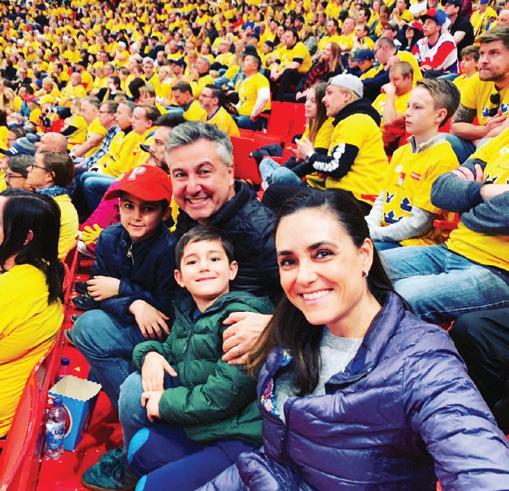

Their first
game supporting Sweden
Work trip to China Far right: learning to ski Bottom: Charl’s office in Liljeholmen, overlooking a beautiful lake
before WWI as it was ruled by the Ottoman Empire then and the order was to kill all Christians.” His father, Daniel, came from the Qadisha (Holy) Valley.
“He came to South Africa for economic reasons and started out as a farm labourer. He built himself up, eventually buying two farms and then selling them and moving to Klerksdorp, where he was successful in the property business in the 1970s and 1980s.”
Charl grew up in Klerksdorp and in 1991,
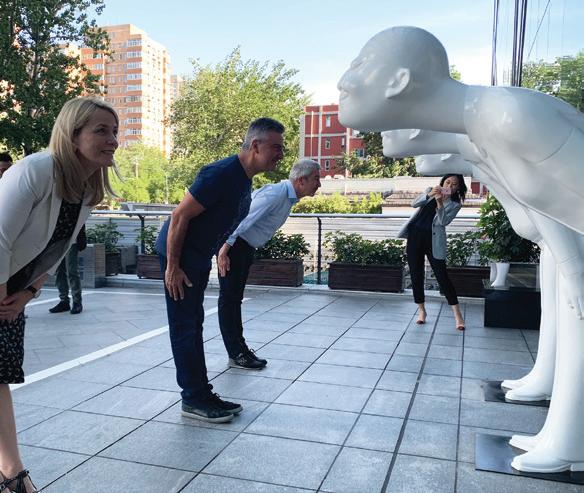
aged 17, arrived at Wits to study mechanical engineering. Here he made lifelong friends. “Some are still in Joburg, some are in London, one is in Melbourne, another in Dublin and we keep in touch via our WhatsApp group, called Newtonian Mechanics, as that was one of our engineering books.”
His mother still lives in Klerksdorp and has an intriguing tale about him. Doctors had told her she was infertile but her own mother would not accept this and pledged ten years of her life to a hermetic monk in the Qadisha Valley if God would grant her daughter a child. Charl was born one year later on his grandmother’s birthday. She never drank except on the day he was born, when she had a whiskey.
On the subject of alcohol, Charl says that being in the industry
comes with a huge responsibility. He says his mentor, Norman Adami (MBA 1979), a former executive at the brewing company SABMiller, helped him gain perspective on alcohol (and encouraged his change of career from engineering to marketing). “Norman said that alcohol has been around for thousands of years and as much as it has a shadow side, it is also enjoyed by many people as a mood enhancer and social lubricant. We’re never going to stop people drinking but at Absolut we match our product with positive lifestyle messages, including inclusivity and sustainability.”
Sustainability defines the Swedes. “They’re at the forefront of recycling and the circular economy; it’s an intrinsic part of life here.” As for inclusivity: “Sweden has a strong reputation for welcoming
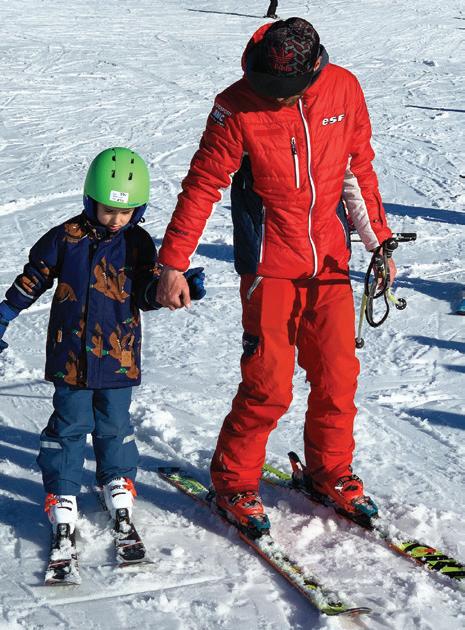
THE SWEDES, IN GENERAL, ARE QUIET AND RESERVED, AND THEY HAVE HUGE INTEGRITY. THEY VALUE THEIR INDEPENDENCE, SO YOU CAN TRUST THEM TO GET THE JOB DONE
refugees, although the flow is being more controlled now. I don’t know if the refugees feel part of Swedish society as they are settled in distinct areas. When we are looking for Lebanese spices, for example, we go to a suburb where you could swear you were in Dubai.”
Would they ever think of emigrating? “Absolutely not,” he exclaims. “Psychologically I cannot think of leaving South Africa and I am anxious that my children should know they are South African. Fortunately we have our house in Cape Town and each Easter and Christmas we come home. At the same time it’s enriching to experience living in a country totally different to your own.”
TAX PLANNING SPECIALIST
LOCATION: SEATTLE, USA
BCom 1995, LLB 1997, LLM (Tax) 2001

“Iam assimilating into American culture and pursuing a new identity as a patriotic American citizen. At the same time, South Africa remains very dear to me and I wish to see her prosper,” says Lindi Tardif (Langa), who emigrated to the United States in 2006 and is a corporate international tax planning specialist at Amazon’s headquarters in Seattle, on the northwest coast.
The story of her life, titled Daughter of Apartheid, was published by Elm Hill Books this year. She says she wrote the book in the hope that it would speak “to all who feel embittered by racism and prejudice”.
Lindi was 20 when South Africa’s first democratic elections took place in 1994: “I call myself a daughter of apartheid not just because I was born and raised under that oppressive system, but also because I was among the first wave of ‘oppressed others’ to move into spheres of commerce that until very recently had been beyond our reach.
“I know very well what it is like to be viewed as a threat or with curiosity and disdain in a white maledominated workplace. Fortunately I was raised
to make the most of any opportunity, irrespective of the circumstances, in order to get ahead. I’ve made this my motto because if we reflexively blame others for all of our problems, we declare to the world – and even worse, to ourselves – that we are perpetual victims in perpetual need of extra help and support.
“The alternative, which is so much more empowering, is to see ourselves as a people who have come through severe trials and are just beginning to tap into our amazing potential. Whether in the United States or South Africa, or in any number of other countries, we are living in a dispensation our forebears could only dream of, and we have opportunities they could not even imagine.”
Twenty-five years after South Africa’s 1994 “rebirth”, Lindi has a top career and is a firm believer in the American dream “for anyone who has a skill, talent, or good business idea and who is committed to getting ahead in the US”.
Her journey started in Soweto, at her grandparents’ three-room home in Orlando East. She describes her childhood as “difficult and sometimes outright dangerous” because of political and gang violence.
But her mother, Esther
Langa, and grandmother, Irene Langa, taught her not to see herself as a victim. They believed the way to create a different reality was through a good education. “In the black community, where it was expected that children would do a lot of household chores, my grandmother wouldn’t let
me do any. ‘Your chore is to study,’ she would say.” They also gave her the power of choice. She was free to behave as she pleased, as long as she accepted the consequences.
At Wits in the early 1990s Lindi exercised her choice on the issue of studying versus disruptive protests: “I felt the right way to achieve transformation was to give black students a chance to learn, so that the pool of black professionals and professors could increase.” It was not a popular stance but she stood her ground, asking “what is reasonable and what is right from a long-term perspective”.
Living her ethos gained
her a good career and her own home on Mercer Island, an affluent area in the state of Washington, where she lives with her three children, Amelia (14), Naledi (11) and Abraham (8).
“I feel blessed to own a home here and to be raising my kids in this environment,” she says. “This community is in one of the best public school districts in the state, and it is beautiful, surrounded by water, and safe.”
At the same time, the US is not an idyllic society: “There are still a lot of issues to work through, including far-right violence, rising levels of antisemitism, implicit racism in certain quarters, and wealth and income inequality.”
She says that although her predominantly white neighbourhood is “very racially progressive”, her kids may eventually be forced to grapple with race-related issues. Being of mixed race, they “may feel pressure to deny part of their heritage … [or] struggle with the feeling of not belonging at all.”
Lindi feels it’s important to deconstruct “blackness”: “Blackness is not monolithic. Blackness does not come in one shade with one common experience, one common thought pattern, one set of aspirations, or even one set
of common values.”
Her dream is “a world in which we see everyone else as a human being, and skin colour is just a little piece of a person’s outward appearance, a piece we look right past to see what is inside.
“I happen to be a black woman, yes, but I am also a Christian, and a mother and a lawyer. I love travelling, opera, Ndebele art, ice hockey and golf. I’m a Shakespeare devotee, a sushi junkie, a fashionista …
“I am a unique human being with all the strengths, weaknesses, fears, and hopes that make one human. That is how I wish to be treated. And that is how I wish to treat others.
“I choose to embrace faith, hard work, forgiveness, and openness to others. Sometimes, especially when wounds run deep, one needs to return to the well of forgiveness and draw from its depths, day after day, until the bitterness in one’s heart has been washed away. It paves the way for freedom from the mental and emotional baggage of racism, which is the highest form of freedom.”
From top to bottom: Lindi with her children, sporting a Boston Bruins Jersey, playing golf, and at the Amazon offices

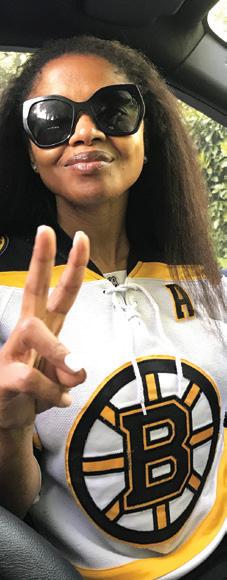

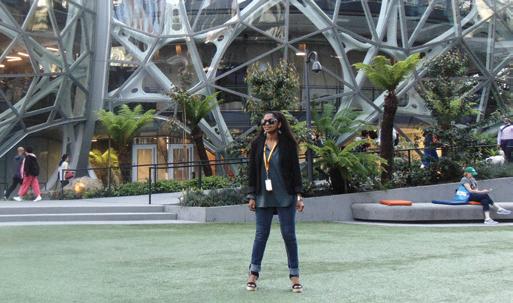

The power of networking and Wits’ impact in Africa through its graduates are both part of the story of Yasin Mahadi, a climate change and disaster risk management consultant at the World Bank Group in Nairobi, Kenya.
“I am from Moyale in northern Kenya and after I completed my undergraduate degree at Moi University I went to visit my sister, who lives in South Africa. She introduced me to a friend of hers who was doing his PhD at Wits and he invited me to visit the campus. I went to see the Faculty of Science, as I was interested in studying further in environmental science.”
The outcome was that Yasin secured a scholarship and postgraduate merit award from Wits to do his MSc. He says he loved being at Wits, attending all the events the University offers and mixing with scholars from all over the world. After graduating he wanted to work in South Africa, and successfully applied for an exceptional skills work visa (now called a critical skills work visa). He then applied for permanent residence in South Africa, but during the lengthy process he was offered a job in Nairobi
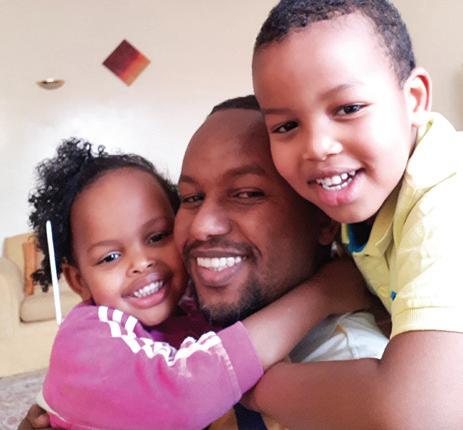
CLIMATE CHANGE AND DISASTER RISK
MANAGEMENT CONSULTANT
LOCATION: NAIROBI, KENYA
MSc 2009
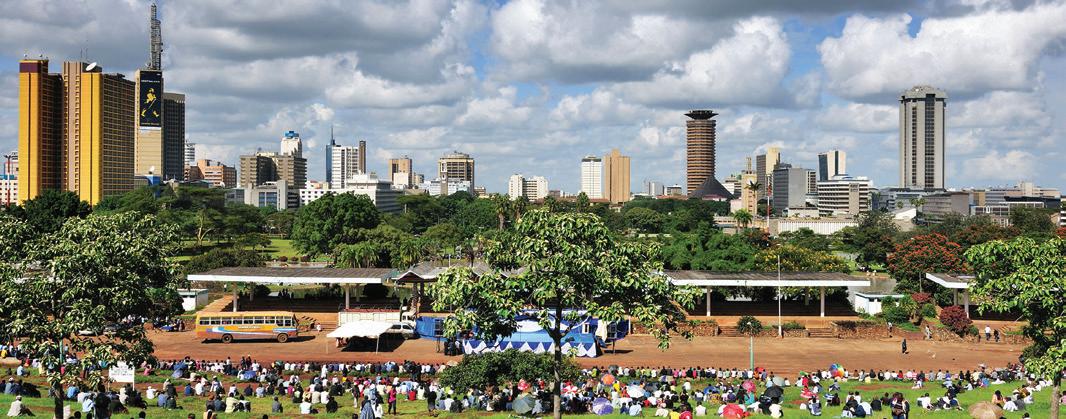
with UK-based Camco Advisory Services.
“I had been for an interview with the same company in South Africa but they required the work permit or permanent residence status.” The director then sent Yasin’s CV to the Kenya office and he was employed there as an analyst on Camco's regional programme.
The work included carbon analysis of indigenous forests and community conservancies. “Carbon credits from these forests are bought by companies wanting to offset their carbon emissions, and the resident communities benefit from the income for conserving the forests.”
After two years with Camco he moved to the International Union for Conservation of Nature regional office in Nairobi,
working on building resilience to drought and climate change. This focus on land and water management continued in the World Bank position he took up in April 2018.
“Kenya is the first country in Africa to develop its own Climate Change Act and the government is setting up a Climate Change Fund,” Yasin says.
“People are feeling the effects of climate change, including water scarcity and declining agricultural production. Rural people talk about how their lifestyles have changed; how they have to walk long distances to get to water because closer sources have dried up, and how conflicts are increasing as communities run out of grazing and move onto other people’s land.”
Yasin works closely
YOUR STRATEGY WILL NOT REDUCE POVERTY AND ENHANCE PROSPERITY
with communities to find solutions for water and agricultural sustainability.
“It is exactly the kind of work I have always wanted to do, and I have been able to spend time in several countries in Africa, as well as the UK, France, Canada and Brazil, and see the progress of climate change projects I have initiated.”
A large part of his work requires travelling to deep rural areas in the region. This year he has spent time in northern Kenya.
“Some areas are not that safe, but I know how to handle things because I’m from there, I speak the

local languages in addition to English and Swahili, and it feels good to be working with my people.”
He’s impressed by rural people’s knowledge of what’s required to conserve resources like water and soil. “To avoid overgrazing and land degradation they build temporary water infrastructure like subsurface dams in river banks where the livestock drink for a time and then move on to the next grazing area.” This allows vegetation to grow again. The World Bank gets involved by, for example, offering technologies to improve water quality.
“The best approach when engaging with communities is to avoid telling them what you know and to rather listen and learn from them, then discuss how you can build on this together. They
are the ones who need to manage and sustain the systems.”
The World Bank engages with executives and law makers at county level to build climate resilience into local development planning and financing. Yasin’s most recent climate workshop was in Kwale county in Kenya. “This county has a beautiful town on the coast called Diani. Tourists from all over visit and the beach is rated as one of the best in the world.”
However, Kwale county has coastal flooding and inland droughts – both on the increase.
The reason the World Bank is so invested in the region, Yasin says, is that “if you invest money for development without managing climate change and disaster risk, your strategy will not reduce
poverty and enhance prosperity.”
Yasin and his wife Ramla Abdi have three young children – son Yahya (5) and daughters Fatima (4) and Sumaya (1). Ramla works for a parastatal in the energy sector. They live in the Nairobi neighbourhood of Kilimani. “There are mostly apartments here and it’s crazily expensive to buy your own home, so most people rent, as we do. With young children we spend a lot of time at home and we take vacations at the coast. We like to eat at home but I have to say I’m a very poor cook. Fortunately my wife really knows how to cook. There are lots of indigenous spices available and the main meat dishes here are chicken and goat.”
Asked which is his favourite country in Africa, he smiles and says “they all have their uniqueness”. Naturally he loves his home country but he has a soft spot for South Africa. “It has lots of opportunities. I was intrigued by the rainbow nation and how people interact and address the challenges that come with such diversity. I am very thankful to South Africa and Wits for paying my fees, as it enabled me to contribute to the part of the continent that I call home.”
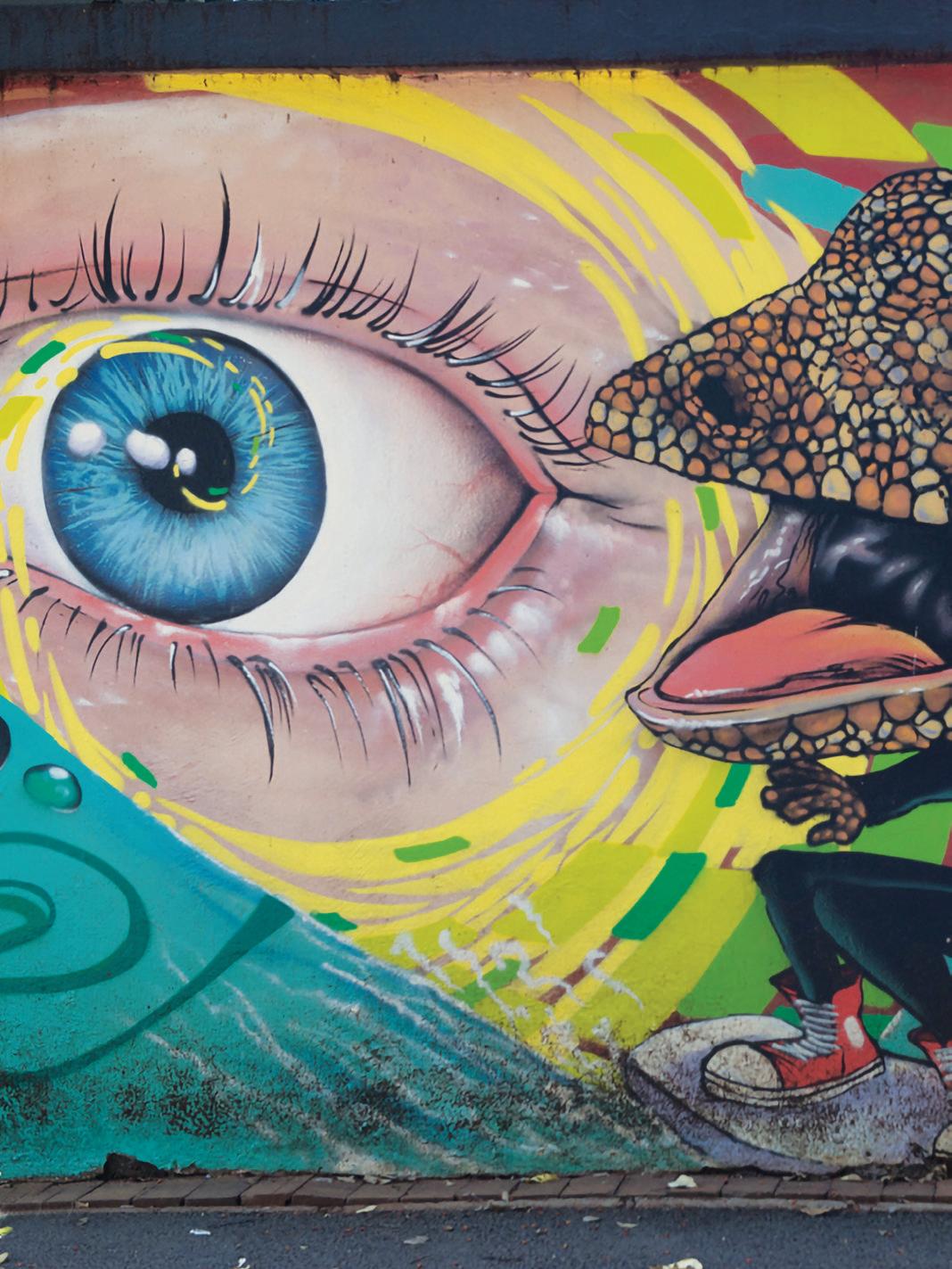
BRAAMFONTEIN AND OTHER SUBURBS THAT TOUCH SIDES WITH WITS UNIVERSITY HAVE LONG BEEN KNOWN FOR GRAFFITI AND STREET ART
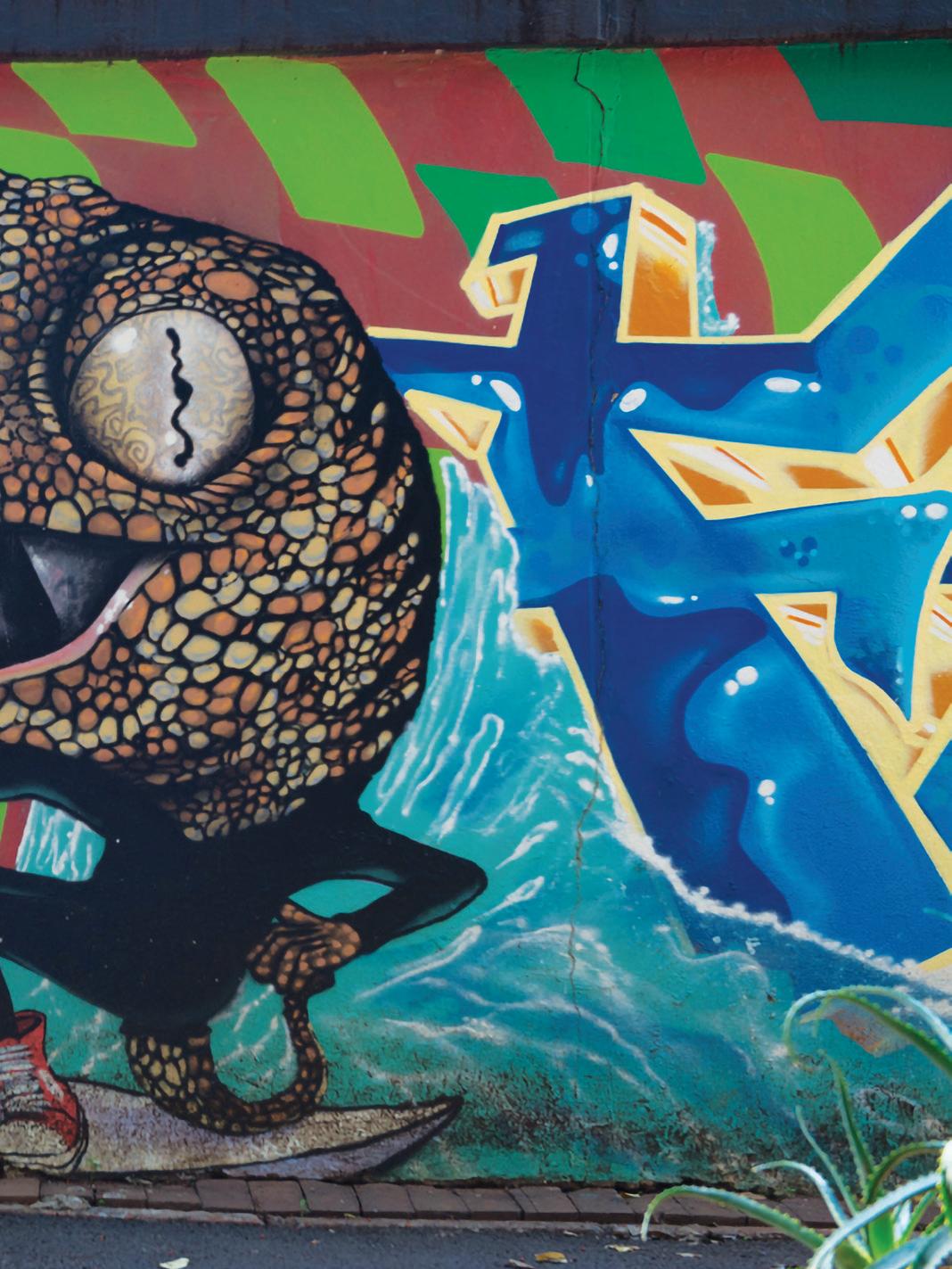
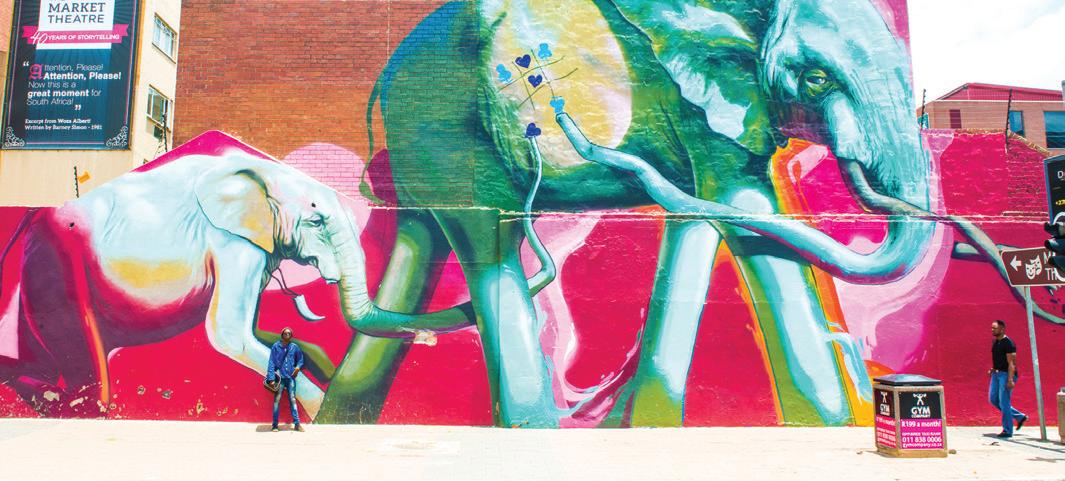
The elephants arrived in the first weekend of October last year – some on buildings headed towards the train tracks, a pair down an alleyway, others on a rooftop. By the Monday, Braamfontein had its graffiti herd.
The pachyderms of whimsy were imagined from spray cans and the hand of graffiti artist Falko1 in spring last year as part of the City of Gold Urban Art Festival. The street art festival has been
running for six years in Johannesburg and attracts local and international street artists, sponsors and visitors.
Falko1’s ellies were newcomers to the neighbourhood, but Braamfontein and other suburbs that touch sides with Wits University have long been known for graffiti and street art.
Years back The Star established a graffiti wall at the intersection of Jan Smuts Avenue and Empire Road. It was one of the

CHALLENGING NORMS, IS WHY GRAFFITI IS A LITTLE BIT ABOUT TROUBLE MAKING
first blank city canvases to be sanctioned for scrawls of public sentiment. Sometimes there were clever slogans, sometimes posters for events, occasionally an artistic gem. Everything lasted only until a new coat of paint returned the wall to white, ready for whoever got to the wall next.
In the early 2000s urban revival and investment in public art by the Johannesburg Development Agency meant Braamfontein welcomed
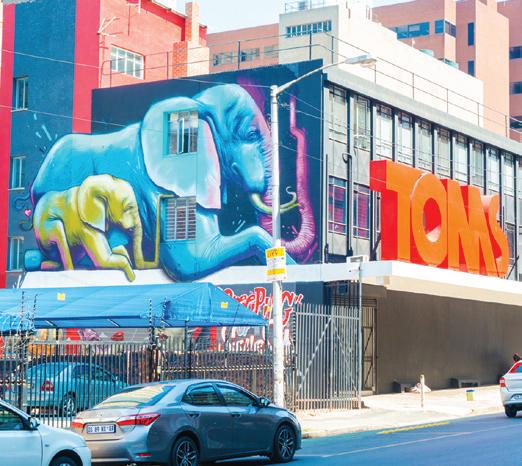
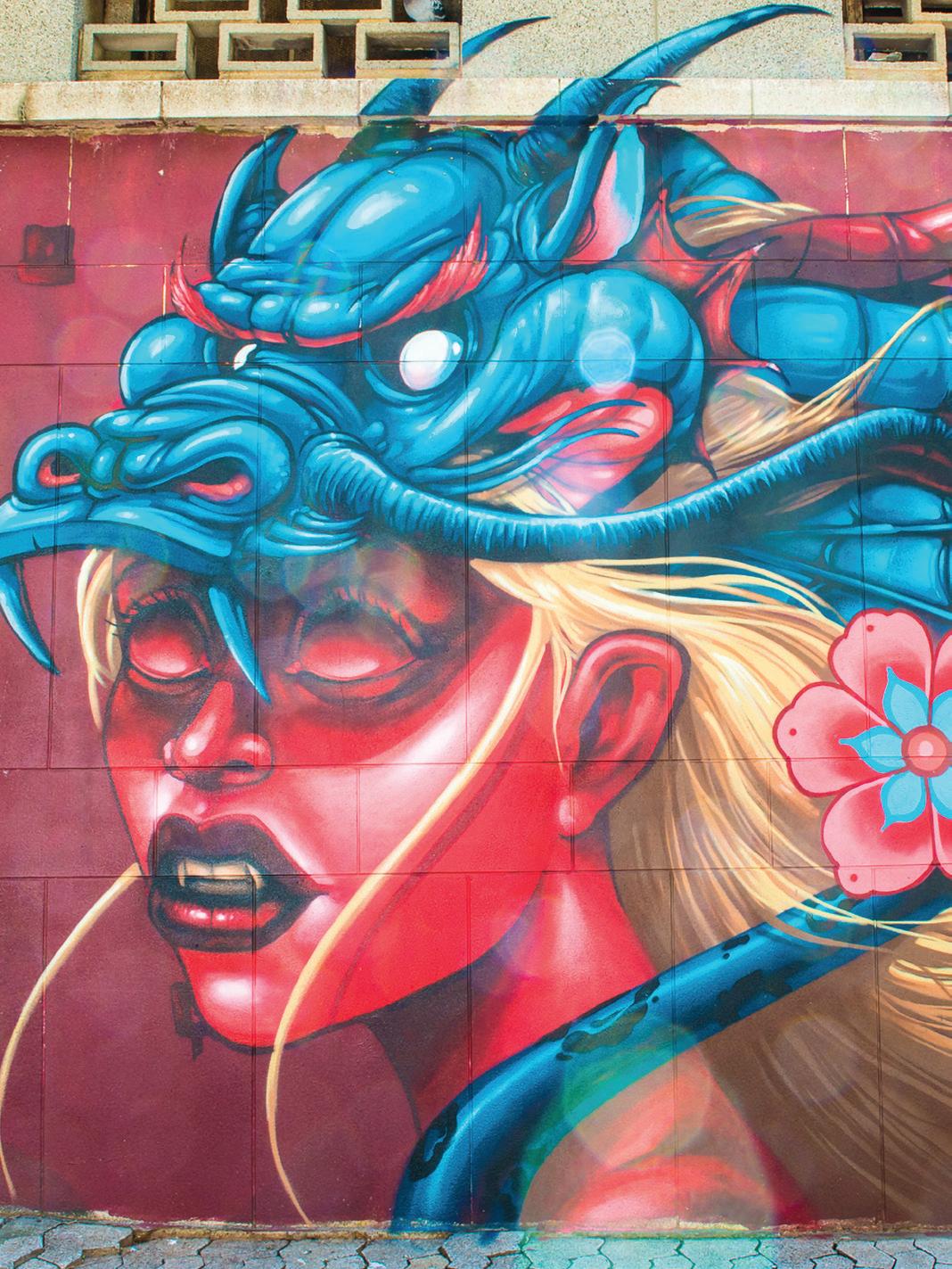
GRAFFITI ADDS CREATIVITY AND DIMENSION TO GREAT CITIES OF THE WORLD, AND JOBURG IS CATCHING UP
Braamfonteinthe likes of Clive van den Berg’s Eland , installed at the very spot where the “white waters of the rand” split in two directions. Metal trees sprang up along Juta Street at about the same time, and William Kentridge’s Fire Walker strode across the Queen Elizabeth Bridge. They showed that art could belong on the streets, not only in an accesscontrolled gallery space or under constant guard.
a 20-storey building on the corner of Melle and Jorissen Streets (see Wits Review October 2018). In the same year the South African Music Rights Organisation building, visible from the M1 motorway, got a bright yellow mural makeover courtesy of artist Breeze Yoko.
stencilled slogans like “A luta continua” and “Hobos can’t eat bicycle lanes” –they’re meant to make the wait at the traffic lights a little uncomfortable.
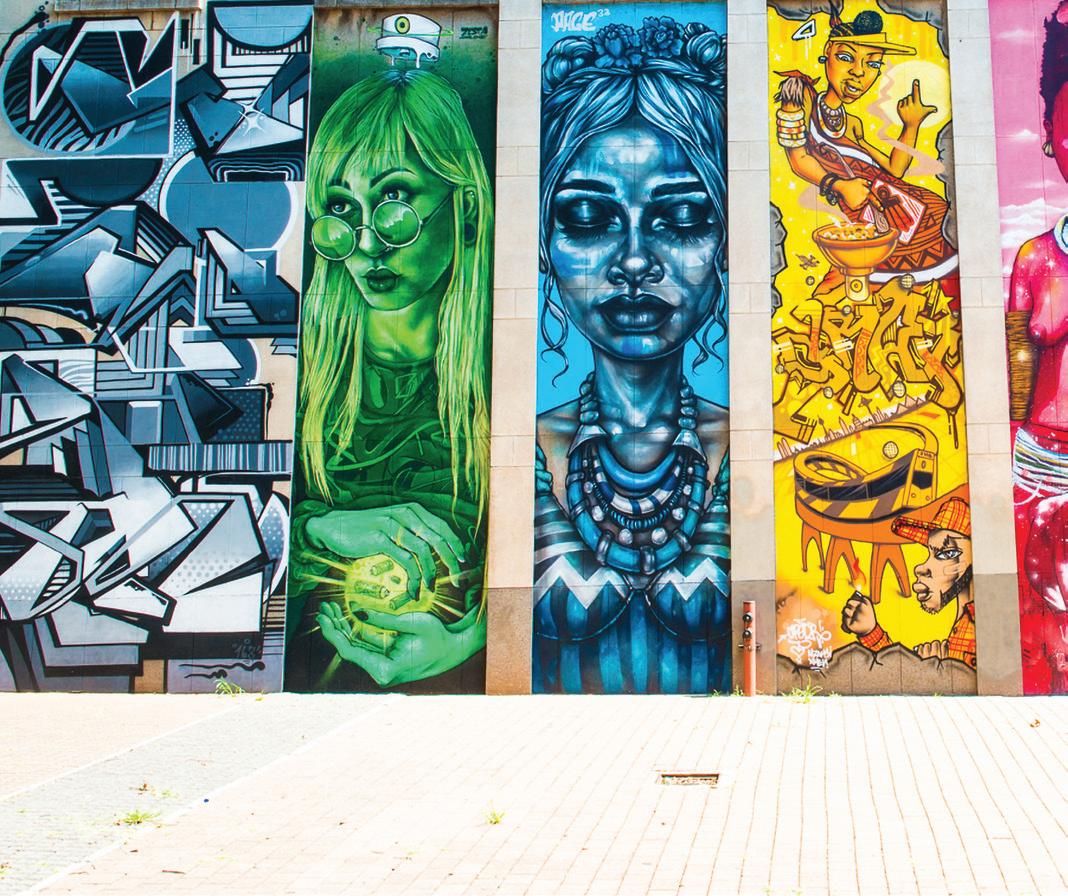
In more recent years, the development of the Rea Vaya bus routes has turned the glassed bus stops into a set of original artworks for public consumption.
Last year Hannelie Coetzee’s Nzunza/ Ndzundza portrait, made of 2 000 salvaged ceramic plates, edged up
These are commissioned projects with big budgets, crews and funding and they don’t stir controversy. They’re the opposite of commentary such as Greenpeace’s stencilled works about water as a human right. These stencils have found their way under the M1 flyover where many homeless people are forced to take shelter at night. Just outside Wits’ gates are
Graffiti, tagging (a simple artist signature), throw-ups (stylised artist signatures) and street art, public art and murals are discrete categories but they share the characteristic of being ephemeral, communicating in a public space as visual expression or commentary.
Braamfontein joins the likes of Maboneng and Newtown as established graffiti destinations in the city. Braam has the edge in that it’s home to Grayscale gallery and art supply store, a magnet for graffiti enthusiasts. Grayscale is owned by


 Graffiti on Wits West Campus
Graffiti on Wits West Campus
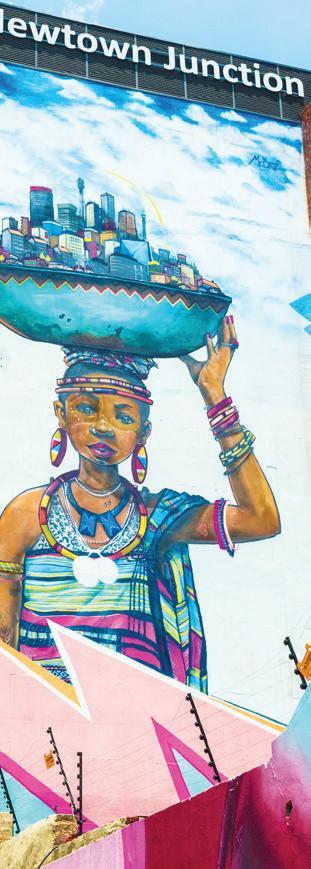
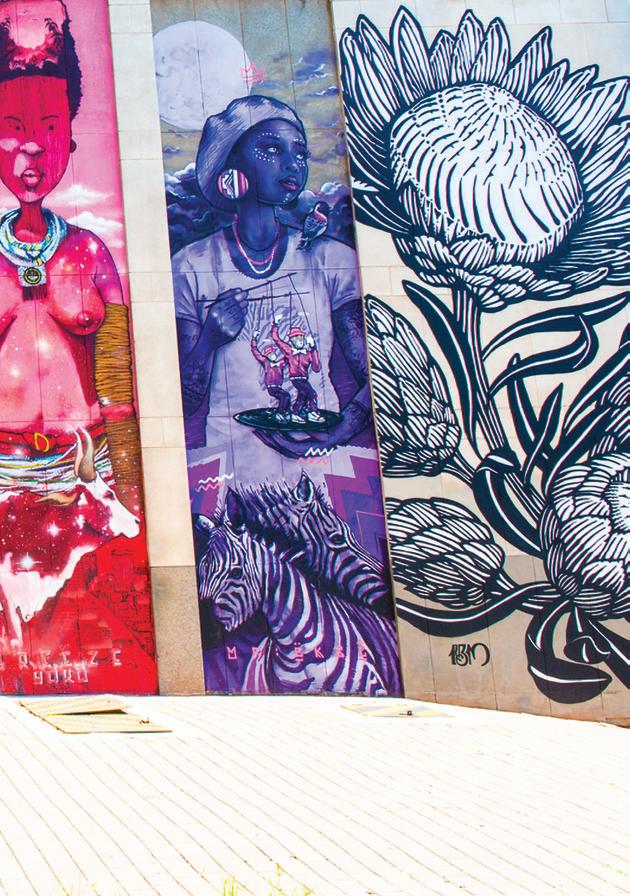
well-known graffiti and tattoo artist Rasty, who’s an organiser of the City of Gold festivals.
Another champion of Joburg graffiti is Wits archaeology graduate Jo Buitendach (BA 2008, BSc Hons 2009), cofounder of tour company Past Experiences. She says graffiti adds creativity and dimension to great cities of the world, and Joburg is catching up. Sharing it with visitors is her passion.
“On a graffiti tour you have to walk, and walking the city you get to experience people differently and you get to parts of the city that might be considered dodgy but have been revived by graffiti artists,” she says.
Buitendach says graffiti has a complexity; also a
code, culture and a quality of being underground or at least fringe. Yet it’s also there for everyone. This inclusivity deepens connections and people’s sense of belonging, identity and place. She notes that “Braamfontein has been laid out with alleyways, the perfect place for graffiti artists to work in.”
Graffiti artist Bias, who is also a Witsie, says the medium’s fleeting and uncontained nature is part of its appeal. It challenges ideas of ownership, control and attachment to permanence.
Challenging norms, Bias says, is why “graffiti is a little bit about trouble making”.
He recognises that tagging may still be seen as vandalism by some or
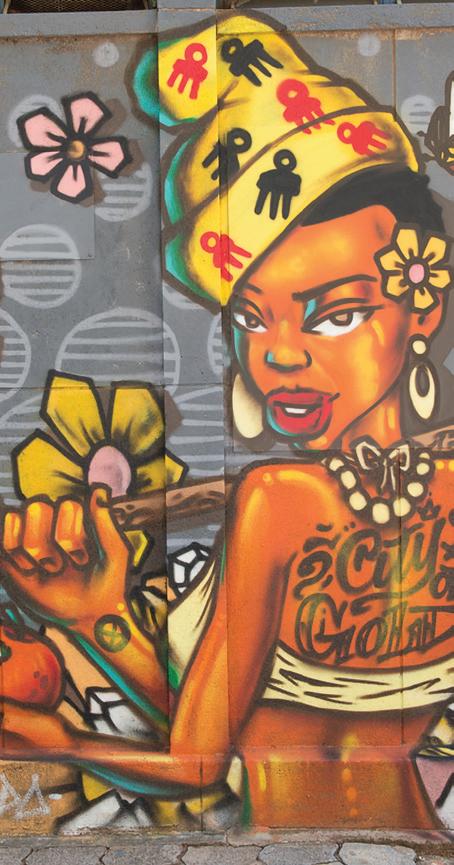
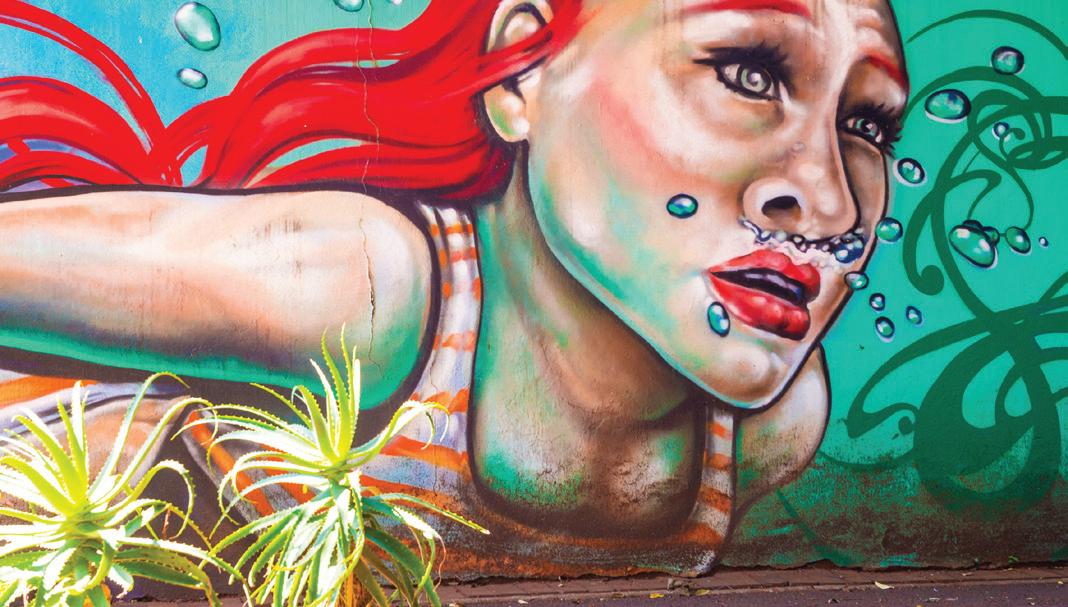
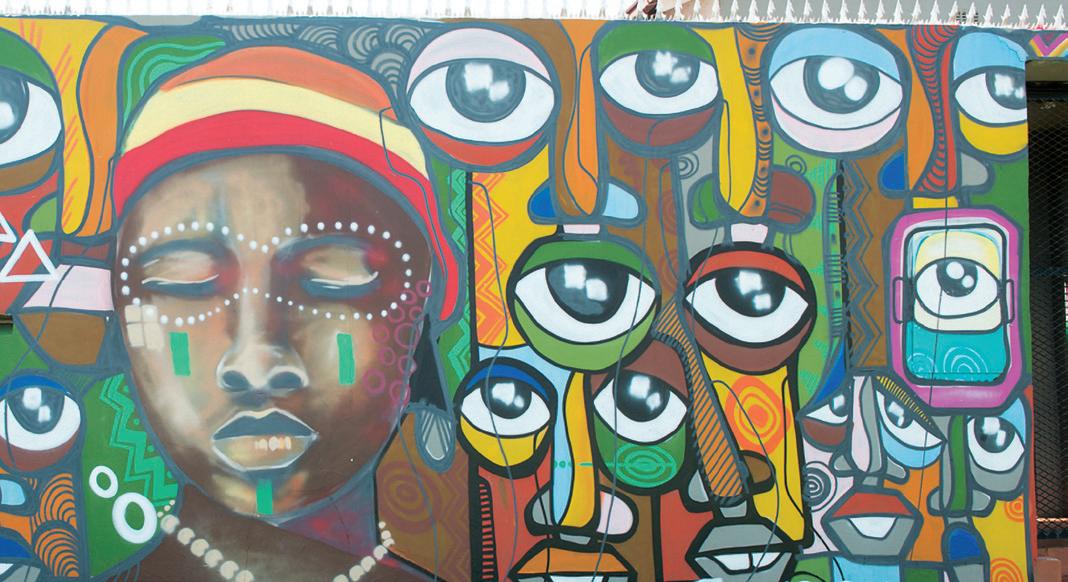
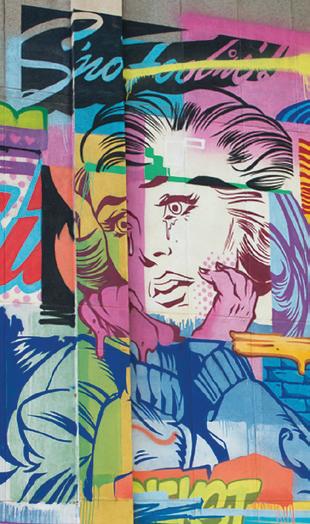
that commissioned work can be written off as selling out to big money. Bias says there’s a role and place for all of it and what gets produced may be highly personal or purely pragmatic.
“For some artists, tagging is about being seen, like building a portfolio and communicating with other artists. Sometimes someone will just do a quick tag because they may not have had the time to hang around at that location or they may not have had the money for paints to create something more elaborate,” he says.
Dr Alexandra Parker (BAS 2005, BAS Hons 2008, MArch 2009, PhD 2014), a senior researcher at Gauteng City-Region Observatory, and her colleagues Samkelisiwe Khanyile (BA 2014, BSc Hons 2015, MSc 2016) and Kate Joseph (BA Hons 2010, MA 2012), have been researching graffiti in the city for some time.
“We found that graffiti can be a sign of an area getting investment. It’s also become a way to landmark particular areas in the city.
“At the opposite end, graffiti is still a tool for people who feel they don’t have a voice – it’s about activism, rebellion and urban commentary too,” says Parker.
Graffiti is different things to different people. It could be the commercial gig that pays the bills, a tagger’s craving for public infamy or raising a middle finger to the mainstream. For another it could be an urban rejuvenation tool, or about teasing the social media horde with tidbits of a seemingly elusive subculture.
Understanding these evolving elements of graffiti and their impact is at the heart of the GCRO team’s research. They’re working on developing a smartphone app that will map graffiti in Joburg and expose more people to its culture. Parker says it will show people where to find interesting works, explain artists’ processes and become a digital archive.
Over time that archive will be a record of ghosts and memories because in real life graffiti fades, is painted over, becomes rubble – the perfect fit for a city of constant metamorphosis.

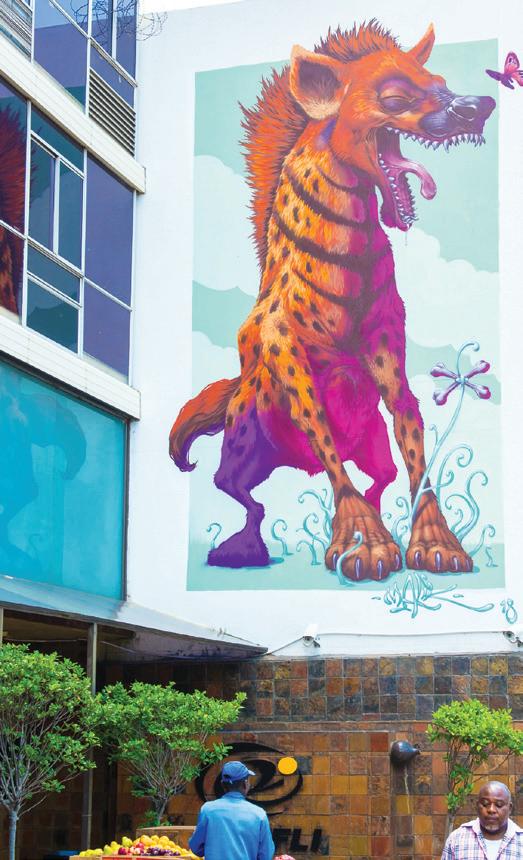
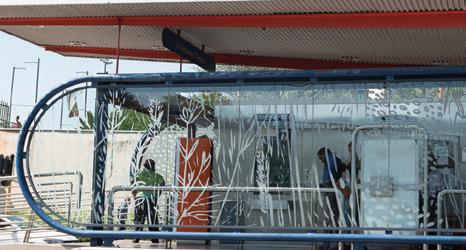 Rea Vaya
Rea Vaya
The words “entomology” and “anthropology” can sometimes be confused with each other, and perhaps there isn’t such a gulf after all between the study of insects and that of people. This book rolls them up together in a nutritious feast.
By following what people have known and believed about dung beetles, the book traces the development of our understanding of the world more generally. It’s a history of science, taking us from ancient religious beliefs to a modern view. Along the journey, readers can learn about the relationships between art, genetics, socioeconomic power, ecology, biological control and more – meeting interesting characters and getting a sense of the excitement intrinsic to science itself. Why should dung beetles be our guides? Why are they “the pin-up
creatures of evolutionary studies” and “stars of the new biology”? Their clearly defined habitats, their diversity and vast numbers, and the ease with which they can be observed are all advantages for scientists studying population dynamics, animal behaviour and the way new species arise. Dung beetles don’t seem to have any harmful effects on their environment; rather, they improve soil and water quality by recycling waste.
The ways they orientate themselves and navigate their journeys; the possibility that they use their acute sense of smell for communication; the unanswered questions about their diets; the potential for technology based on what dung beetles do; their contribution to controlling greenhouse gases – all these topics make for a stimulating read.
The authors end with
Wits
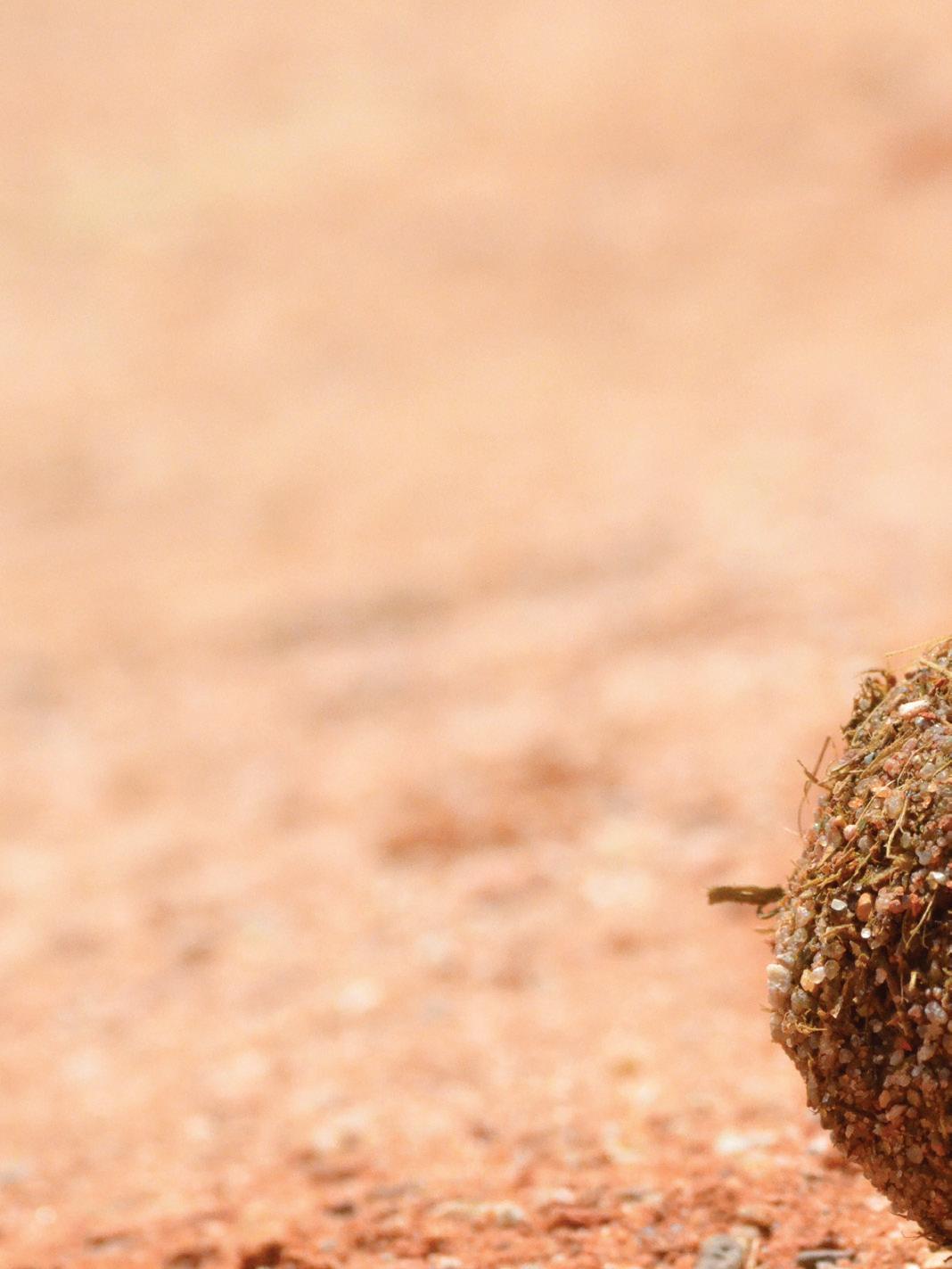
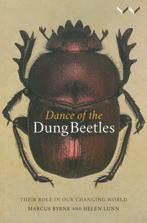
a reminder that we don’t have unlimited time to learn all about the “complex and magnificent” processes of evolution and the deep interconnection of the world. Humans are fast using up the riches of the planet and risk losing everything. Insects are at the bottom of every ecosystem and we don’t know why their populations are declining so fast or exactly what the consequences will be, says Marcus Byrne.
But doom and dry facts don’t dominate this book. It has humour and an urgency born of joy in the subject.
Marcus Byrne (PhD 1998) is a professor in the School of Animal, Plant and Environmental Sciences at Wits and has studied dung beetles for more than 30 years. He says this became his
IT’S A HISTORY OF SCIENCE, TAKING US FROM ANCIENT RELIGIOUS BELIEFS TO A MODERN VIEW
University Press, 2019field by chance, when he needed a job and ended up as a laboratory assistant at the Dung Beetle Research Unit in Pretoria. Not the least of his achievements is the 2013 Ig Nobel Prize, given for “research that makes people laugh and then think”. He is now working on beetle vision and olfaction, and on light pollution (urban entomology).
Helen Lunn (BA 1975, BA Hons 1979, MA 1986) is a science communicator and musicologist. Credited by Byrne as being very
organised, she says it was easy to work with him and one of the things she learned through the project was a greater appreciation of botanical art. She says there needs to be a balance between specialisation in science and making broad sense of the details.
Publisher Veronica Klipp says this book is one of the Wits University Press team’s favourites. The journal Nature chose it as a pick of the week and called it “captivating”.

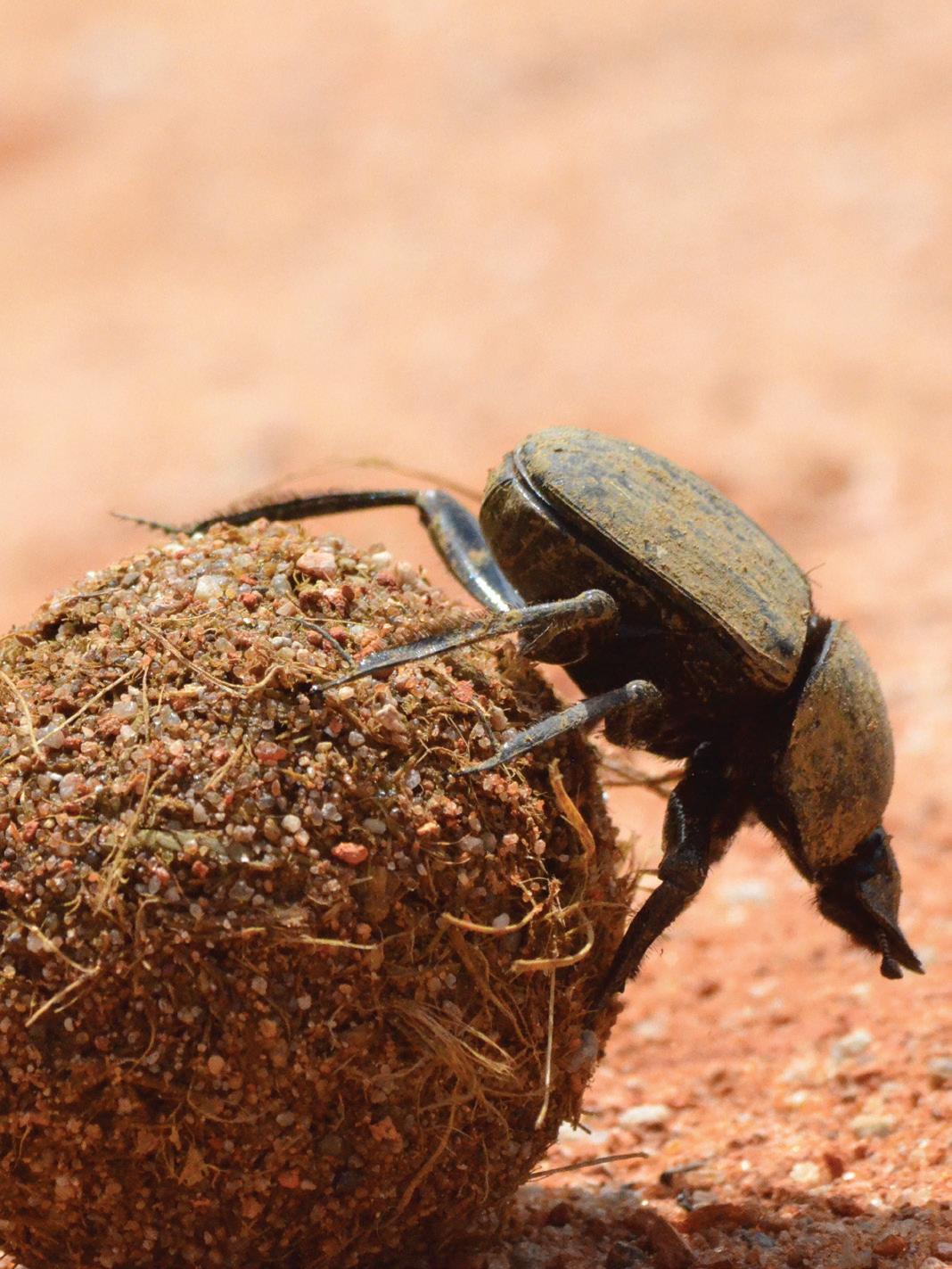 Marcus Byrne (left) and Helen Lunn with Simon Gear at the book launch
Marcus Byrne (left) and Helen Lunn with Simon Gear at the book launch
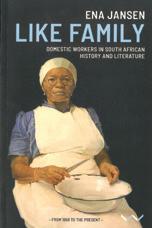
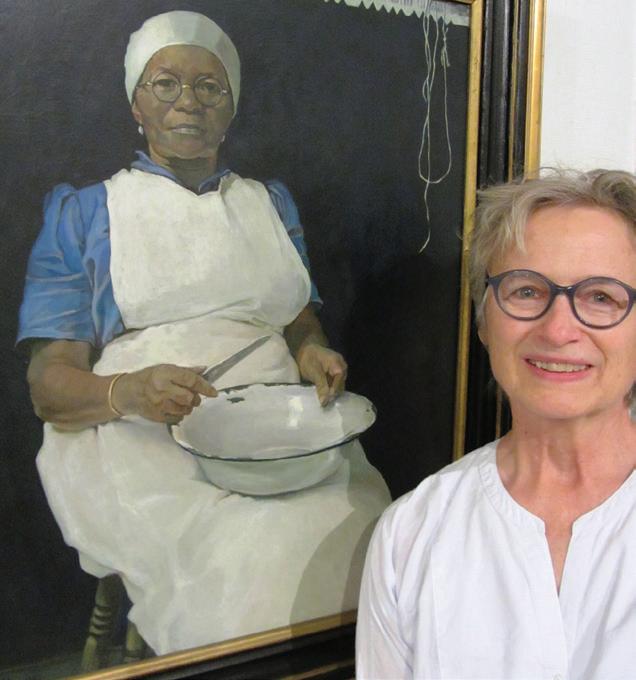
Previously published in Afrikaans and Dutch, this “blend of sociology, history and literary analysis” has been updated and reworked into “a completely new book”, according to the author, Ena Jansen (PhD 1992). Drawing on the work of a number of Wits academics among its sources, the book outlines the history of domestic labour in South Africa, relates people’s experiences, and looks at how domestic workers have been represented in literature.
When she was teaching South African literature at the University of Amsterdam, Jansen’s interest in the subject was sparked by the figure of Krotoa-Eva, a woman employed by Jan van Riebeeck as a nanny and later as his mediator in the Cape. Slavery in the Cape laid the foundation for the paternalistic culture of domestic work in South Africa, she asserts. This culture became “a peculiar, often contradictory form of duty and dependency”.
University Press
Alumni get a 10% discount on books published by Wits University Press. Link: witspress.co.za/
“The lives of practically all South Africans have been touched by the institution of paid domestic work: either because of the presence of an often motherly carer and cleaner, or by the absence of a mother who does paid housework for others.” Jansen points out that “during the past couple of years research has shown that white people often construct their memories of apartheid around domestic workers, realising that the ‘learning’ of white dominance hinges on their contact with black women in the home.” Many white South Africans have mixed feelings of nostalgia, love and guilt about these women. Even under new laws, the relationship is still a complicated entanglement at the frontier of inequality. It was only in May 2019 that the High Court in Pretoria ruled that domestic workers can claim compensation for getting injured or sick at work. A recent Stats SA report gives the number of domestic workers in South Africa as about one million and says about 15 000 lost their jobs in the first quarter of 2019. The average national wage they earn is reported to be R2 699 per month.
IF YOU WERE THERE IN 1970S SOUTH AFRICA AND REMEMBER THINGS LIKE BOLERO TOPS, GHOENS AND PETROL STATION STICKERS, IT’S TEMPTING AS A READER TO GIVE IN TO A DELICIOUS SWOON TOWARDS NOSTALGIA

“You’re writing a book about Muhammad Ali?” asks one of the brothers in Ivan Vladislavic´’s latest novel. “No, no,” comes the reply. “It’s not about him, it’s about us. Our lives together.” The character’s childhood scrapbooks of newspaper cuttings about the boxer are a reminder of “what we thought and did in the past”.
As the publishers of The Distance put it, the author “unfolds a small, fragmentary story of family life and boyish ambition, illuminating the origins of a writing life and the limits of language”.
Shifting between the past and the present, the Verwoerdburg-raised Blahavic´ brothers think about their lives so far, and about how much time and space they have left to be, to slug it out, to speak and to be heard. The reader is invited to think about the distance between
selves; the gaps between memories and facts; between two people’s memories; between what matters and what gets attention; what is said and unsaid; lyrics and voice; the observer and observed. Life, perhaps, is the art of getting close enough to touch and staying far enough away to survive –whether you are a writer, a boxer, a housewife with locked-up dreams, or anyone else.
Teenage brother Joe’s choice of Muhammad Ali as a hero gives him a way of defying his father and all authority. Part of the boxer’s appeal is the way he redefines himself and claims his power. Joe loves his stroppy talk and longs to be “a floating poem” like him. As a grown man, he worries that his Ali archive is silent after all. Older brother Branko notices more, listens, looks, edits. “The hand can’t hit what the eye can’t see.”
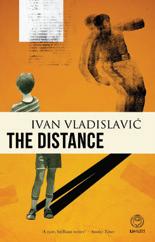
If you were there in 1970s South Africa and remember things like bolero tops, ghoens and petrol station stickers, it’s tempting as a reader of this book to give in to a delicious swoon towards nostalgia. And there’s the sheer, hilarious enjoyment of words and names.
But there are also reminders here of the dreary, cruel South Africa. “The world used to come to us like this” – silently, delayed, without motion, in newspaper cuttings. And when you chose what was worth keeping you inadvertently kept a record of something else on the reverse of the cutting.
In the book, as the age of television arrives in South Africa, the world almost gets too close and too big to focus on. And now the Internet explodes our attention even further; “there’s no frame”; “the story is too big”. What sense will another generation make of it all?
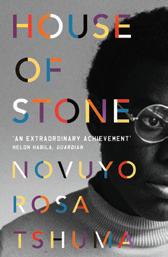
In this novel of Zimbabwe’s history, the yearning for a connection with the past is as strong as the urge to disconnect from it and forge something new. Displacement and inheritance, claiming and overthrowing, continuity and revolution, create a tension that seems to have no end.
The narrator, Zamani, has returned to Bulawayo from London. His place in his old home has been usurped and, armed with technology and other expensive intoxicants, he finds a way to insert himself back into something like that home. He is looking
When the publishers asked him to write this book about the student protests over university fees in 2015 and 2016, Wits Vice-Chancellor Professor Adam Habib was sceptical. “I recognised that I could not be dispassionate, being a prominent participant in the protest events.” But he decided it could be about the reasons for his decisions and could offer ideas for the funding of higher education. It “could serve as one of the sources for the more dispassionate analytical studies that would emerge”.
Habib writes: “I offer this book as one contribution among many to enable an understanding of the student protests,
for “strong family roots in which to build my legacy”, but he is basing his “grand project” of redemption on deception and false stories. He wants his past to be one that he determines, not vice versa. What he calls “hi-story” is a “fiction of many versions” and if he can transcend it he can “rule the future”.
Again and again in the “family chronicles”, children are born but their lives come to nothing; ties are tenuous. As Zamani discovers more about his surrogate family, his real roots and his own power to manipulate people, he is »
their structural and immediate causes, their character and implications, and the potential solutions and trade-offs confronting us as South Africans.” He adds that he hopes the book can contribute to healing the divisions of the past. He was also concerned to lay out the facts about what happened, in contrast to caricatures and illinformed perceptions.
The Wits executive’s challenge, Habib writes, is to balance competing academic and social priorities. “The students’ discontents were undeniably legitimate.”
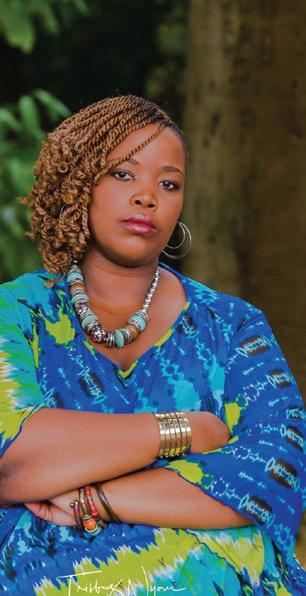
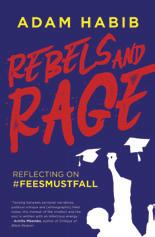
IF YOU DESTROY UNIVERSITIES YOU CAN FORGET INCLUSIVE DEVELOPMENT
But Wits’ financial sustainability had to be considered. He has suggested a contingent loan scheme as the most practical way to fund higher education over the medium term. Universities can challenge inequality by conferring credible degrees that enable social mobility. Allowing the quality of teaching and research to decline would harm the poor more than anyone else, because they cannot afford to study or work elsewhere. Vice-chancellors cannot defend their institutions single-handedly, he said –the whole nation should be doing so. “If you destroy universities you can forget inclusive development.”
seized by fear, grief, disgust – and a growing malice. Having lost everything that tethered him firmly to a past, present and future, he feels justified in pressing on with his terrible project.
House of Stone, described variously by reviewers as “hilarious, horrifying, disturbing, enthralling, original, multilayered”, won the 2019 Edward Stanford Travel Writing Award for Fiction with a Sense of Place.
Novuyo Rosa Tshuma (BCom 2013) received the Rockefeller Foundation’s Bellagio Center
Wits Chancellor and alumna Dr Judy Dlamini found that her first book, Equal But Different , gave her a new purpose: “giving voice to Africans who live a life of significance”. Her purpose with this new book is to tell “a story that humanises us, that repairs our broken dignity, that empowers us and the generations which follow … the stories I want my grandchildren to read over and over again, till they see themselves and other Africans in them.”
The book is a collection of Dr Dlamini’s conversations with 12 African leaders, entrepreneurs and achievers – people who have not only done well but helped others.
Tanzanian entrepreneur Ali Mufuruki is first up, speaking about hard work,
Literary Arts Residency Award. Her 2013 short story collection, Shadows , won the 2014 Herman Charles Bosman Prize. She co-founded the pan-African arts platform Jalada and is a fiction editor at The Bare Life Review, a journal of refugee and immigrant literature based in California.
Interviewed by fellow Witsie Joanne Joseph on Radio 702, Tshuma said she wanted her story to entertain as well as inform. She experimented with the premise of elderly, distraught parents with a missing son and a devious
discipline and integrity as being key to his success.
“If we want Africa to work well,” he says, “we Africans have to roll up our sleeves and fix it ourselves.”
Another of the outstanding people interviewed is Witsie Nhlanhla Dlamini (BCom 2005), founder of the agribusiness Maneli Group. He featured on the Dean’s List of top achievers at Wits and was president of the Golden Key International Honour Society. The discussion with him touched on the way he felt when he first arrived at Harvard and Oxford (lonely, anxious and stupid, in his words), and how important it was just to talk about that and discover that he wasn’t the only one feeling that way.
Someone who has seldom sought public
lodger, in order to tell a larger story. “What is Zimbabwe? What are we? How did we get here?” were her questions, as she set out to explore her country’s complex history. “For me, Zamani is Zimbabwe. He embodies the best and the worst,” she said.
Sanitising a liberation struggle detracts from its value, she told another interviewer.
The novel was written as part of a degree at the University of Iowa. Tshuma is now working on a PhD, a book set in Iowa City but with an African connection.
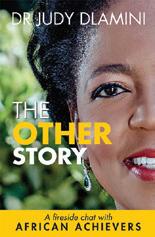
attention is Zanele Mbeki (BA Social Work 1964). In the book she speaks about early days working with Winnie Madikizela-Mandela (BA 2005) before either of them married men who would become President of South Africa. She also talks about her work with Women Development Bank. Dr Dlamini’s questions probe family backgrounds, attitudes to education and work, religious beliefs, leadership characteristics, experiences of being in other countries, personal driving forces, Africa’s future and so on. “The similarity in the responses was quite remarkable,” she writes in the final chapter. All the respondents put a high value on family, education and an environment that built their confidence.
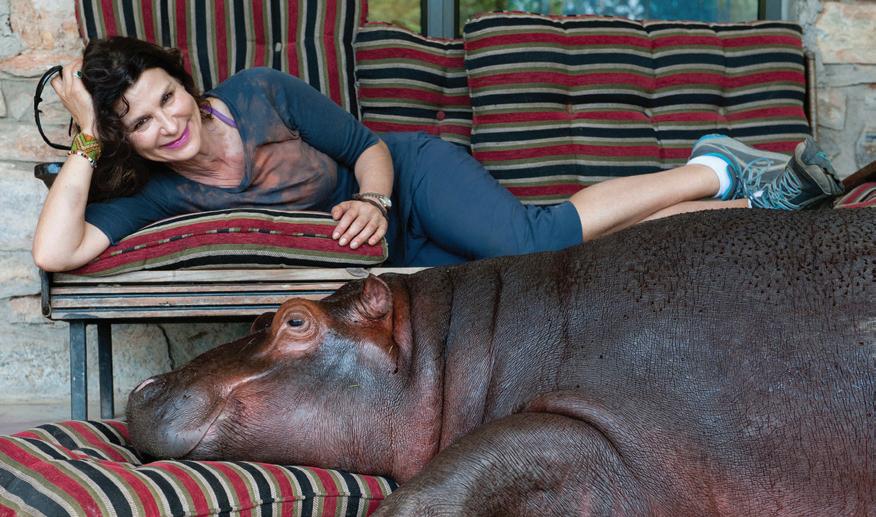
The Year of Facing Fire is a gripping and thought-provoking memoir by writer and actress Helena Kriel (BADA 1982), recalling her brother’s illness and death. She writes with a vivid, poetic intensity, and her subject is a big, deep one: what do we have to do in this life?
As a series of losses befall her brother Evan and the family, there is something to learn from each of the array of healers, holy men and lovers in their lives. Surrender is the idea that keeps emerging as the answer, but it’s hard to accept what doesn’t seem right or fair.
And yet: “When faced with someone getting very sick and dying, life becomes ever brighter,”
Kriel says. “The beauty of love and friendship happens. People show up for you.” This unexpected love was what the family was left with after their year of facing fire – a year that changed them all and made them more resilient and indeed playful, she says. This playfulness was a gift. To people who feel they have to face hard times alone, she advises finding beauty in the world. “In finding beauty you are not alone. The situation is giving you something powerful.”
Kriel’s experience in
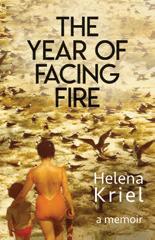
the film industry shows in her dialogue, lively pace, imagery and sense of place. She says being open and receptive to the world allows things to strike you, and then you have those things in you to write about.
She has written for stage and screen in South Africa and Los Angeles, including Kama Sutra: A Tale of Love with director Mira Nair and the South African movies Tsotsi and Skin . She teaches screenwriting in the US and leads creative journeys to India. She is also the founder and president of Baby Rhino Rescue, and is working on a book about the rhinos she has encountered.
THE BOOK SHOWS HOW THE PRACTICE OF PAINTING IMAGES FITTED INTO SAN SOCIETY. IN DOING SO, IT CHALLENGES THE WIDESPREAD NOTION THAT THE SOCIETY IN WHICH THE IMAGE-MAKERS LIVED WAS EGALITARIAN
This book by Wits Emeritus Professor David Lewis-Williams presents a new way of understanding huntergatherer rock art. In fact, it avoids the word “art” and focuses on image-making in the context of social relations.
Lewis-Williams says the approach he has taken here amplifies previous work by asking what impact the paintings in rock shelters had on San people. “The book shows how the practice of painting images fitted into San society. In doing so, it challenges the widespread notion that the society in which the image-makers lived was egalitarian. It that sense, the book may be termed a departure from the norm. Drawing on 19th and 20th century manuscripts and other sources, it shows that the images underwrote the social status of the admired, but also feared,
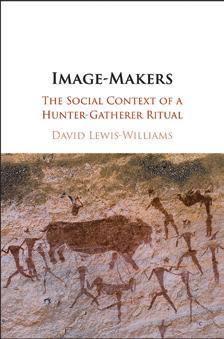
San medicine people or shamans.”
The author suggests that these images were “deeply embedded in daily social relations between individuals, between groups of people, and between people and a spirit realm. Moreover, they played a role in the construction and manipulation of those social relations.”
He asks whether this image-making was an ordinary part of life with a variety of “uses” such as recording events, or a special, religious kind of activity. From the ethnographic evidence, he finds that “the imagery is not an easily intelligible record of everyday events”; that “relations between images refer … to relations between people”. Also, he says, neuropsychology helps to clarify some of the imagery.
The book cover depicts San shamans capturing a
Cambridge University Press, 2019
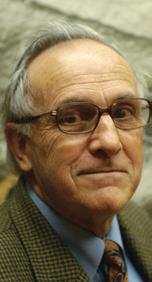
The royalties from this book will be donated to the Kalahari People’s Fund. The hardback is available from Cambridge University Press, which is offering a 20% discount until 3 April 2020: email mcowling@ cambridge.org.
San shamans capturing a “rain-animal” in the spirit realm
“rain-animal” in the spirit realm, and was chosen for the cover because it shows rain-makers achieving their ends.
Lewis-Williams founded the Rock Art Research Institute at Wits in the early 1980s and has published widely on San and European rock art. Among other honours, he received an honorary doctorate from Wits in 2006 for his rigorous, analytical scholarship, which has made an impact across various fields of study. He was instrumental in developing professional rock art research, and the Institute’s archive is a treasure for Wits and the world. In 2015 he was awarded the South African Order of the Baobab (Gold Class) for his contribution to archaeology. He is responsible for the /Xam wording in South Africa’s coat of arms: !ke e: / xarra //ke (people who are different come together).
Wits University fondly remembers those who have passed away
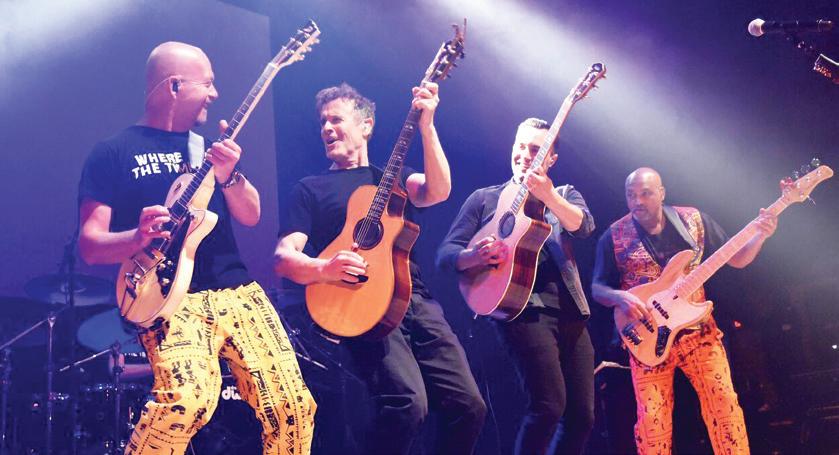
(1953-2019)
Sources: Wits University; Roddy Quin; www. johnnyclegg.com, UKZN, Image: Facebook, @johnnycleggsa
Legendary musician Johnny Clegg obtained his Bachelor of Arts (1976) and BA Honours (1977) degrees at Wits University and lectured in the Wits Social Anthropology Department for four years. He wrote several scholarly papers on Zulu music and dance and Wits bestowed an honorary doctorate in music on him in 2007.
As a singer, songwriter, dancer, anthropologist and musical activist, he showed what it was to embrace other cultures without losing your identity. Underlying his work was the idea of “crossing boundaries and mixing competing approaches”, he said. The approach of “being a cultural handyman, fixing and changing the world with anything you have at hand, has given life and meaning to what I do.”
He was 17 when he and Sipho Mchunu formed their first band, Juluka, which performed at the first Free People’s Concert at Wits in 1971. In 1986, at the height of apartheid, he partnered with Dudu Zulu to form his second band, Savuka. He also recorded several solo albums and enjoyed international success. He was diagnosed with pancreatic cancer in 2015 but continued to perform as long as possible. He leaves his wife Jenny and their sons Jesse and Jaron. At his memorial, Jesse (BA 2012, BA Hons 2013) said: “He was a vulnerable, generous and loving role model for my brother and I. He taught us to be curious about the world and to shape our lives around our passion. He believed the greatest gift that a father could give a son is a strong moral compass.”
For more than 45 years, Johnny and I were the closest of friends. When someone irrevocably goes from your life, and you know that memories are all you have, it is only with trepidation that you call to them, as, unshareable any longer with their shared origins, something essential to their meaning has gone forever. Yet, at the same time, that meaning that remains carries the full weight of a kindred lifetime, of spirit, of so much that never needed articulation beyond perhaps a knowing look, whose knowledge was full of… … Driving around the Yeoville of our ringing youth, guitars always present in the back of the car. Mons Road, Muller Street, Alpha Court, a chaotic bedroom, sticks, a shield, whitewall tyre sandals, like the ones that Bafazana Qoma would make when he finally managed to scrounge a place to sleep at the Wits compound, a concertina, umhupe bow, hand-made for the first time in someone else’s garden. The backyard room in West Street, with Sipho Mchunu, already having earned his praising as Down Below, leaping up to execute a giya , hands and stick whistling, unseeable from the unhearing house, at the sound of a Pondo scale I was playing seated on his high bed. My place in Becker Street, with the bell of Maddy Prior’s voice tolling out Long Lankin, and the Celtic echoes and snare clack that rang so resonantly with us both. Tuesday nights in the courtyard at the old Medical Research, he alive with the dancing, and its songs like Apollo 11, chronicling a unique perspective on this world and the world beyond it, tying concrete to an old night sky, and a cassette recorder misidentified as a television, at a time when such a thing could only be guessed at in South Africa. The worn dice thrown on the floors of backrooms in search of the elusive ’leven, rand notes clenched between teeth, snapped fingers and little pillars of cents scattering. The dusty comings and goings at George Goch, at Mai Mai, beer passed hand to mouth in a tin, he dancing, regardless. His demure figure seated, as yet still seated! on stage, beside me at the Wits Great Hall, evoking threads of magic from the strings of a Bellini guitar, and his harmonies sung, adding a special life to my songs, taking us away from where we had been. Sitting between
the bushes at Urania Street, thinking about other things. Dark days, when you had to work hard to experience Padre Padrone , or take a real chance to see Z , or take your courage to watch The Sorrow and the Pity , or The World at War , sixteen-millimetred into a deserted Central Block Sunday night. An attempt to buy a toasted sandwich at the Doll House, after a gig, in the hope that the midnight would obscure the sight of Sipho on the back seat, so that we could eat together, and laughing at them all when we couldn’t. And that laughter – always with us – in his narrow office at Wits, on the squash courts in Hillbrow till we rolled on the floor with it, at the rakish snooker tables in miscued disbelief, at the disreputable Space Invader machines in focused astonishment, over Scrabble boards, raucous, proclaiming words invented for the spur of the moment, crying with hilarity in my bass-player Lanny’s rehearsal basement over nothing more than the sheer magic of the brand new sounds we found we could make together, and the promise of it all. And years later, with promise reaching upwards, unbridled roaring at a table in Paris. The discussions about absolutely everything, but often about endlessly beckoning irreconcilables, with Vincent Gray – not yet Professor, but going there –in the Wits staff canteen in a restaurant which in another time revolved, and where once we had seen Barney Kessel eke a different kind of infinity from just six strings. I, sleeping on his floor, he, sleeping on mine, our lives changing, and changing our lives, readying ourselves as best we could, we thought, for what happens and what does not. GaRankuwa, Duduza, ThabaNchu, Qwa Qwa, Botshabelo, Ermelo and so many other nights in so many other places, the backs of vans, the fronts of trucks, the bottom of a bridge in London, the pages of my words. … And a million other things – all till the last kiss as we parted, both of us knowing the moment for what it was, and both seeing it so clearly in that look, that look that really never had to say anything at all…
I pay tribute to one who left, alone, much too soon. I pay tribute to my friend, to a man whose boy’s heart never ceased searching, never ceased affirming life. [www.wits.ac.za/alumni/obituaries] Paul Clingman (BA 1973)
“In September 1973, police were called into Anglo American’s Western Deep Levels Mine compound to deal with conflict And 11 miners were shot dead by the police. With the headlines of these shootings in the newspapers, there was another round of demonstrations at Wits University. The Wits Wages Commission, headed by Steven Friedman, called a meeting intended to channel this student activism...
“A couple of dozen people signed up. One of them was Johnny Clegg, then just a junior student at Wits...
“The first project in which that group was involved related to the then NP government’s decentralisation and “border areas” policy. The work involved … standing outside factory gates, and asking workers how much they were being paid … On about three occasions, the police arrived and took the student interviewers off to the local police station for questioning. Johnny Clegg was a regular in that research and in those encounters.”
Alan Fine
“Every encounter with Johnny was memorable. It started at Wits when this offbeat anthropology lecturer was invited to give a guest lecture to our psychology class. Even in that dry academic setting, he was captivating, and his enthusiasm infectious. As a music journalist in the 1980s and 1990s, it was a privilege to get to know him intimately, yet telling his story was never ordinary. On one occasion, I went with him to the home of another pioneering musician, Paul Clingman, where Sipho Mchunu was living “illegally”, pretending to be a gardener because he was barred by the Group Areas Act from living in a white suburb. The interview was both inspiring and sobering, highlighting their struggle not only to make music together, but simply to be friends.”
Arthur Goldstuck (BA 1984)
(1953-2019)
Sources: Benoni City Times, Sowetan
“Johnny Clegg’s fluency in Zulu made him a particularly valuable new member [of the Wages Commission], and he undertook translation of articles for Umsebenzi/Abasebenzi , the worker newspaper distributed by the Wages Commission at factory gates.”
Glenn Moss (BA 1974, BAHons 1976, MA 1983) (In The New Radicals: A Generational Memoir of the 1970s)
“When
the political power grid collapsed in the 1970s the country and the campuses were plunged into proverbial darkness. Hoping to find each other and a way out, many reached for isms. .. The isms, like torchlights, cast long, narrow beams, enabling us to pick out some of the central features of our collective predicament. But it was Johnny, as creative as he was intellectually independent, who invented the Clegg lamp. The Clegg lamp casts a gentler, rounder, warmer light, capable of illuminating forbidding spaces in ways that allowed us to see without squinting and to find and recognise friendly faces. … Turned up to its brightest setting, the lamp transmitted a piercing analytical light, capable of illuminating the deepest of theoretical issues with pertinent examples.”
Professor Charles van Onselen (BA Hons 1971)
Bherekwane Moses Nkonyane (BEd 1988) was murdered at his home in Crystal Park, Benoni, on the East Rand in January. A former chief director in the Gauteng Education Department, he retired in 2018 and was known for his opposition to corruption. He was a member of the Good News of Hope Ministries and of Northerns Athletic Club, as well as author of several books, including Managing Schools without Fear: The South African School Principal of the 21st Century. He is survived by his wife Khethiwe and two daughters.

Professor Bruce Keir Murray was a champion of Wits and a stalwart of the History Department, a dedicated teacher who touched the hearts and minds of thousands of students.
He was born in Durban, attended King Edward VII school in Johannesburg (matriculating in 1956) and studied at Rhodes University and the University of Kansas. In 1970 he was appointed a Senior Lecturer at Wits and in 1987 became Head of the History Department. He was an outstanding scholar and under his leadership the department raised its international profile. Professor Murray also took on various University committee duties. He retired in 2001 and his service to Wits was recognised with a Gold Medal in 2004.
He wrote several books: The People’s Budget 1909-1910: Lloyd George and Liberal Politics (Oxford University Press 1986); Wits: The Early Years: A History of the University of the Witwatersrand and its Precursors 1896-1939 (WUP 1992); Wits: The ‘Open’ Years: A History of the University of the Witwatersrand 1939-1959 (WUP 1997); and (with Christopher Merrett) Caught Behind: Race and Politics in Springbok Cricket
(1930-2019)
Source: The Node
Dirk Jan Vermeulen (BSc Eng 1953) was born in Johannesburg and, as a child, developed a fascination with radio. He enrolled at Wits in 1948 to study electrical engineering and went on to work in research for the mines. In 1967 he joined Western Industries, where he was responsible for the production and installation of electronic joint-less railway track circuits. He became a partner in the business and retired when
(UKZN Press 2004). Wits is indebted to him for his record of the University’s history, written with appealing storytelling style, humour and honesty. Friends at his memorial service in Johannesburg on 8 August remembered his determination to lead a full and active life, despite his physical disability. “Doing a Bruce” came to mean trying to get too many things done in the time available! He was also remembered for his kindness and generosity, which included a cricket bursary and enthusiastic support for the game and its players.
As a schoolboy he helped operate the scoreboard at the Wanderers and became press scorer for the Tests against England in 1956/7. He said of his own cricketing for Albany that he was “a specialist No 11 batsman—it was my job to block out for a draw when all else had been lost, a task I greatly enjoyed”. He captained the Wits staff cricket team, joined the student club as chairman in 1983/4 and had a spell as president. He provided great insight into the planning of the Wits Sport Centenary history book which is now being prepared, and his knowledge and company will be missed.
it was sold in 1976. He was an active member of the Historical Interest Group of the South African Institute of Electrical Engineers, and in 2006 published a book on the history of the Johannesburg Observatory, titled Living Amongst the Stars . Recently he completed his second book, A History of Electrical Engineering in South Africa 1860-1960.
(1927-2019)
Wits Review ’s April 2019 issue touched on the life and work of the scientist Sydney Brenner (BSc 1945, BSc Hons 1946, MSc 1947, MBBCh 1951, DSc honoris causa 1972), who died in Singapore just as the magazine was on its way to readers. In the following tribute, we focus on his early years and time at Wits. A longer version is on our website.
Brenner was born in Germiston, the son of immigrants. He showed his intellectual gift at a young age and matriculated at the age of 14. A bursary from the
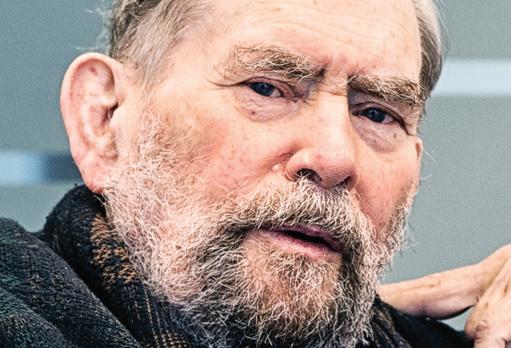
www.wits.ac.za/alumni/ obituaries
Sources: Web of Stories; The Nobel Prize; Nature; Science; The Lancet; The New York Times; The Guardian; Agency for Science, Technology and Research; BK Murray
Germiston Town Council allowed him to enrol at Wits aged 15 and covered his fees to study medicine – though this was not his main interest. He wanted to be a scientist, having been inspired by books in the public library and experiments he carried out at home.
Because he would have been too young to register as a doctor when he qualified, he took some time off from medicine to do a BSc, Honours and Master’s. This meant he no longer qualified for his bursary, so he worked as a laboratory technician at Wits while studying. He also played rugby and served as SRC president in 1950. His interests ranged from astronomy to geology and palaeontology, but his central passion was biochemistry. Influential Wits people in his life at this time included his lecturer Edward
Roux (BSc 1924, MSc 1927), a plant physiologist and communist; neuro anatomy student Harold Daitz (BSc 1943, BSc Hons 1944, MBBCh 1947); mathematician Seymour Papert (BA 1950, PhD 1953, DSc Eng honoris causa 2016); histology lecturers Joe Gillman (BSc 1929, BSc Hons 1930, MBBCh 1933, PhD 1940) and Alfred Oettle (BSc 1939, MBBCh 1943); microbiology student Joel Mandelstam (BSc 1940, BSc Hons 1941); Professor Raymond Dart and Professor Robert Broom. He published his first scientific paper in the journal Nature as an Honours student in 1945.
Eventually he did qualify in medicine, despite his lack of interest in clinical work, and lectured at Wits from 1954 to 1957.
Moving to the UK, US and ultimately Singapore, he enjoyed an illustrious career in molecular biology. He will mainly be remembered for his work on DNA and RNA with Francis Crick and his later work on the genes regulating organ development, for which he was honoured with a Nobel Prize in 2002. He worked to the end of his life and recently published a book of lectures, Sydney Brenner's 10-on-10: The Chronicles of Evolution
Dr Shawn Hoon, a researcher at the Agency for Science, Technology and Research in Singapore, summed him up well: “His boundless curiosity, dogged pursuit of knowledge and courage to speak with clarity on important issues with his characteristic wit are what we can aspire to.”
Brenner leaves two daughters and a son.
He donated a portion of his Nobel Prize to the Academy of Science of South Africa to fund an outstanding young scientist undertaking research in molecular biology. One of the recipients was Wits graduate Dr Samantha Barichievy.
(1938-2019)
Sources: Wits honorary degree citation; Goodman Gallery; Bag Factory Artists’ Studios; News365; Mail & Guardian
(1950-2019)
David Nthubu Koloane (DLitt honoris causa 2012) was one of South Africa’s most distinguished artists and sociocultural activists. He contributed to the art world and broader society as a leader, intellectual, writer, critic, educator, curator, consultant and administrator. He was also a role model and mentor to generations of South African artists.
Born in Alexandra township, he grew up in Orlando West in Soweto. In the 1970s he worked at the Bill Ainslie Studio, then co-founded The Gallery in Jeppestown and the Federated Union of Black Artists. Later he also helped establish the Bag Factory Artists’ Studios.
His work is included in most major collections in South Africa and later in 2019 the Wits Art Museum is to host an exhibition, A Resilient Visionary: Poetic Expressions of David Koloane (now on at the Iziko National Gallery). The main subject matter of his drawings, paintings and prints is black urban life.
The Goodman Gallery’s Liza Essers described him as a “soft-spoken, kind and generous person who always put his students and fellow artists first”. Standard Bank Gallery head curator Same Mdluli said “he was always willing to speak to young aspiring artists, giving them advice”.
Sources: Raymond Suttner, New Frame
(1947-2019)
Peter Hudson, a senior lecturer in Politics at Wits, was widely revered as a teacher and received the Vice-Chancellor’s Teaching Award in 2002. He was a meticulous, rigorous scholar who took no short cuts with any problem he confronted. He was continually growing, considering questions afresh and open to new influences, which he would consider in the careful, measured, deliberate way that characterised his research, writing and teaching.
Peter prepared his lectures, course
material or seminar inputs afresh every year. He would investigate the same topic he had taught repeatedly. Each presentation would be geared to whatever specific needs the audience required. He never saw his audiences as passive consumers of knowledge that he would impart. His mode of communication was an ongoing interaction through which he, too, would grow and change.
He leaves his wife Lesley and his son Dan.
Source: Leon Joffe
Many South African gardeners will know the gardening books of Pitta Joffe, who helped to popularise the use of indigenous plants in South African gardens and public spaces.
Born Hileen Rowe, she studied botany at Wits and graduated with a BSc in 1970. She also met her husband Leon Joffe (BSc Eng 1970, MSc Eng 1976) at Wits. She worked first at Kirstenbosch and later at the National Botanical Gardens
(now SANBI), which has her collection of 14000 slides of indigenous plants. A warm, optimistic and helpful person, she cared passionately for our natural surroundings and inheritance.
Pitta passed away in Pretoria in June after a 20-year battle with Huntingtons disease. She leaves her husband, their children Peta, Kevin, Tanya and David and four grandchildren.
(1936-2019)
Source: Louisa Douwes Dekker
(1960-2019)
Louis Charles George (“Loet”) Douwes Dekker (BA Hons 1963, MA 1981) was an internationally respected sociologist and labour relations activist.
He was born in Indonesia, where his father worked as a chemical engineer on the sugar plantations. Japan attacked Indonesia in 1941 and all Europeans were taken prisoner. Loet was six years old; for more than three years, he and his mother and sister Ena endured appalling conditions in Japanese camps, where many prisoners got sick and died. His other sister Marith had gone to school in the Netherlands. After the war, the family was reunited there. Loet once told his daughter Louisa how happy it made him just to be able to pick a flower or to eat when hungry, after his early years of misery and horror.
In 1949 they moved to South Africa, where his father was Director of the Sugar Milling Institute in Durban. Loet attended Durban High School and, despite having to learn English, got his matric in 1954 and then studied towards a BSc at the University of Natal. From 1957 to 1958 he worked as a laboratory assistant at Caltex and at the Sugar Milling Institute. He then decided to switch to social sciences at the University of Natal, and graduated in 1960.
In the 1960s he worked at the Institute for Social Research. It was during this time that he became interested in the plight of black South African workers. He was Assistant Secretary General of the Trade Union Council of South Africa, but his services were terminated in 1968 because of his campaign for the
recognition of black trade unions. He then served in the Industrial Clothing Council and the Medical Benefits Association for the Clothing Industry. Here he made a difference to the lives of thousands of young women who came from the countryside to work in the industry, where they were mostly paid a hunger wage and had no medical benefits.
Along with Eric and Jean Tyacke, he started the Urban Training Project in 1971. This was an educational body which supported independent trade unions by providing secretarial, organisational and other training. The apartheid government saw these activities as a threat and Loet was banned for five years under the Internal Security Act of 1976. He was watched by the security police and had to report every week to the local police station.
During this time he obtained his Master’s degree despite the restrictions on his movement. He was also, by then, a husband to Sally (Schlemmer) and father of three children.
In 1984 he led the establishment of the Independent Mediation Service of South Africa. In 1990 he was awarded a Professorship from the Wits Graduate School of Business Administration, where he taught industrial relations.
Loet lived his last years with his second wife Clara in Greyton, where he loved walking in the mountains. He also leaves his daughters Louisa and Sarah; his son Nicholas died in a car accident in 1990. He is remembered for his compassion, curiosity, intelligence, kindness, and love for South Africa.
Pule Godfrey Selepe (MM 2008) was director-general of the national Department of Transport, which he joined in 1999. In his previous role as chief director for Civil Aviation, he oversaw state-owned enterprises such as the Airports Company South Africa, Air Traffic & Navigation Services and the South African Civil Aviation Authority, and chaired the International Air Services Council. He died after a long illness.
Sources: Sunday World, SAnews.gov.za
(1929-2019)
Sources: Wits:The Open Years (Bruce Murray and Jonty Winch); SA Dental Journal
(1960-2019)
Christopher Constantine Rachanis (BA 1951, BSc 1954, BDS 1958) was born in Benoni and matriculated from Benoni High School. He served as President of the Wits SRC in 1955/6, a time when the apartheid government increased the pressure on universities and Wits students voted overwhelmingly in favour of “academic non-segregation”. He was also chairman of the All Sports Council from 1953 to 1956 and campaigned for the upgrading of sports facilities at Wits.
After graduating from Wits in arts, science and dentistry, he qualified with an MBBCh from Sheffield in the UK, followed by a Fellowship from the Royal College of Surgeons, Glasgow in 1971. He worked in the UK from 1960 and 1975 and
then joined Wits’ dental school, where he remained for 40 years.
Professor Bill Evans noted that Dr Rachanis held the record for being the oldest member of staff at the School of Oral Health Sciences: “old but still very sharp and erudite!”
He developed particular acumen in the management of HIV and was always happy to share his knowledge with students, even putting in extra hours of teaching. Former students have described him as an “absolute legend” and a gentleman: patient, courteous, gentle, caring, humble and committed.
His wife, Colleen, died a few years ago. He enjoyed his dogs, his garden, reading and computers.
Sources: UCT; judycroome.com; bericcroome.com
(1952-2019)
Beric Croome (HDip Tax Laws cum laude 1989) was an advocate and chartered accountant who specialised in tax law and was an occasional lecturer at Wits. He was the author of Taxpayers’ Rights in South Africa, which was also published for non-specialists as Street Smart Taxpayers . He often commented on tax issues in the press and wrote columns for various publications. In 2002 he was
nominated for Wits Convocation’s Honour Award for his contribution to commerce and industry.
He was an executive at the firm ENSafrica and served on committees of the SA Institute of Chartered Accountants and the SA Institute of Tax Practitioners. He died of cancer in April, leaving his wife Judy.
Source: Kathy Munro
Sidney Robert Stephen Lucas (BCom 1975) passed away in Melbourne, Australia, from brain cancer. After graduating at Wits, serving articles and qualifying as a chartered accountant, he completed a year of compulsory military service before leaving for the UK and then Australia.
He was involved in charitable work with the elderly and disabled, and was keenly interested in the natural environment. He collected veteran cars, an interest that
required mechanical skills.
His sister Katherine Munro describes him as quiet and reserved, with a great sense of humour; “someone of huge integrity; the ultimate accountant’s accountant; upright, honest and compassionate”.
He was married first to Louise Lello and then to Bonnie Gelman and is also survived by his stepson Felix and daughters Nicole and Bianca.
(1940-2019)
Source: Craig Pournara, Director, Marang Centre for Maths and Science Education
(1926-2019)

Professor Paul Laridon’s remarkable contribution to mathematics education in South Africa was driven through his work at Wits, his involvement in the formulation and revision of school curricula and his tireless work through professional mathematics associations.
At Wits, Paul first taught undergraduate mathematics courses but his passion for mathematics education was fuelled by teaching mathematics methodology courses to pre-service secondary mathematics teachers. Many of those now working in maths education at the University owe a great deal to the pioneering work of this NRF-rated scholar.
In the 1980s he was instrumental in developing an Honours course in maths
teaching which drew many experienced teachers back into Wits. In the late 1990s and early 2000s he was part of the team that reconceptualised this programme, attracting many new cohorts of teachers. His many Master’s and PhD students benefited immensely from his breadth of knowledge of mathematics education locally and internationally. He was a member of the team who won the Vice-Chancellor’s Award for Academic Citizenship in 2003.
When it gave him honorary membership in 2000, the Association for Mathematics Education of South Africa called him an “approachable, generous and humble man”.
He is survived by his daughter.
Source: Department of Surgery; Marie Lawson
Professor Emeritus Hugh Hill “Buddy” Lawson (BSc 1948, MBBCh 1951, MMed 1964) died after a long illness on 14 March 2019. A Fellow of the Royal College of Surgeons, he worked at many of the hospitals associated with Wits and was appointed Professor of Surgery and Chief Surgeon at [Chris Hani] Baragwanath Hospital in 1971, retiring from the position in 2000.
Fellow Wits surgeon Professor Julien Oettle notes that Prof Lawson “facilitated [Bara’s] steady development from little more than a vast dressing-station into a world-class academic institution. [The hospital’s] reputation, the present specialist units and the international respect in which they are held are all a tribute to his devotion to clinical practice.”
He was acknowledged as a great teacher and clinician and his research resulted in his international recognition in his field (peptic ulceration). He was president of the South African Surgical Research Society in 1989-90.
Prof Oettle recalls that he was “hard-working, friendly, one who led by consensus and persuasion rather than domination and force. He gave a real sense of the continuity of surgical tradition, where not merely operative technique but attitudes, values and approach were all passed on through long apprenticeship.”
His wife Marie describes him as a “quiet, humble man with a gentle sense of humour that in so many cases managed to diffuse tense situations”. She says “nothing gave him more pleasure than to see one of his students achieving great success”.
He was also a skilled cabinetmaker, a hobby in which he applied passion and care. “He grew old accepting the limitations with such grace,” says Marie. “Simple pleasures like our evening walk in the park with the dogs were a highlight in his retirement years, and enjoying the company of the children or old friends.”
Prof Lawson leaves his wife and four children.
(1929-2018 )
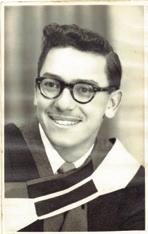
Source: Dr Serle Levin
(1926-2019)
Pioneering paediatrician Aaron Reuben Levin (BSc 1949, MBBCh 1953, PhD 1969) matriculated from Vereeniging High School at the age of 15 and started at Wits among much older classmates, many of whom had returned from service in World War II. He completed his internship at Edenvale Hospital and his registrarship at Coronation Hospital, became a member of the Royal College of Physicians in Edinburgh and worked at Charing Cross Hospital in London before returning to private practice in Johannesburg.
In 1963, Dr Levin emigrated to the United States with his wife, Dr Lenore Zhita Gladstone (MBBCh 1956), and three young children. At Duke University he began to develop his interest in
helping children with congenital heart disease, and pioneered techniques for diagnostic and palliative catheterisation. He became Professor of Pediatric Cardiology at Cornell University Medical College and Professor at New York Medical College, and served as consultant for 20 years before retiring from medicine at the age of 85. He was a Fellow of the American College of Cardiology and of the Royal College of Physicians.
Dr Levin is survived by his wife of 63 years, Lenore, and his children Sheryl, Terry and Serle. He was in the faculty procession, wearing his Wits gown and hoods, when each of his children graduated from Cornell University Medical School.
Sources: Rochelle Keene, Professor Emeritus Cedric Bremner
Victor Eugene Pollak was an international leader in academic internal medicine and nephrology and an expert in renal biopsy. He was widely known as a physician, teacher, investigator and administrator and had an illustrious career in academic medicine in the USA. He was Professor Emeritus of Internal Medicine at the University of Cincinnati, and Professor of Clinical Medicine at the University of Colorado.
Dr Pollak graduated BA (1945) and MBBCh (1950) at Wits. He completed his internship at the Johannesburg General and Baragwanath Hospitals in surgery under Alexander Lee McGregor from 1951 to 1952. He then went to England, where he worked as a house officer with several excellent physicians.
After obtaining membership in the Royal College of Physicians, Edinburgh, he joined the distinguished group of researchers at the University of Illinois College of Medicine in Chicago in 1954, headed by another South African, Dr Robert Kark.
Reflecting on medical education
at Wits, he once wrote: “Learning by example in Johannesburg, we saw the benefits of cooperation and teamwork: cooperation between physician and surgeon, between physician and nurse, between physician and dietician. Most important to some of us was the Health Centre at Pholela, where we learned a team approach for the welfare of the population and of the patient.”
Dr Pollak was a pioneer in the practical application of medical informatics to clinical practice. His provocative article, ‘The Computer in Medicine: Its Application to Medical Practice, Quality Control, and Cost Containment,’ was published in the Journal of the American Medical Association in 1985.
With John P Flynn he was a founder and from 1995 he was Senior Vice-President and Medical Director of MIQS, Inc, in Boulder, Colorado. The company was formed in 1990 to create a new electronic medical records product that fully exploited the recent advances in computer technology.
(1943-2018)
Source: Dalia Cohen
(1926-2019)
Dr Eric Cohen (MBBCh 1966) did his internship at Baragwanath Hospital, specialised as a physician and worked for a time at the Johannesburg General Hospital. In 1972 he moved to Zimbabwe, where he went into private practice and worked at the Mater Dei Hospital, ultimately becoming medical director and chairman of the board. He was instrumental in establishing an intensive care unit there. He also taught at United Bulawayo Group of Hospitals and the Richard Morris Hospital, and served the National Cancer Association and the Zimbabwe Medical Association. He was a fellow of the Institute of Directors of Zimbabwe and of the United Kingdom and a member of the New York Academy
of Science and the Royal Society of Medicine.
Eric never turned away a patient who could not pay and often sponsored their medications. Remembered for his brilliance, wit and eloquence, he also offered empathy, wisdom and friendship to families suffering with a loved one. He leaves a far-reaching legacy built upon a life rich with love and meaning.
A voracious reader with a passion for Shakespeare, Eric maintained a keen interest in world events. Socially, he played cricket, tennis and chess. Married to Valda (Baron) for 53 years, he was an involved father to Graham and Dalia, and relished his role as grandfather.
Sources: Sunday Times, Press Council of South Africa, PEN SA, SANEF, Wits University honorary degree citation, The Conversation
Wits honoured Raymond Louw with the degree of DLitt honoris causa in 2015 for his “unstinting service to journalism and the fight for free expression and unwavering opposition to censorship”.
Louw started as a reporter on the Rand Daily Mail in 1946 and was editor from 1966 to 1976 (and then general manager of SAAN). His leadership of the Infogate investigation helped to bring down Prime Minister John Vorster. He was known as a demanding but fair and loyal editor and he increased the title’s circulation while using it to take a stance against apartheid.
He helped to found the Campaign for Open Media, served on the Independent Electoral Commission’s media oversight committee ahead of the 1994 elections, and was a founder member of the SA National Editors’ Forum, a member of the
Freedom of Expression Institute, deputy chair of the Media Institute of Southern Africa, Vice-President of PEN South Africa, chair of the Press Council of SA and chair of New Era Schools Trust. He and his wife Jean published the Southern African Report weekly for 28 years and he was involved in initiatives to train journalists. In 2011 the International Press Institute named him as a World Press Freedom Hero.
He died in hospital aged 93, just hours after hearing that Jean had died. They leave their son Derek and daughter Fiona; their son Alistair died in 1998.
Wits Journalism’s Professor Anton Harber said his legacy was one that “has us thinking how much more we can do with our time and our resources and the balance between our public and our private lives.”
Errata: In our tribute to Tom Bourquin ( Wits Review April 2019), we incorrectly named his surviving son as Peter; he is in fact Roger. We also named Steyn Krige as the first headmaster of St Stithians; in fact the founding head was Wally Mears. We regret the errors.
Professor Lorna Barbara Jacklin Paterson (MBBCh 1973; MSc Med 1998) was a giant in the field of paediatric neurodevelopment and a champion of children with special needs as well as the abused.
secure it as a base for various children’s non-profit organisations, such as the Teddy Bear Clinic. It is now known as the Children’s Memorial Institute. She also set up eight NPOs herself during the course of her career.
Source: Wits School of Clinical Medicine
She grew up on a farm and was head girl of Krugersdorp High School in 1967. After her undergraduate medical training at Wits she specialised at the University of Pretoria and then spent some time in the UK working in developmental screening and assessment of children. She started working at [Chris Hani] Baragwanath Hospital in 1983 and established the toy library there. In 1986 she was transferred to the then Transvaal Memorial Institute for Child Health and Development. Later, when the TMI building was left empty, she managed to
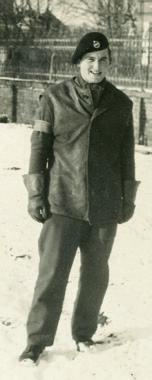
Source: William Martinson
Michael John Martinson (BSc Eng 1953, LLB 1961) was born in Belfast, Northern Ireland and attended boarding school in Edinburgh. He volunteered for the armed forces aged 15 and joined the Royal Tank Corps. His tank crew crossed the Channel on D-Day+12, in a craft from which his tank drove onto the beach at Normandy. After the Allies’ victory in Europe, he was selected for an officers’ training course, which he completed in India.
Aged only 21 when he was demobilised, he could not find a place at a university in England but found a job at the Tarkwa and Obuasi gold mine in what is now Ghana, and was then accepted at Wits to study mining engineering.
At the ex-servicemen’s residence, Cottesloe, he made lifelong friends. He joined the Wits Rowing Club and was selected to represent South Africa at the Helsinki Games in 1952, but was disqualified on the grounds of having a
In 1995 she became a principal specialist at the then Johannesburg General Hospital (now Charlotte Maxeke Johannesburg Academic Hospital) and worked there as a paediatrician until her retirement in 2015. Her work with the Children’s Disability Centre led to the establishment of the Johannesburg Hospital School of Autism. In retirement, she continued to challenge, encourage and mentor people who now carry forward her legacy.
Prof Jacklin leaves her husband Tony, son Craig and daughter Jackie.
British passport. He remained a keen member of the Viking Rowing Club in Johannesburg.
During university holidays he worked underground at Crown Mines as a mine surveyor, an experience that influenced his decision to enrol for a part-time LLB. He worked at Anglo Vaal, Rand Mines and Wits’ Mining Engineering Department, and became an expert witness in mine accident inquiries. Justice Edwin Cameron recalled of their work together in the 1980s and early 1990s that “he gave his rich expertise generously to the mineworkers who needed it”.
Mike was married to Annemarie (Marx) and they had four children: Heather, Bruce, William and Neil. His interests included choral music, flying, Africana and indigenous plants. He is remembered for the value he placed on gratitude, courtesy, sharing, courage, logic and good cheer.
(1922-2018)
Sources: McGill University; The Globe & Mail; British Medical Journal; Sharon Fonn; Gill Nelson
Margaret (Margot) Rigsby Becklake
McGregor (MBBCh 1945, DMed honoris causa 1974) was Emerita Professor in Epidemiology, Biostatistics and Occupational Health at McGill University in Canada. She was an exceptional teacher, mentor, philosopher and ethicist, internationally renowned in the field of respiratory medicine and epidemiology.
She was the first to demonstrate that exposure to dust inhalation (in gold mining, for example) could lead to chronic obstructive pulmonary disease. This link made it possible for workers to claim compensation for the illness. Before then, silicosis was the only occupational disease for which miners could claim compensation.
As Canada’s Globe and Mail put it: “Her work helped to change lives and our understanding of exactly what happens to our bodies when exposed to foreign substances.”
She was born in London but came to South Africa at a young age. She was head girl of Pretoria Girls’ High School and enrolled at Wits aged 16. After graduating, she did a postgraduate degree in London, where she met her future husband, Maurice McGregor.
Back in South Africa, she worked as a physiologist at the Pneumoconiosis Bureau, where she had access to the medical records of half a million gold miners. She published her first research
(1973-2019)
paper in 1948 and her last in 2010.
When Maurice accepted a position as a cardiologist at McGill University in 1957, he and Margot emigrated to Canada. There, Margot worked in the Departments of Medicine and Epidemiology at McGill and at the Montréal Chest Hospital and the Royal Victoria Hospital.
On a sabbatical in South Africa at the newly formed Epidemiology Unit at the National Centre for Occupational Health (now the National Institute for Occupational Health), she mentored several young scientists, including Danuta Kielkowski, Freddy Sitas and Gill Nelson. From Canada she also contributed to African science and medicine by guiding graduate students, collaborating with researchers, visiting as a teacher and assisting with the publication of papers. She received many awards, including the Order of Canada.
Described in tributes as caring, energetic, positive, encouraging, poised, confident, charming and intellectually demanding, she challenged dogma and did what she felt was right; she was “a fearless advocate for workers”.
She died aged 96, leaving her husband, former McGill Dean of Medicine and fellow Witsie Dr Maurice McGregor (MBBCh 1943, DMed honoris causa 1974), her children James and Margaret and their families.
Kamal Bhagwandas Jogibhai contributed in many ways to Wits as an administrative staff member in the Quality and Academic Planning Office and as a researcher in the Development and Fundraising Office. In his time at the University he obtained five qualifications: BA 1997, BA Hons 1998 (archaeology), MEd 2012 (on academic freedom, institutional autonomy and public accountability), and postgraduate diplomas in arts and in business administration. He was also close to obtaining a postgraduate diploma in Higher Education at the time of his death.

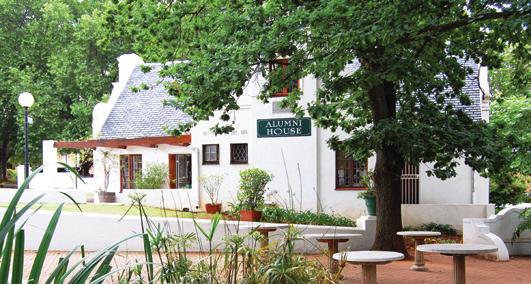
 The Be Careful Pop-up Book. If You Look Hard Enough You Can See Your Future, Stephen Hobbs (book artist), Ingrid Schindall (conceptualised by)
David Krut Projects (2013)
In the Jack Ginsberg Centre for Book Arts at Wits Art Museum
The Be Careful Pop-up Book. If You Look Hard Enough You Can See Your Future, Stephen Hobbs (book artist), Ingrid Schindall (conceptualised by)
David Krut Projects (2013)
In the Jack Ginsberg Centre for Book Arts at Wits Art Museum